Early Los Angeles Gas Stations
| Historical Photos of Early LA Gas Stations |
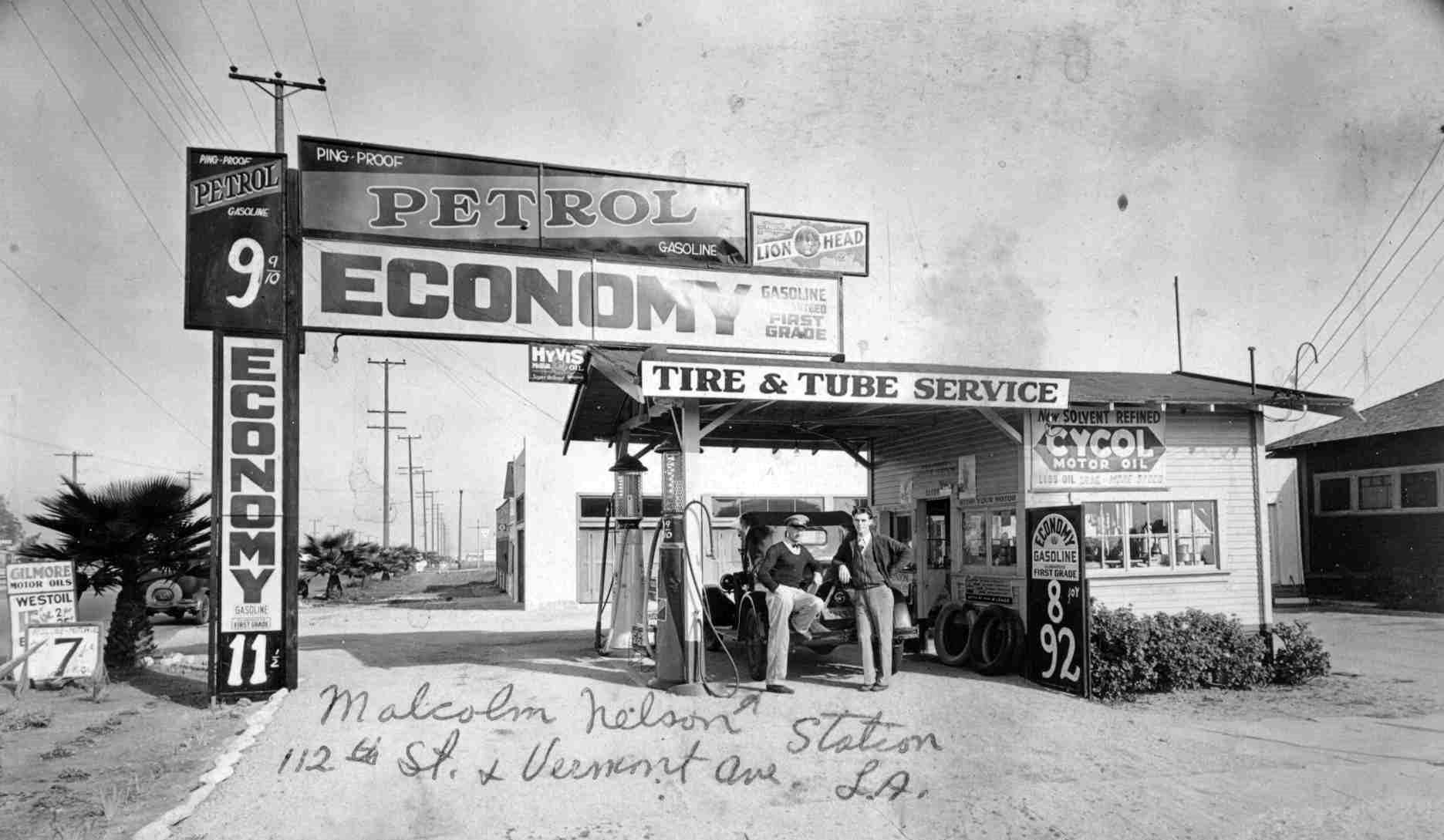 |
|
| (1930s)* – Two men are seen posing in front of an early model car at a gas station. Writing on photo reads: Malcolm Nelson Station, 112th St & Vermont Ave. Note the gas prices: 9¢ and 11¢ per gallon! Photo courtesy of Alex Magdaleno |
Historical Notes As automobile sales increased, the demand for fuel led to a more systematic way of delivering it, and in 1914 Standard Oil of California opened a chain of 34 homogeneous stations along the West Coast. Major oil companies moved quickly to secure their own gas dealers, made possible by technical advances in gasoline pumps. Soon pumps were being installed not only at the new service stations, but in front of hardware stores, feed companies, livery stables, and a variety of other retailers. Super service stations were important elaborations of the original filling stations. Introduced in Los Angeles prior to World War I, super service stations combined operations that had been handled separately. Before that time, a motorist went one place for gas and oil, and other places for lubrication and cleaning, for repairs, or for tires and other accessories. Combining these activities was convenient for consumers and opened up new marketing possibilities for those interested in taking advantage of the boom in automobiles. The earliest known super service station—Service Town—was built in 1914, three miles from downtown Los Angeles. Several of these stations were constructed in southern California in the early 1920s and soon spread across the country. |
* * * * * |
Violet Ray and Associated Gasoline
.jpg) |
|
| (ca. 1928)*^ – A man and boy sit in a car at the Central Service Station which is selling both Violet Ray Gasoline and Associated Gasoline. Note the dog sitting on top of what appears to be an oil dispenser (center of photo). |
Historical Notes Violet Ray Gasoline was a unique type of gas introduced in 1928 by the General Petroleum Corporation. What made this fuel special was its violet color. General Petroleum wanted to market a superior anti-knock product which would fulfill all the requirements of high-compression type engines, as well as function perfectly in all other types of motors. It was developed in a violet color that would change if it was exposed to any inferior motor fuel. Associated Oil Company was founded in 1901 and headquartered in San Francisco. It served much of the Pacific West Coast, including Hawaii, as well as the Orient and merged with the Tidewater Oil Company in 1938. |
* * * * * |
Whitsett Service Station (North Hollywood)
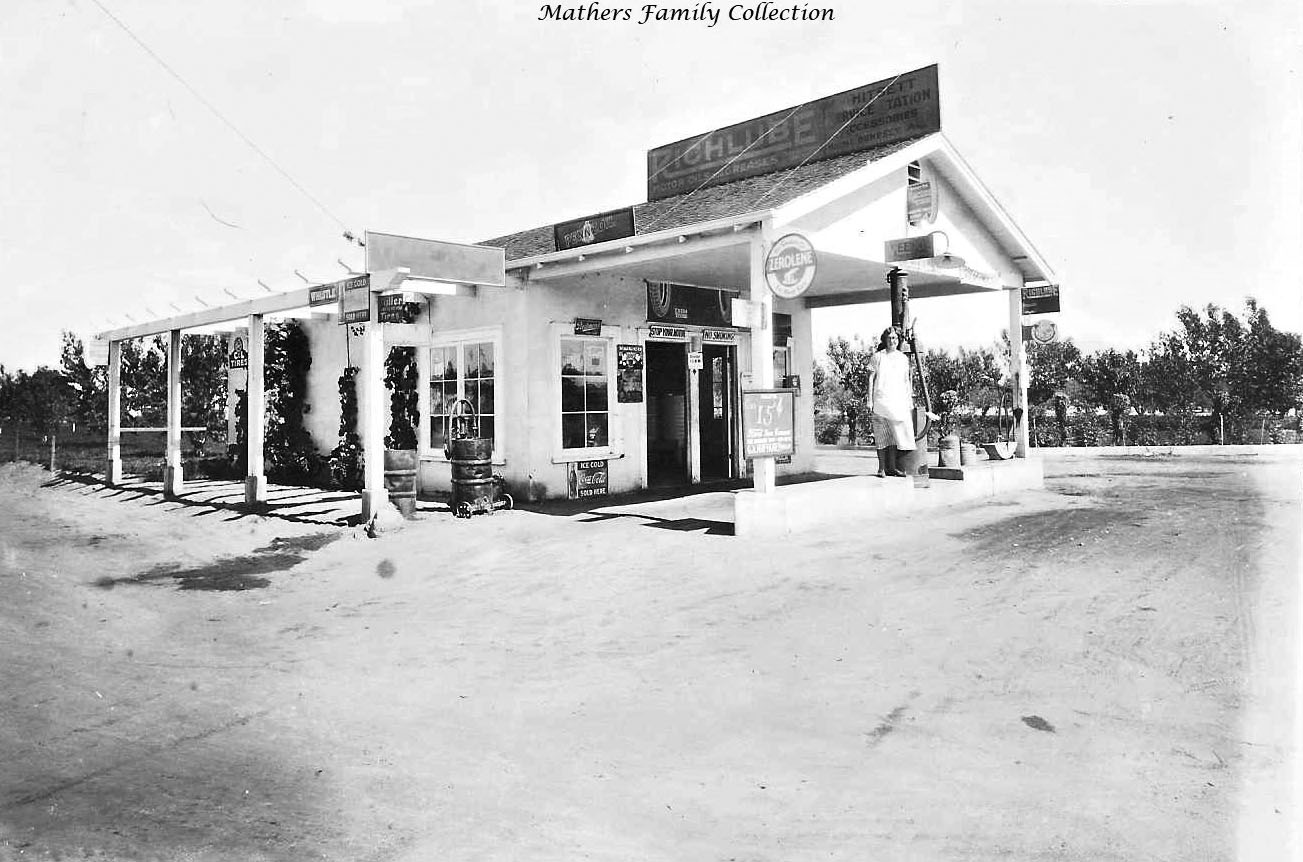 |
|
| (1923)^.^ – View showing Mabel Demspey standing on the gas pump island at the Whitsett Service Station located at 2912 Whitsett Avenue in North Hollywood. Sign above reads: RICHLUBE MOTOR OIL & GREASES |
Historical Notes Leland and Mabel Dempsey came from Kansas to Van Nuys in 1921 and opened the Whitsett Service Station at 4912 Whitsett Ave. When Leland passed away in November 1922, Mabel continued to run the service station by herself. She then married Frank Mathers, and by 1930 had moved the Richfield station to the corner of Chandler Blvd and Hermitage Ave. |
* * * * * |
Richfield, General, & Gilmore Gasoline
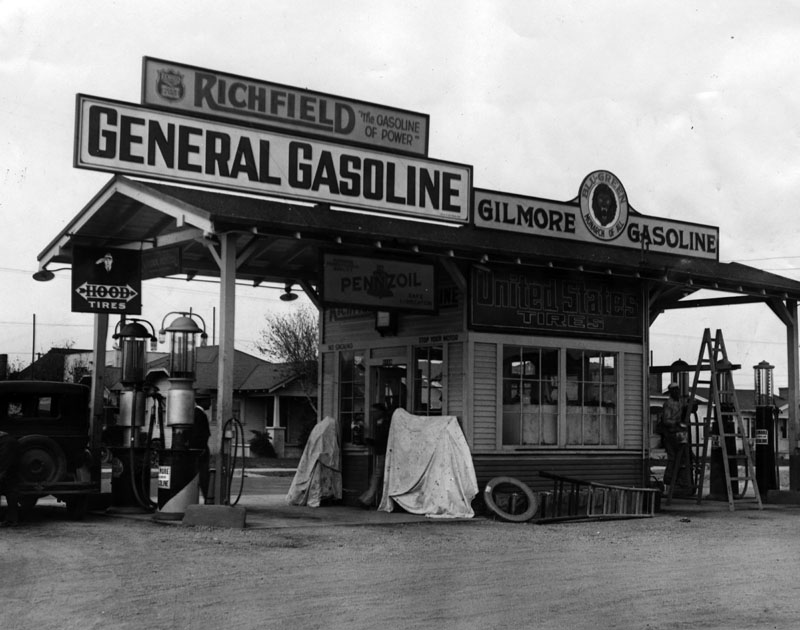 |
|
| (1928)^ - View of service station with gas pumps on either side located at 1800 1/2 Long Beach Boulevard, South Gate. The signs advertise General Gasoline, Richfield Gasoline, Gilmore Gasoline, Hood Tires, United States Tires and Pennzoil. On the right, an attendant is climbing a ladder. |
Historical Notes Architect Robert Venturi has called the gas station one of the world's first examples of a "decorated shed." A decorated shed is the opposite of a building designed to look beautiful, such as a cathedral. It is a building with this main architectural purpose: to be a backdrop for a sign that advertises what is sold inside. On any commercial strip, signs are what first catch the eye, not usually the design of the buildings.^* |
* * * * * |
Gilmore Gas Station (La Brea and Wilshire)
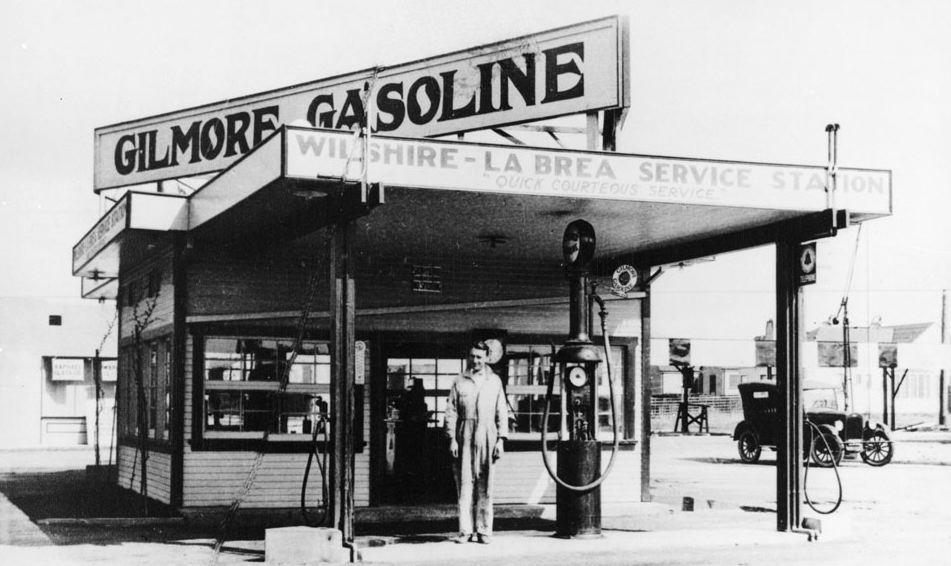 |
|
| (1920s)^^ - The Gilmore Gas Station was one of the first gas stations in Los Angeles. Located on the NE corner of La Brea and Wilshire Blvd. |
Historical Notes Today, you can find a replica of a gas station modeled after a 1936 era Gilmore Gas Station at Farmers Market. The 1936 replica and the one shown above are very similar. The station was put in place when the Grove Shopping Center was constructed adjacent to Farmers Market in 2002. In 1929, this Gilmore station was torn down to make room for the E. Clem Wilson Building. |
* * * * * |
Gilmore Gas Station
.jpg) |
|
| (ca. 1923)**^ – View showing Sam Drucker in front of his service station at Annandale Boulevard and Rockdale Avenue in Los Angeles. Signs appear throughout including: Gilmore Gasoline, Aristo (Union Oil of California), as well as the Firestone and Diamond Tires. |
Historical Notes Annandale Boulevard is now part of N. Figueroa Boulevard. |
* * * * * |
The Oil Well Service Sation
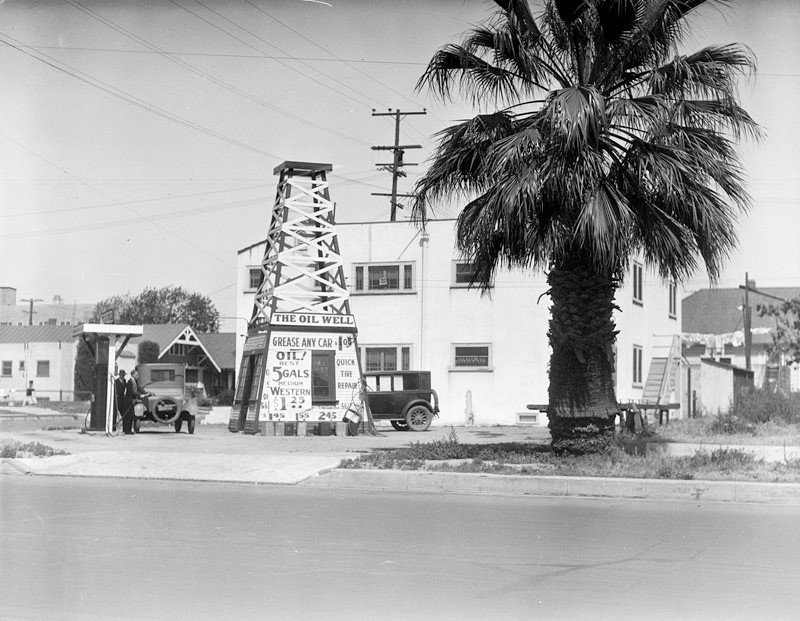 |
|
| (1920s)^ - The Oil Well service station shaped like an oil derrick, next to a palm tree and a two-story apartment building in Los Angeles. |
Historical Notes In the 1920s and 1930s, as the automobile was becoming the default way to get around the Southland, buildings and structures in the area became more unique. These “hey-you-can’t miss-me!” buildings (referred to as Novelty or Programmatic Architecture) were made to pull automobile drivers right off the road. Click HERE to see more examples of Programmatic Architecture. |
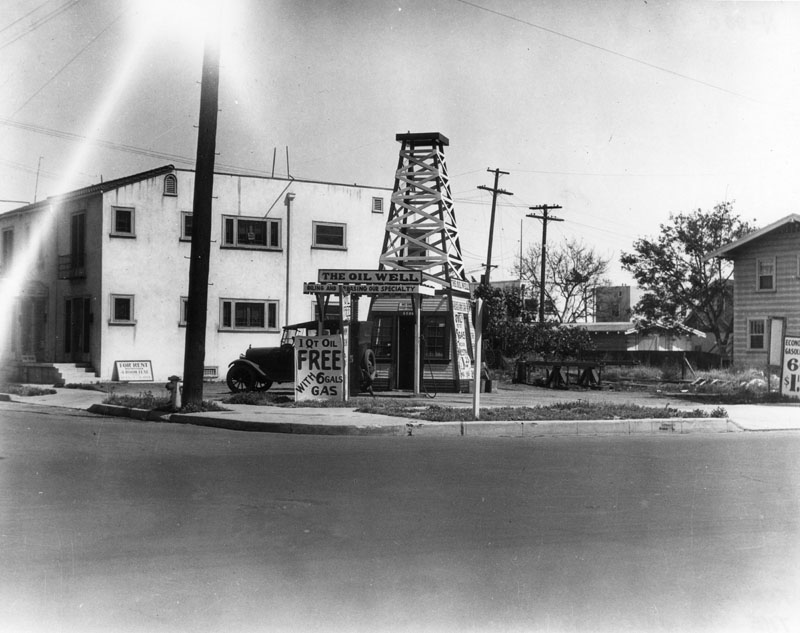 |
|
| (1920s)^ - View showing The Oil Well service station offering 1 qt. oil, free, with 6 gallons of gas. |
* * * * * |
Standard Service Station
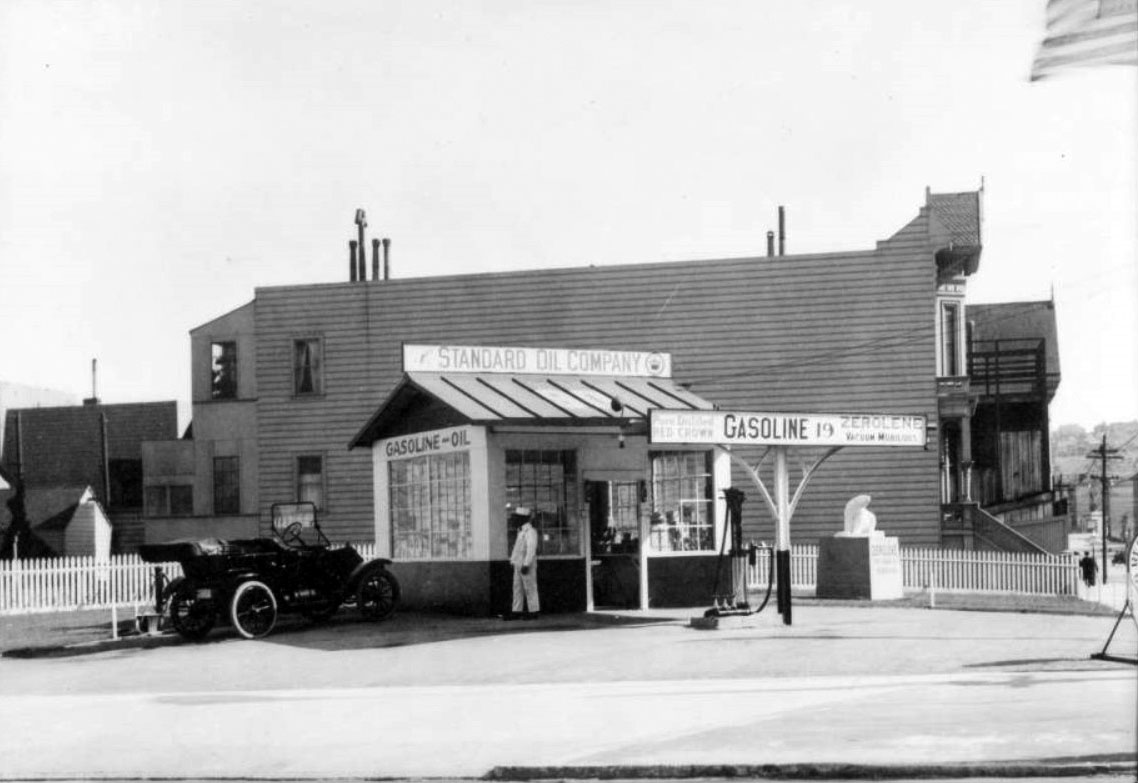 |
|
| (1920s)^^ – View showing a corner Standard Service Station with a single pump located at 3046 Crenshaw Boulevard (?). An early model car is parked on the left. On the right can be seen a statue of a white polar bear, which was the symbol for Zerolene, “The Standard Oil for Motor Cars”. Signage above the pump reads: “Pure Distilled Red Crown” Gasoline - “Zerolene Vacuum Mobiloils” |
Historical Notes Zerolene Motor Oil was made by the Standard Oil Company, similar to Polarine even down to the polar bear on the ads. |
.jpg) |
|
| (1920s)* – Closer view of what appears to be the same Standard Service Station as seen in previous photo. However, if you look closely, this station has two gas pumps and the building is positioned at a different angle on the lot. Also, there is no polar bear statue in this image. |
* * * * * |
California-Eastern Gas Station (Melrose and Wilton)
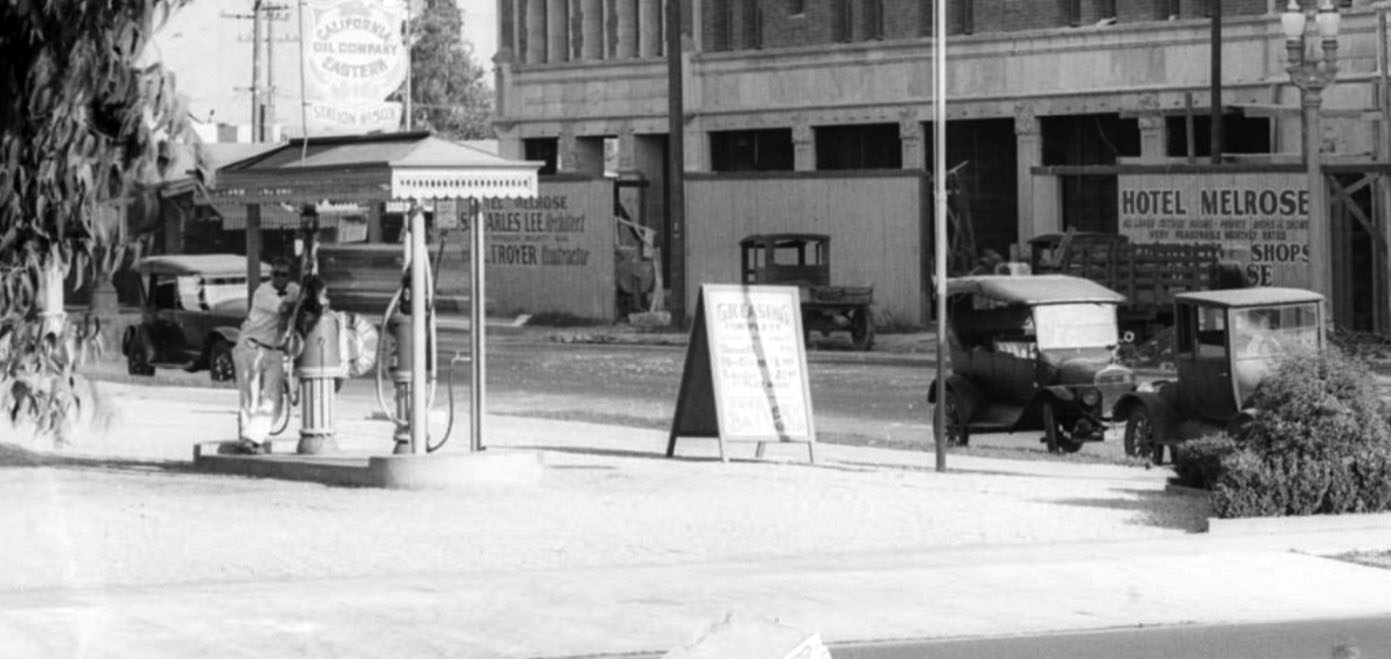 |
|
| (1927)* – View showing a California-Eastern Oil Company Gas Station on the NE corner of Melrose Ave and Wilton Place with the Hotel Melrose seen across the street in the background. Note the cool gas station attendant wearing the sun glasses. Click HERE to see contemporary view. |
* * * * * |
El Patio Auto Laundry and Gas Station
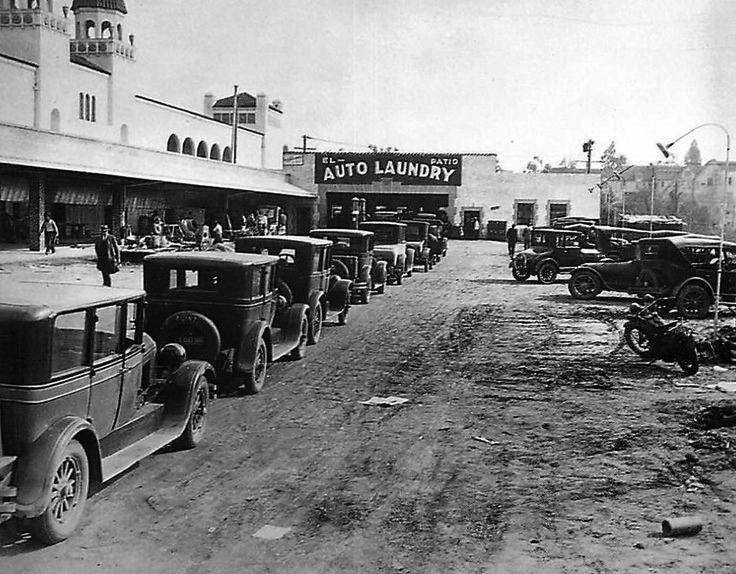 |
|
| (ca. 1927)* – View showing cars lined up at the El Patio Auto Laundry and Gas Station, located at the rear of 260 S. Vermont Avenue. The large building with the ornate towers on the left is the El Patio Ballroom (later the Rainbow Gardens). |
Historical Notes Some writers have claimed that this is the first car wash ever built, but not sure if this is correct. The El Patio, owned by B.K. Gillespie, may have been the most influential of the early car washes, and Gillespie is credited with coming up with the super service station concept. |
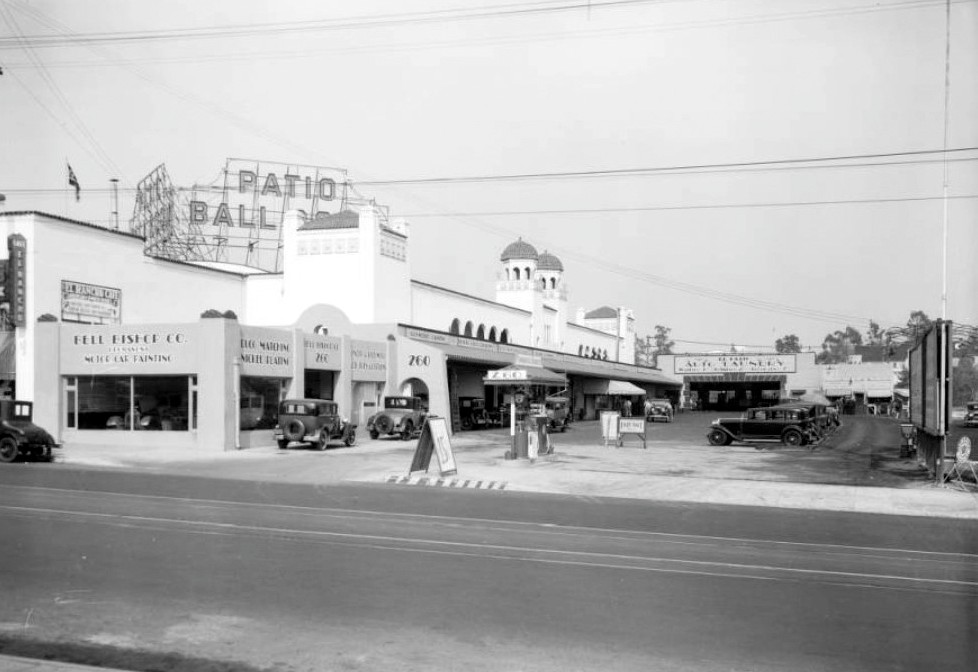 |
|
| (1930)* – View showing the El Patio Auto Laundry and Gas Station as seen from across Vermont Ave. A large sign reading “Patio Ballroom” is seen on the left. |
Historical Notes By 1928, Gillespie and other investors began opening a chain of super centers under the Gillespie Automobile Laundry System name which included a gas station. One of these early backers was Will Hays, a cleaner of motion picture content. Some sources suggest it may have been one of the earliest car washes, though its claim as the "first" is debated. The Whitsett Service Station (1921) in North Hollywood at 2912 Whitsett Avenue also offered early car care services, though it wasn’t a dedicated car wash. |
* * * * * |
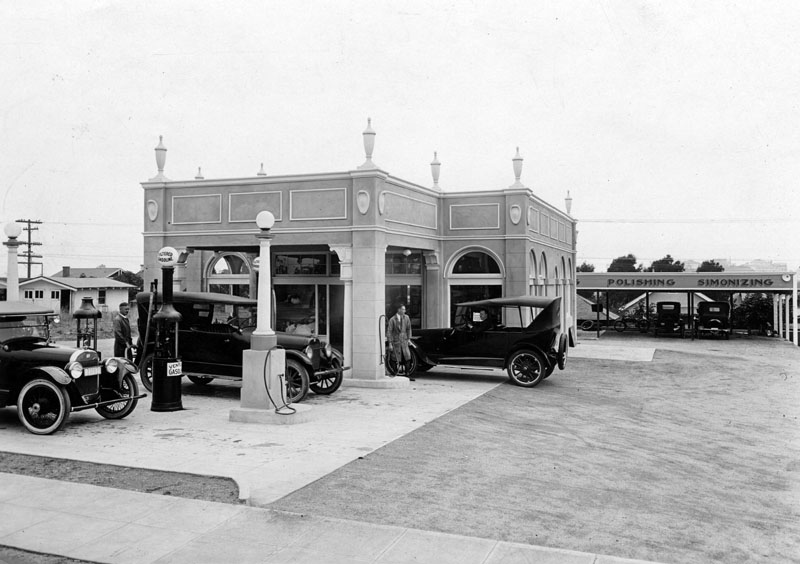 |
|
| (ca. 1920s)^ - Service station on north Vermont Avenue shows three automobiles parked next to the gas pumps as two attendants fill them up with "filtered gasoline". Other services such as polishing and simonizing are offered at this station, possibly named "Ventura Gasoline". |
* * * * * |
Pan Gas Service Station
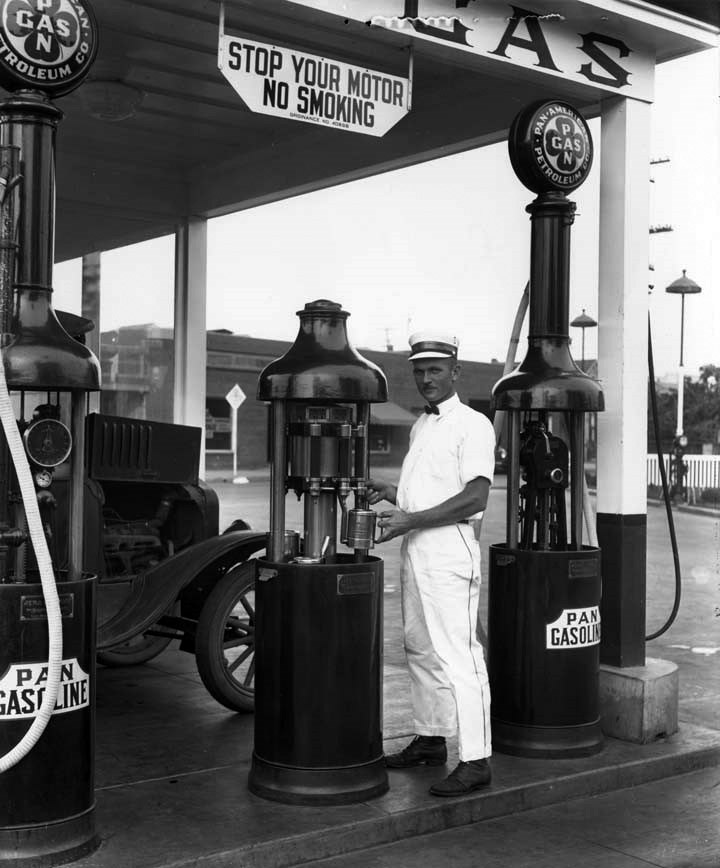 |
|
| (1920s)* – View showing a Pan Gas Service Station where an attendant is seen filling an oil can and posing for the camera. |
* * * * * |
Standard Gas Station
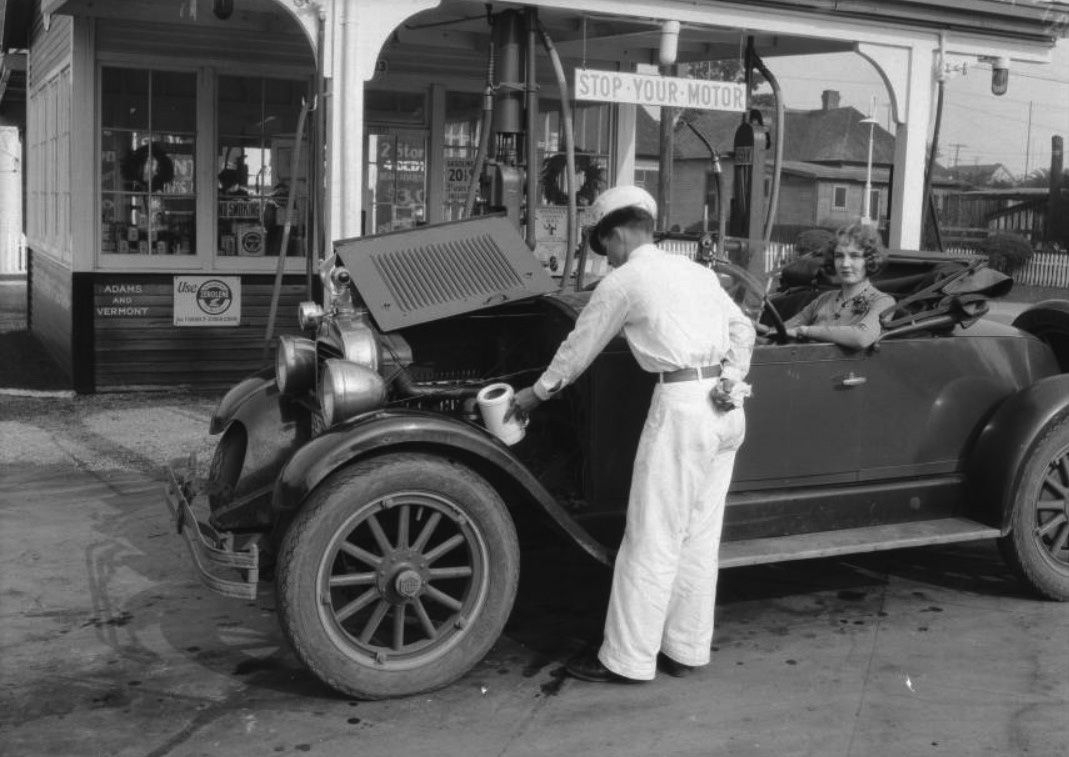 |
|
| (1928)* – View showing an attendant topping off the oil at a Standard Station on the corner of Adams & Vermont as a woman behind the wheel looks on. |
Historical Notes Gas Stations used to be called service stations ... they would rush to your car, check the water and oil, put air in your tires, wash your windows, and pump your gas. |
 |
|
| (1928)^^ – Service with a smile at a Standard Station located at S. Figueroa St. and W. 30th St. in Los Angeles. The woman behind the wheel is the same woman seen in previous photo at a different station in what appears to be a promotional shot. |
* * * * * |
Ventura Oil & Gas Station
 |
|
| (ca. 1929) – Joseph Kopietz with wife (Elizabeth) and son (Fred) stand at a Ventura Gas and Oil service station located on Colorado Blvd. and ‘...inia’ (showing on the curb) in Eagle Rock. This is puported to be the first gas station in Eagle Rock, later becoming a Texaco station. Photo courtesy of Joe Chatham, grandson of Fred Kopietz |
Historical Notes The petroleum exploration company California-Ventura Oil incorporated in 1927 with capitalization of $500,000. By 1929, the venture had several working drilling rigs when lightning sparked the “Sulphur Mountain Fire,” which destroyed the derricks. As the Great Depression began, California-Ventura Oil Company discovered the Hermosa Beach oilfield. The newly revealed field proved to be a key addition to the prolific Torrance oilfield, discovered a decade earlier.* |
* * * * * |
Texaco Gas Station (Avalon and Slauson)
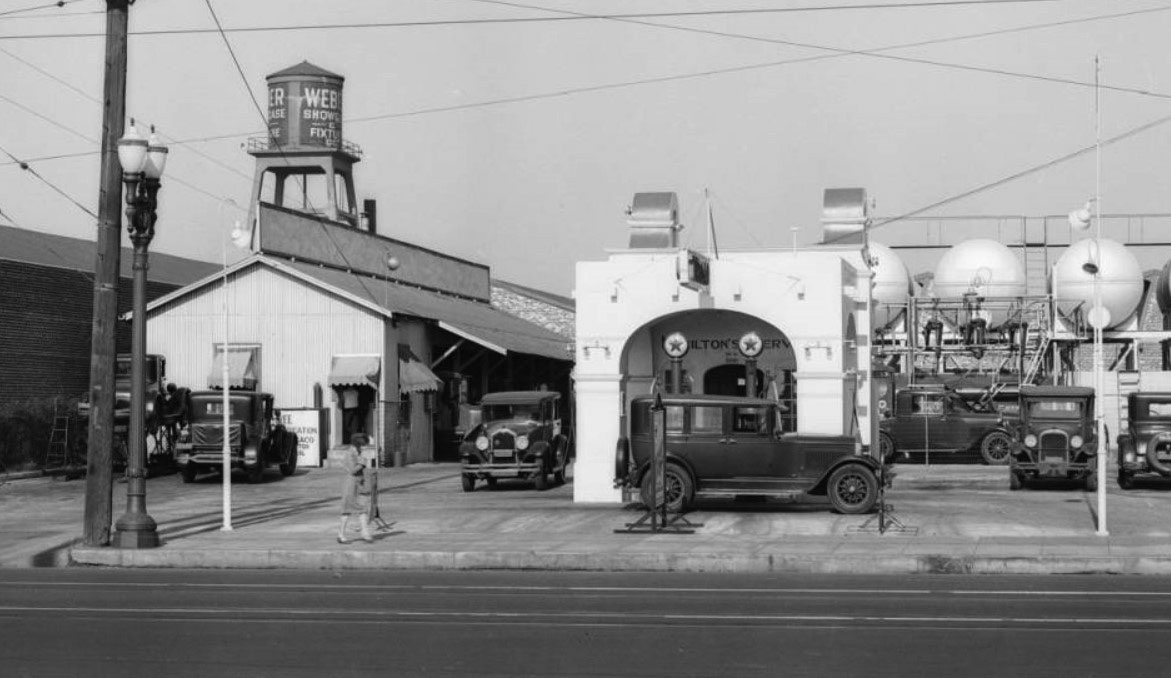 |
|
| (1928)^^ – View showing Hamilton's Texaco Gas Station located on South Avalon Boulevard near East Slauson Avenue, Los Angeles. |
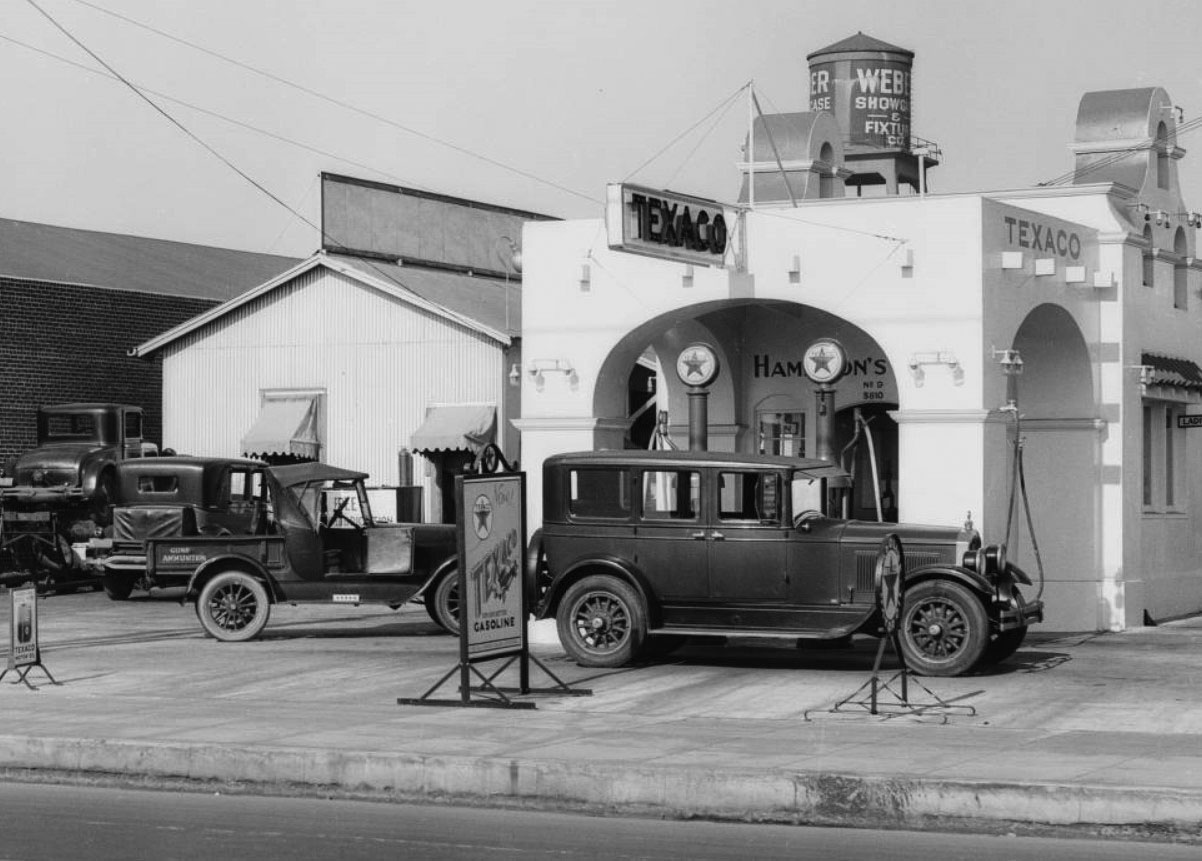 |
|
| (1928)^^ - Close-up view of the Hamilton’s Texaco Service Station located on South Avalon Boulevard. |
* * * * * |
Richfield Service Station
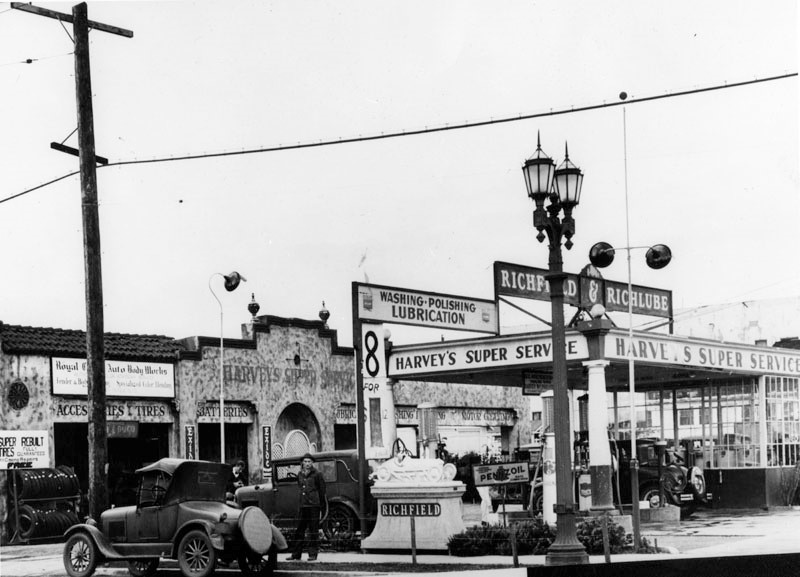 |
|
| (ca. 1928)^ - View of Harvey's Super Service Richfield Station located in Hollywood. Sign reads: ‘8 gallons for $1’. Notice the sculpture right out in front of the station. |
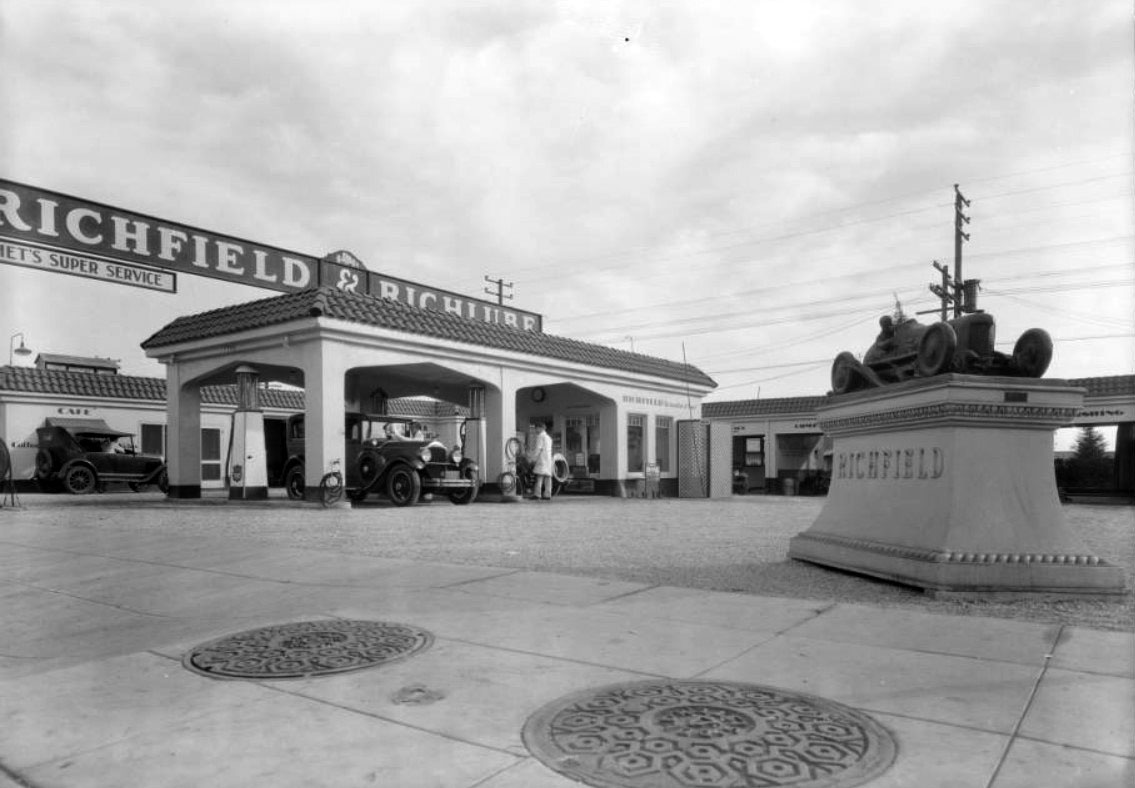 |
|
| (1929)^^ – Richfield Service Station at 7786 Santa Monica Boulevard, West Hollywood. Note the pedestal-mounted racecar on the right. |
Historical Notes Richfield was established in 1915 by the merger of two small oil companies in Los Angeles, CA. They entered a competitive marketplace that was dominated by Standard, Shell, Associated and Union. One of the ways that they chose to compete was to develop a more powerful gasoline. They were able to develop a gasoline with an octane rating of 75 which at that time was quite high. To promote this more powerful gasoline they offered it to race car drivers around the LA area and by 1921 they were supplying their products for the racers at the Indianapolis 500.** |
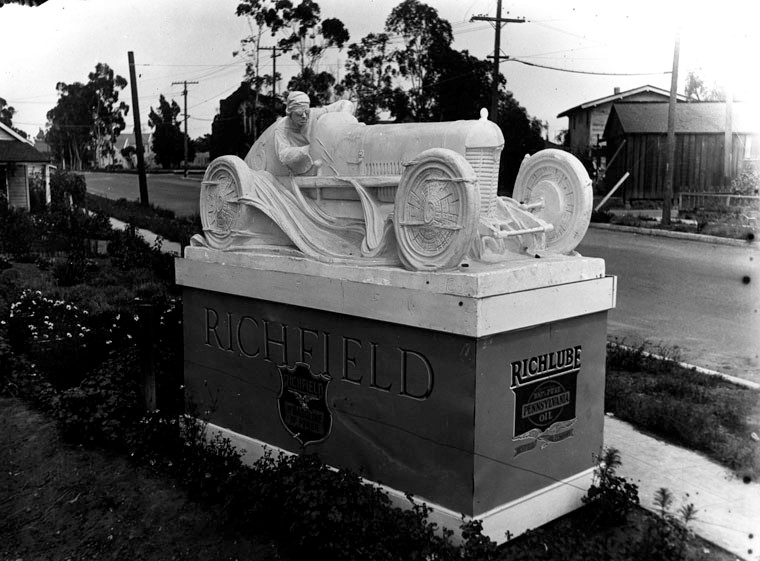 |
|
| (1926)^ - Photo of "Modern Speed," a statue by Finn Froelich located on Redondo Boulevard, near Inglewood. The words, "Richfield" is carved in large letters. Below it is a shield which reads, "Richfield, the gasoline of power." On the side, the words, "Richlube" is carved followed by "100% Pure Pennsylvania Oil." |
Historical Notes From 1921 to 1932 cars using Richfield gasoline took the top five places at Indy, which spawned their phrase ‘Gasoline of Power’. To celebrate this success a statue was commissioned in 1926 and created by sculptor Finn Haakon Frolich. This large statue featured a dirt track racer sliding through a turn and was used as a monument at various Richfield stations to commemorate their racing successes.** |
.jpg) |
|
| (1929)^^ - Close-up view showing the pumps at the Richfield Service Station located on the southeast corner of Santa Monica Boulevard and Ogden Avenue in West Hollywood. Today, a parking lot occupies this space. |
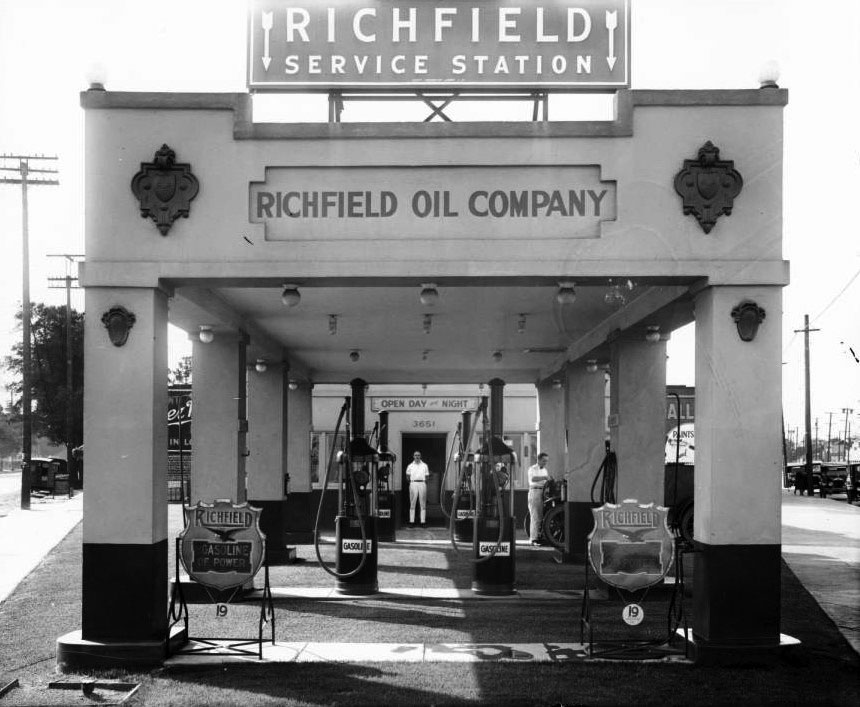 |
|
| (ca. 1929)^^ - Four gasoline pumps stand below a large covering which reads "Richfield Service Station, Richfield Oil Company". Between the gasoline pumps a man in a lightly-colored uniform can be seen in the doorway of the shop which stands behind the station with the label "Open day and night". A second man in an identical uniform tends to an automobile on the right. Address over the door reads “3651”. |
* * * * * |
Gilmore (Blu-Greeen Gasoline)
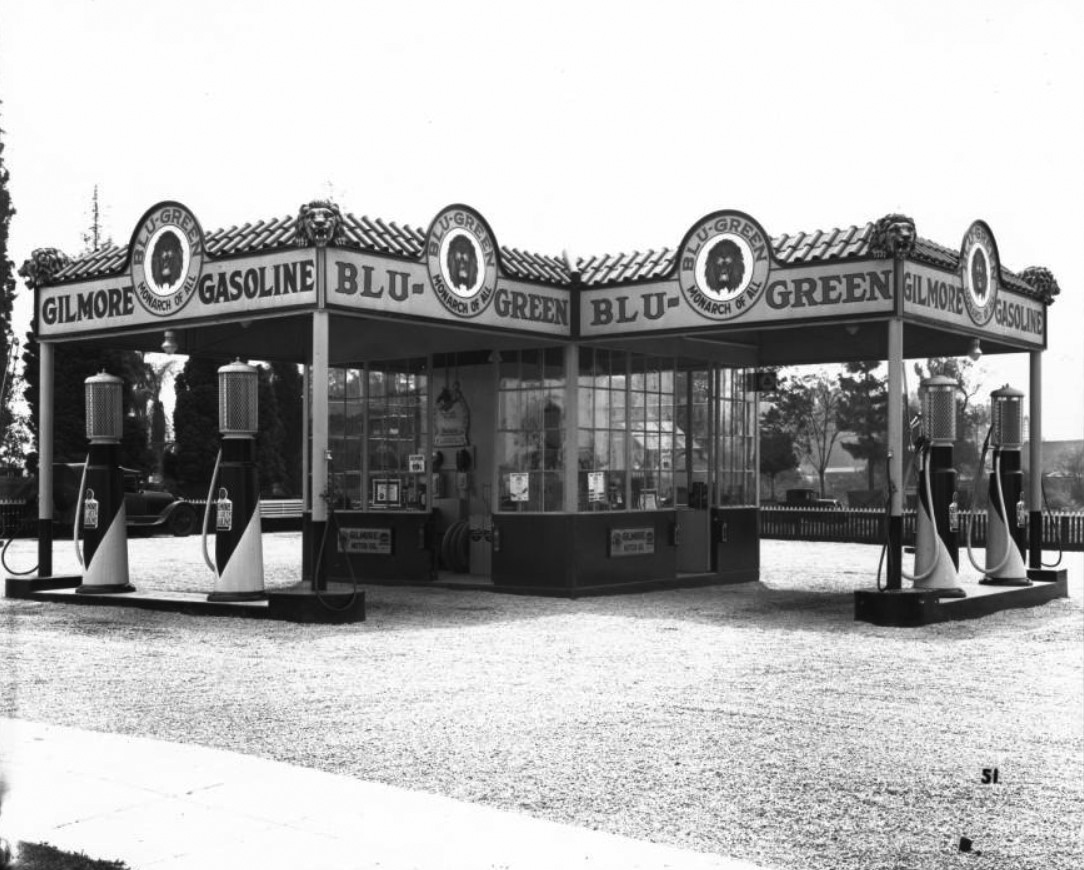 |
|
| (ca. 1929)^^ – View showing a Gilmore Gas Station selling Blu-Green Gasoline. |
Historical Notes There were more than 1,100 Gilmore Gas Statons throughout the West that sold only Gilmore products and another 2,400 that sold them along with other brands. The clear glass globes at the top of gas pumps allowed the color of the gasoline to be seen. E.B. Gilmore jumped on this unique opportunity to become the first oil company to market its gas by its color. Blu-Green and Red Lion Gas fueled the cars and imaginations of West Coasters from the ’20s to the early ’40s. *** |
* * * * * |
Van Fleet and Durkee Gas Station (7th and S. Park View)
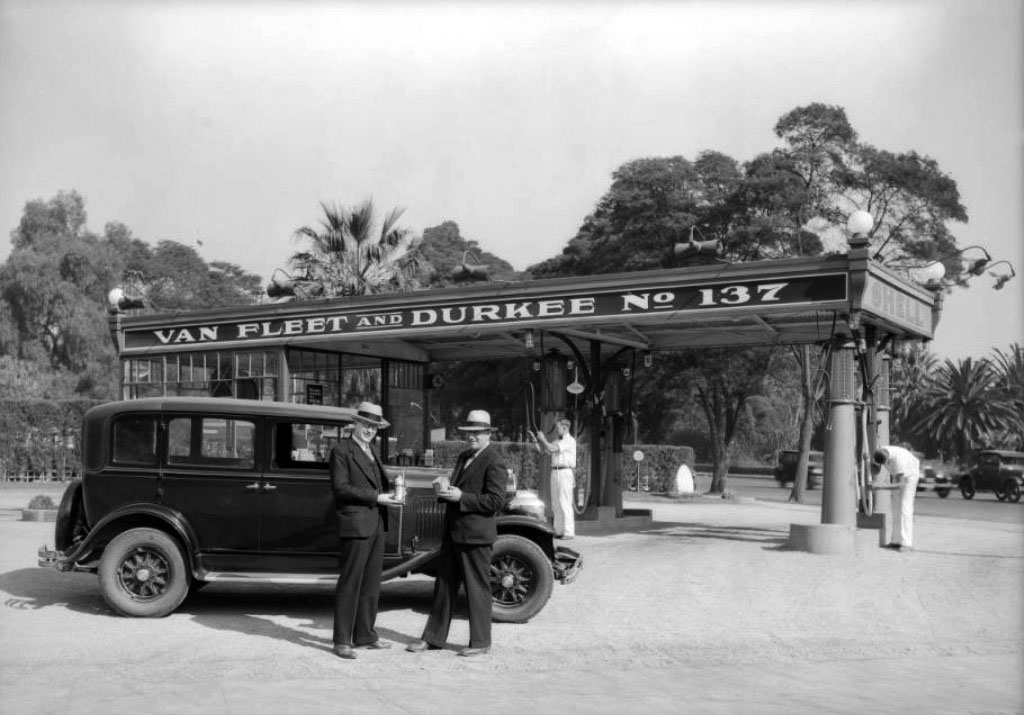 |
|
| (1929)^^ - Two men in suits hold up what appears to be an oil can and an oil filter in front of the Van Fleet and Durkee Service Station No. 137 located at West 7th Street and South Park View Street. Westlake Park (later MacArthur Park) is seen across the street. |
Historical Notes Westlake Park was renamed MacArthur Park in 1942. |
* * * * * |
Dad and Ernie's Gas Station
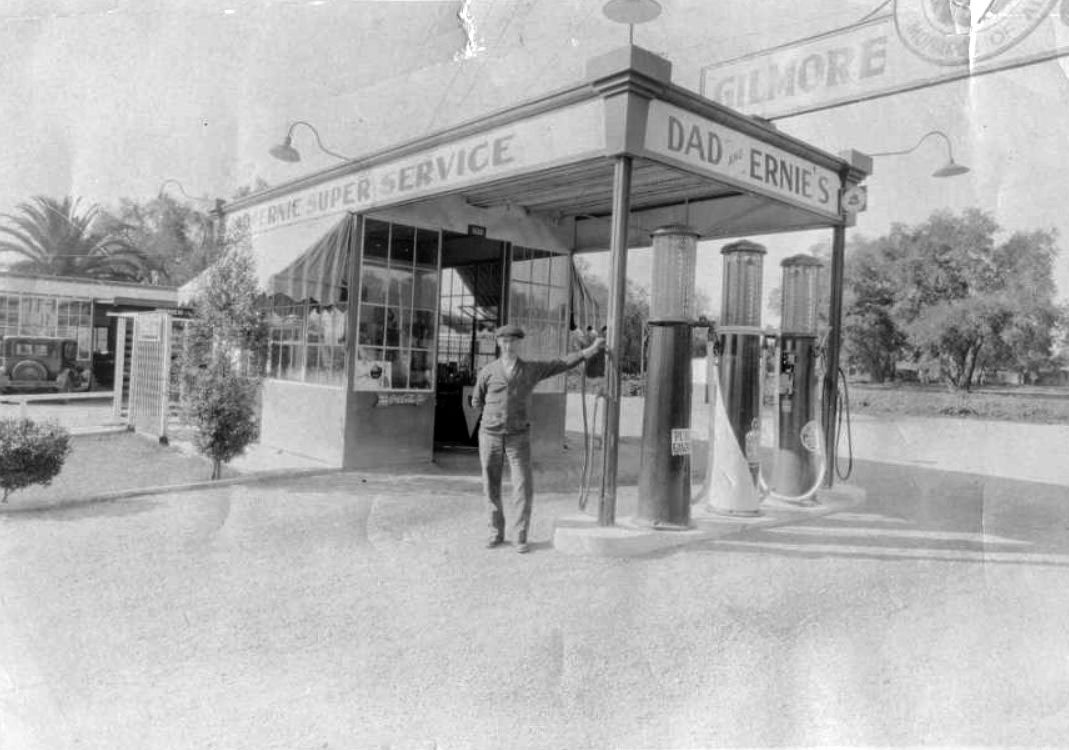 |
|
| (1930)*^** - Adolph Thore stands in front of Dad and Ernie's Gas Station, which was located at 2830 E. Colorado at Daisy. He and Ernie Pare, the garage mechanic, were the owners and operators. They provided fuel from Gilmore Gas. |
* * * * * |
Texaco (Woodland Hills)
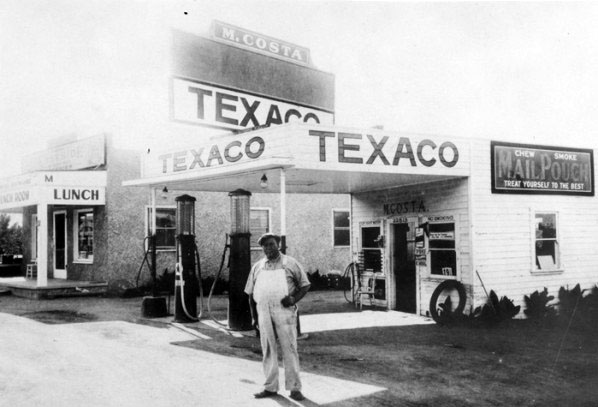 |
|
| (ca. 1930)*^ - M. Costa Texaco gas station at 23513 Ventura Boulevard, Woodland Hills. The Eastside Lunchroom is visible at left in background. |
* * * * * |
Oak Garage and Gas Station (Calabasas)
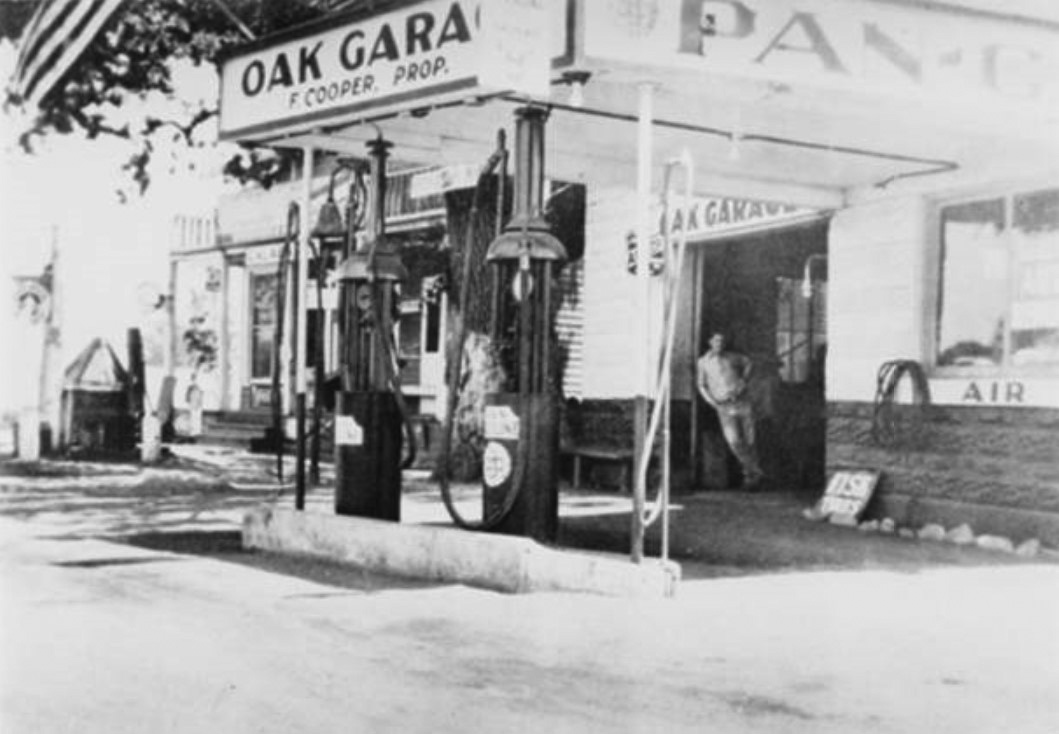 |
|
| (ca. 1930)*^ – View showing the Oak Garage and Gas Station with Frank Cooper standing in the doorway. In the background is the famous Calabasas "Hanging Tree". |
* * * * * |
Standard Oil Station (Beverly and La Brea)
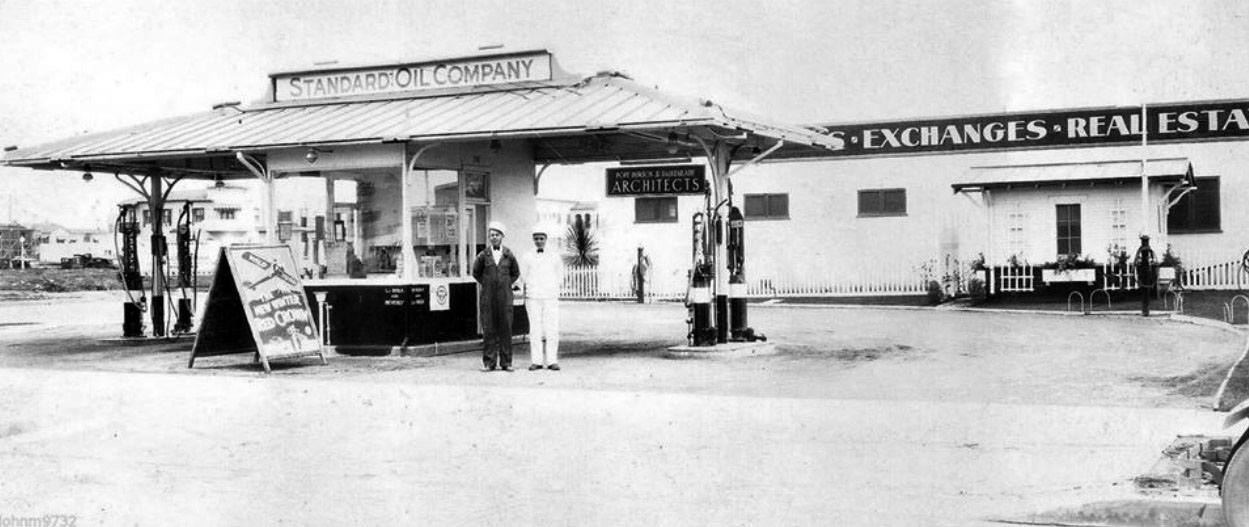 |
|
| (ca. 1930)^*^# – View of a Standard Oil Station located on the corner of Beverly and La Brea. Pope and Burton Architects occupy part of the building behind the station. |
Historical Notes The above photo is undated, but possibly late 1920s to early 1930s, since Pope and Burton Architects didn't open their Los Angeles office until 1927. |
* * * * * |
Shell Gas Station (Exposition and Vermont)
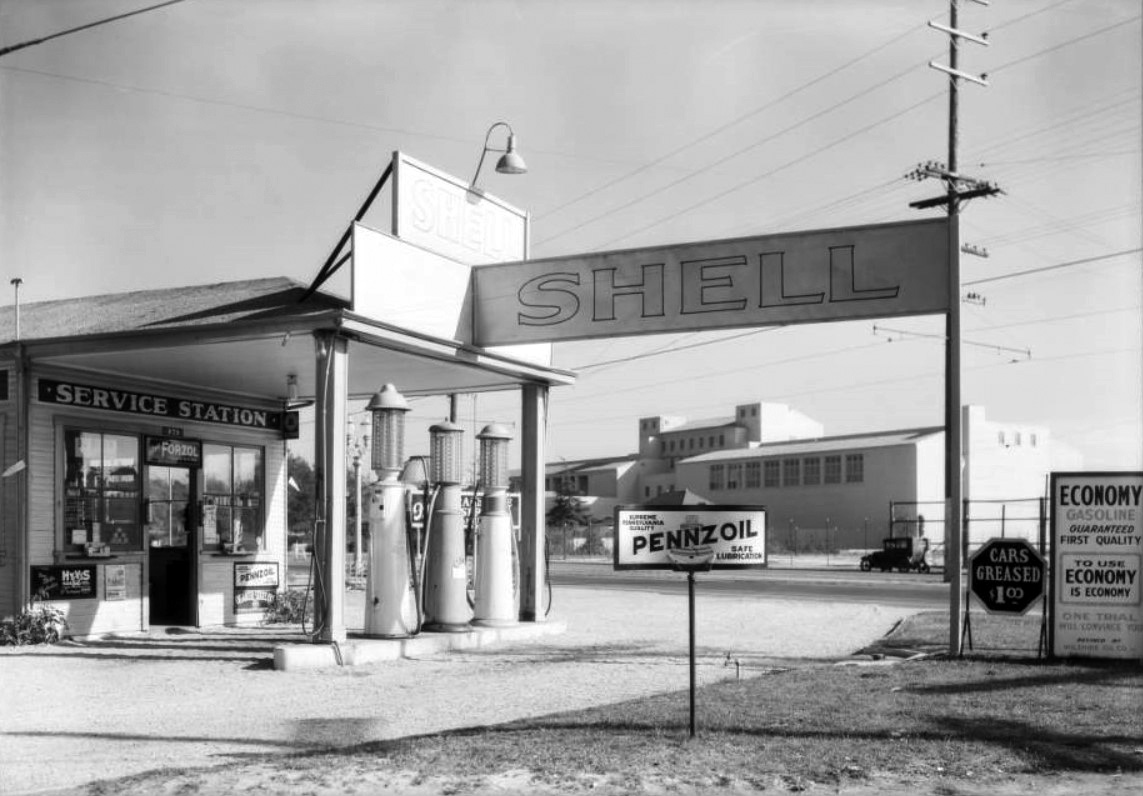 |
|
| (1930)^^ - View showing a Shell Service Station located at Exposition Boulevard and South Vermont Avenue, Los Angeles. Sign on right reads: “Cars Greased $1.00”. Sign to the far right reads: “Economy Gasoline Guaranteed First Quality, To Use Economy Is Economy.” |
* * * * * |
Liberty Gas Station
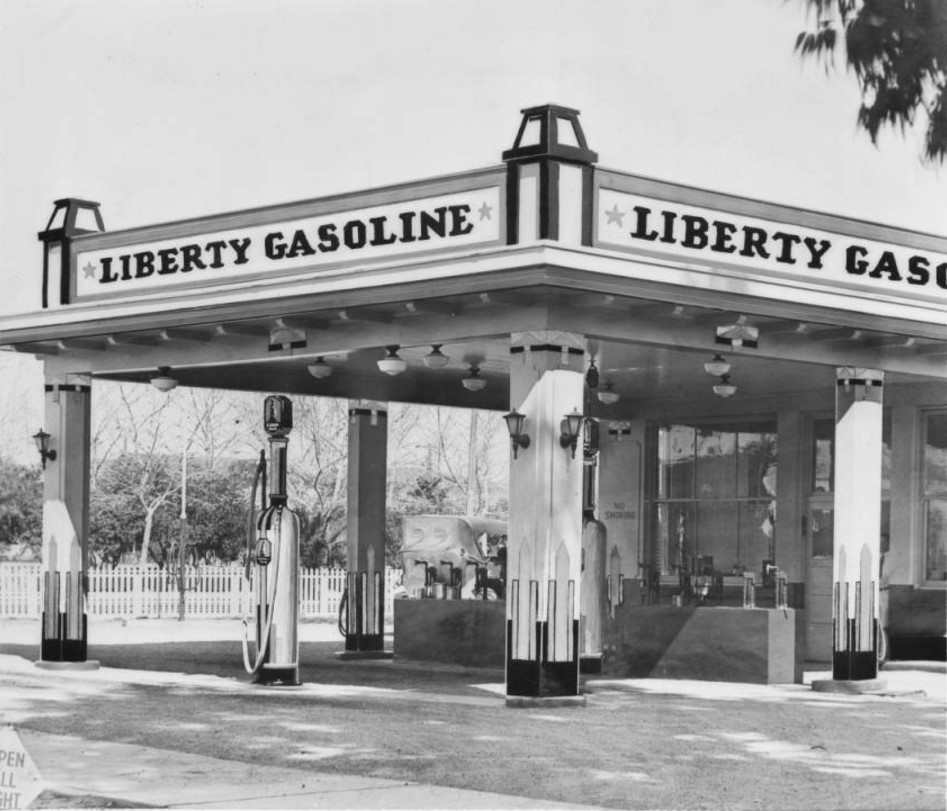 |
|
| (1931)^^ – View showing the Liberty Gas Station located in Southern California. Sign in lower-left reads: Open All Night. |
* * * * * |
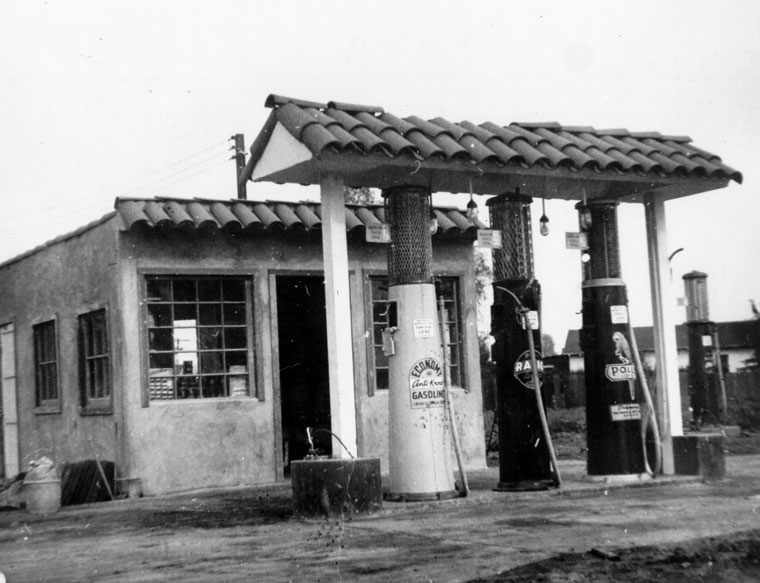 |
|
| (ca. 1930s)^ - One of the first gas stations on a lot on Imperial St., Los Angeles, shown in the 1930's. It was the workplace for a group of men from the Mexican American Community. |
* * * * * |
Chatsworth Service Station (s/o Topanga and Devonshire)
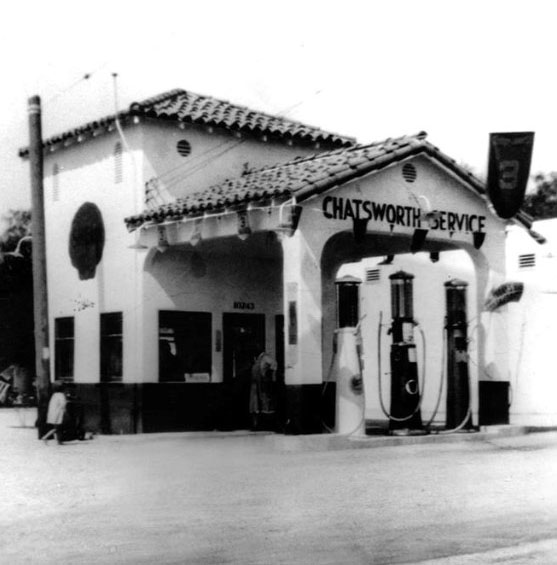 |
|
| (ca. 1930s)#^*^ – Close-up view of the Chatsworth Service Station located on the west side of Topanga south of Devonshire. |
* * * * * |
Zelzah Super Service (Northridge)
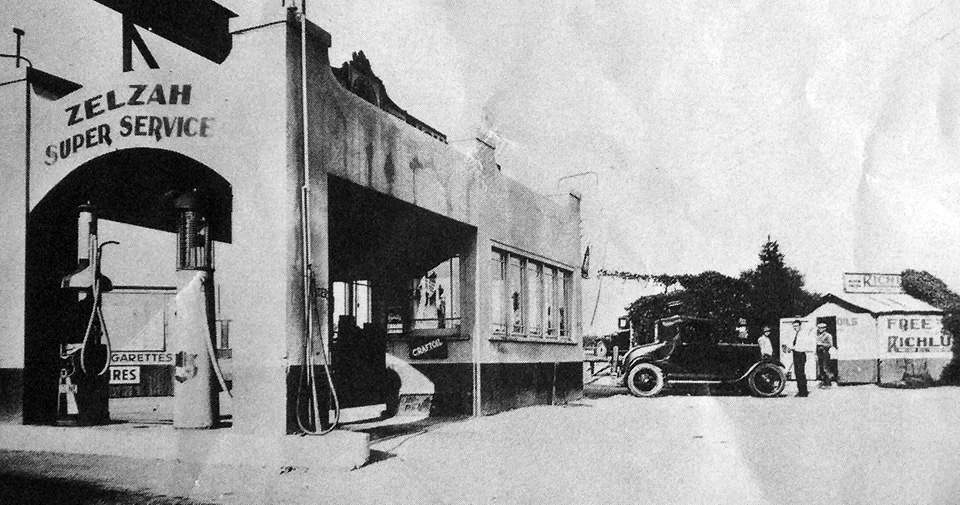 |
|
| (ca. 1929)^ - Zelzah Super Service Richfield Gas Station on the northeast corner of Reseda Blvd. and Gresham St. in Northridge. |
Historical Notes In 1929 the town of Zelzah’s name was changed to North Los Angeles. In 1938, the name changed again to Northridge Village and promptly shortened to Northridge. |
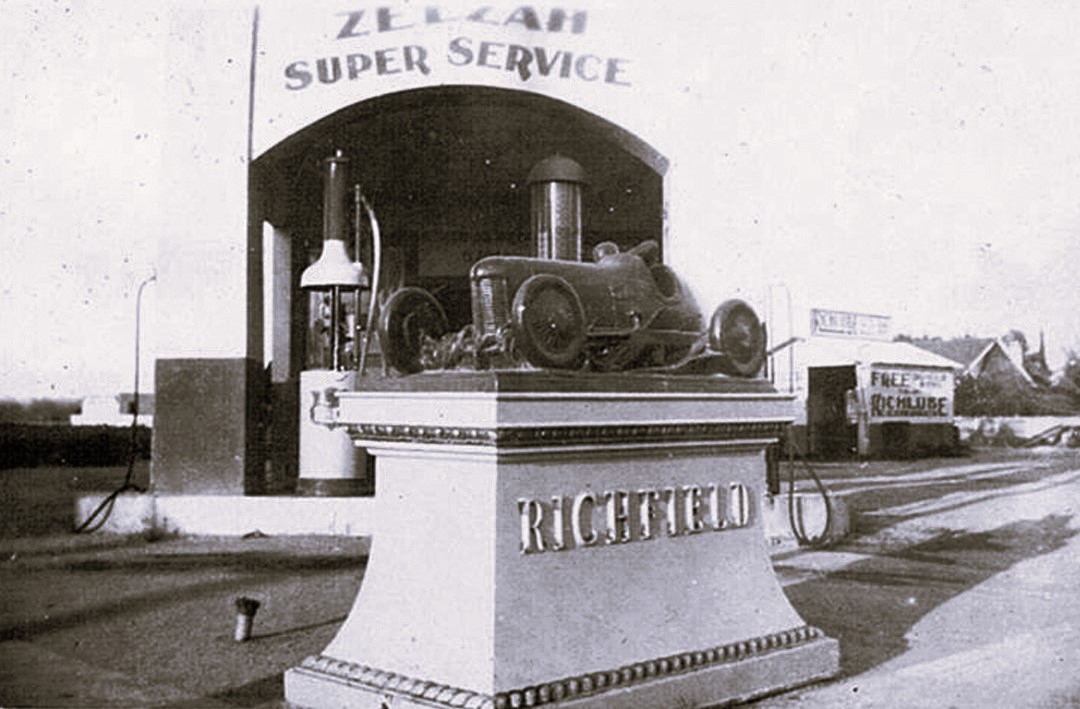 |
|
| (ca. 1929)* - Close-up view showing a statue of a racecar in front of Zelzah Super Richfield Service Station. |
Historical Notes From 1921 to 1932 cars using Richfield gasoline took the top five places at Indy, which spawned their phrase ‘Gasoline of Power’. To celebrate this success a statue was commissioned in 1926 and created by sculptor Finn Haakon Frolich. This large statue featured a dirt track racer sliding through a turn and was used as a monument at various Richfield stations to commemorate their racing successes. |
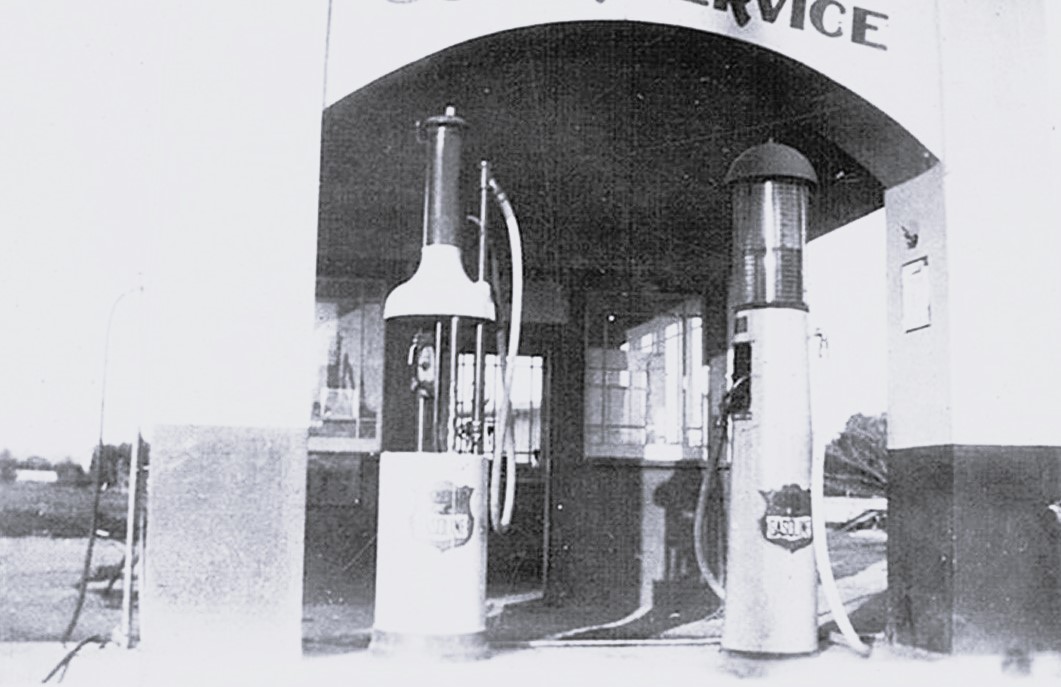 |
|
| (ca. 1929)* - Close-up view of the two pumps Zelzah Super Service Richfield Gas Station with office in the backgorund. |
Shell Service Station (Beverly Hills)
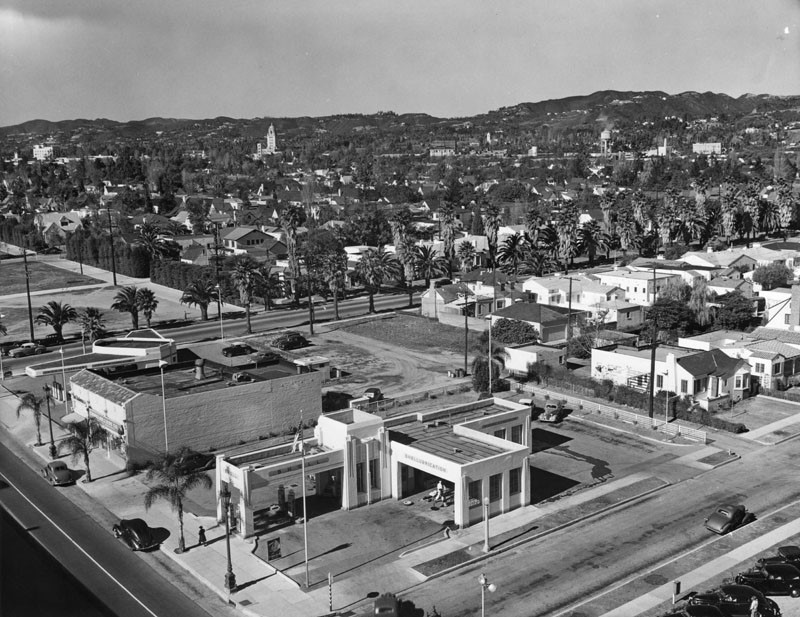 |
|
| (ca. 1939)^ – Birds-eye view of Beverly Hills looking northwest from the intersection of Wilshire Boulevard and Wetherly Drive. A Shell Gas Station is seen in the foreground on the northwest corner. The tall white building in the distance (upper center-left) is Beverly Hills City Hall. |
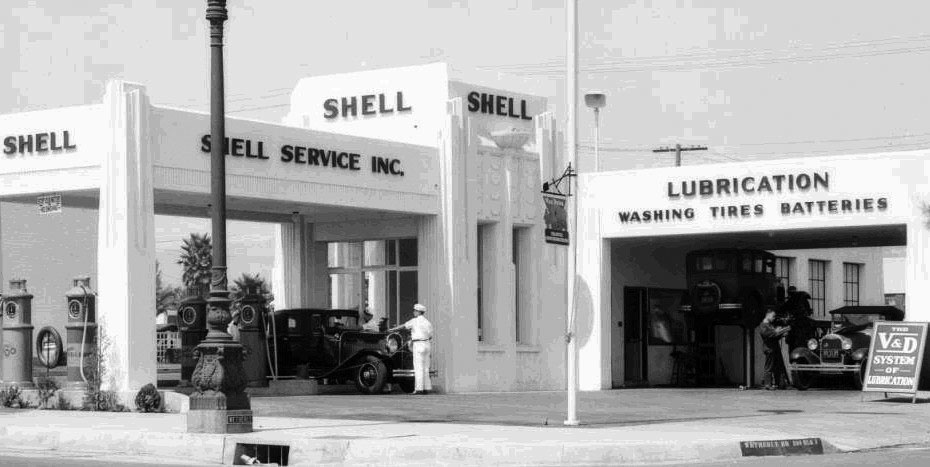 |
|
| (1931)##++ – Full service at the Shell Service Station located on the corner of Wilshire Boulevard and Wetherly Drive, in Beverly Hills. |
* * * * * |
Auto Laundry - Signal Purr-Pull (Glendale)
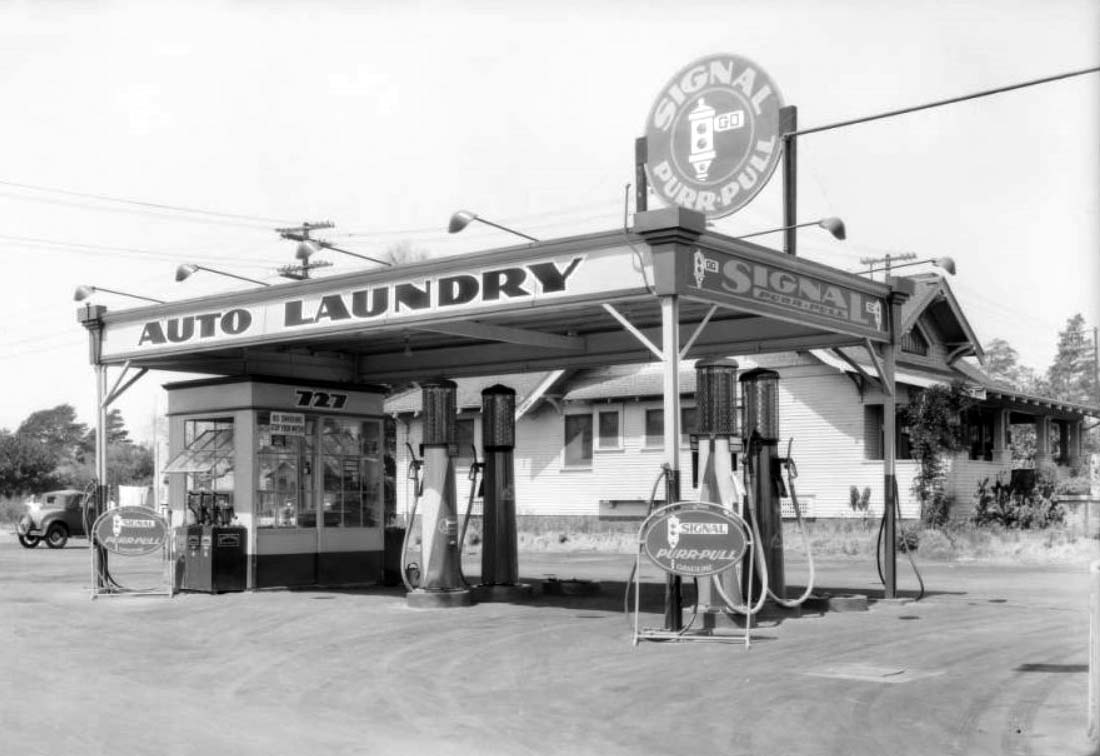 |
|
| (1931)^^ – View showing a 4-pump Signal Service Station in Glendale, California. Large signs reads Auto Laundry – Signal Purr-Pull |
* * * * * |
Gilmore Gas Station
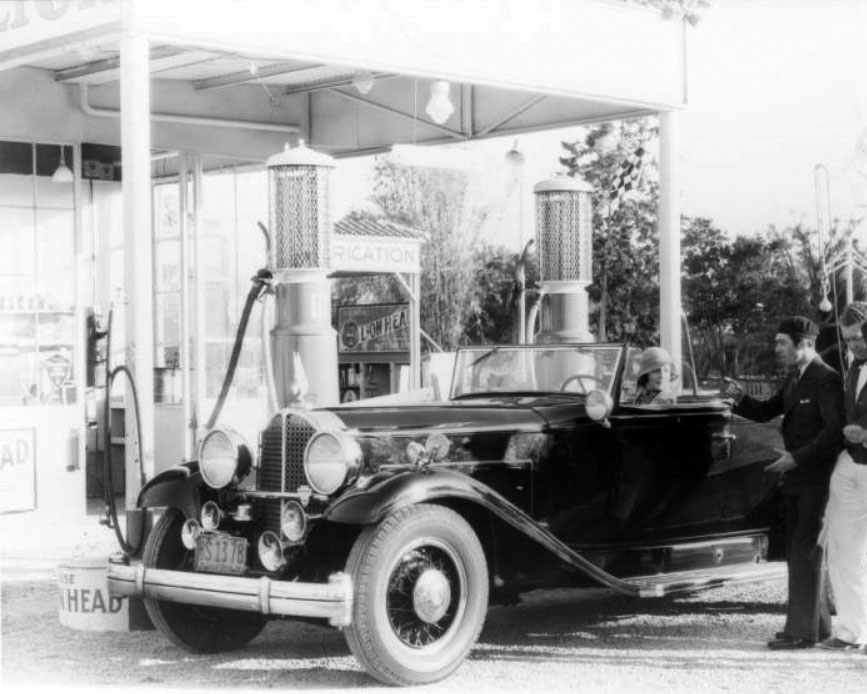 |
|
| (1932)^^ – View showing a Packard at a Gilmore Station, Southern California. |
* * * * * |
Union Gas Station
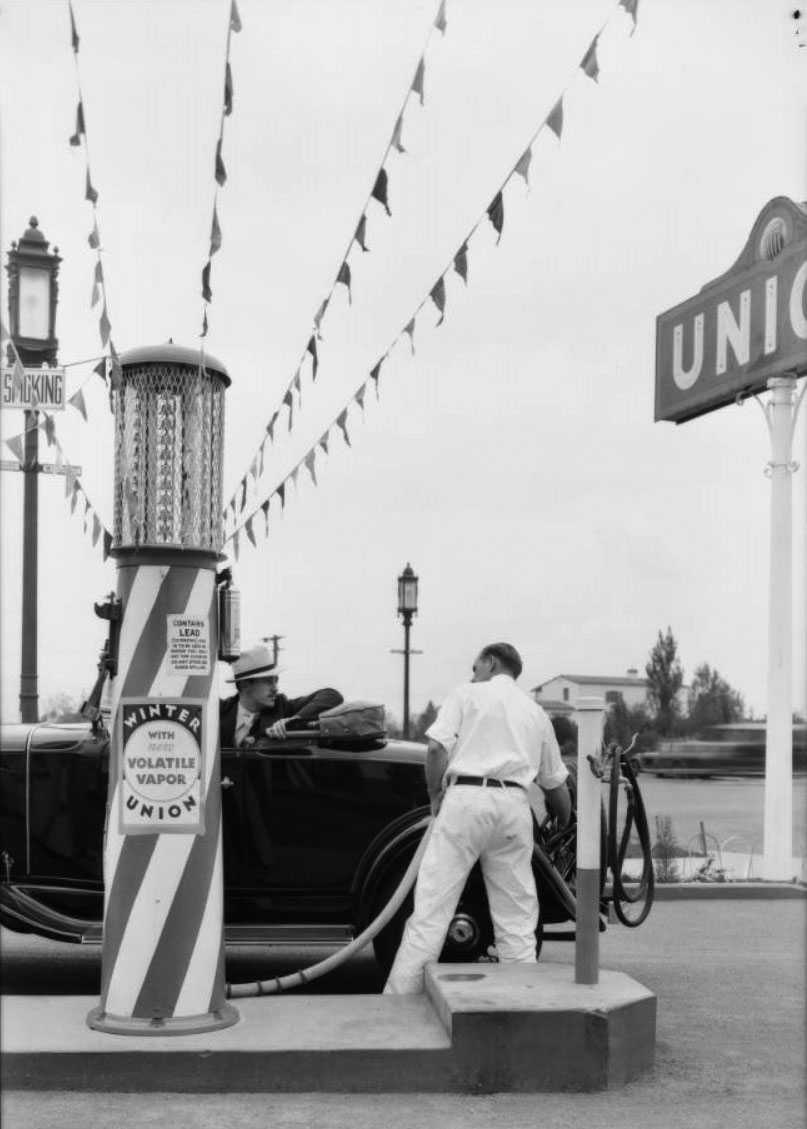 |
|
| (1931)^^ - Filling car with 'Volatile Vapor' at a Union gas station on Wilshire Boulevard with streamers from pump to sky. |
* * * * * |
Texaco Gas Station (Hollywood)
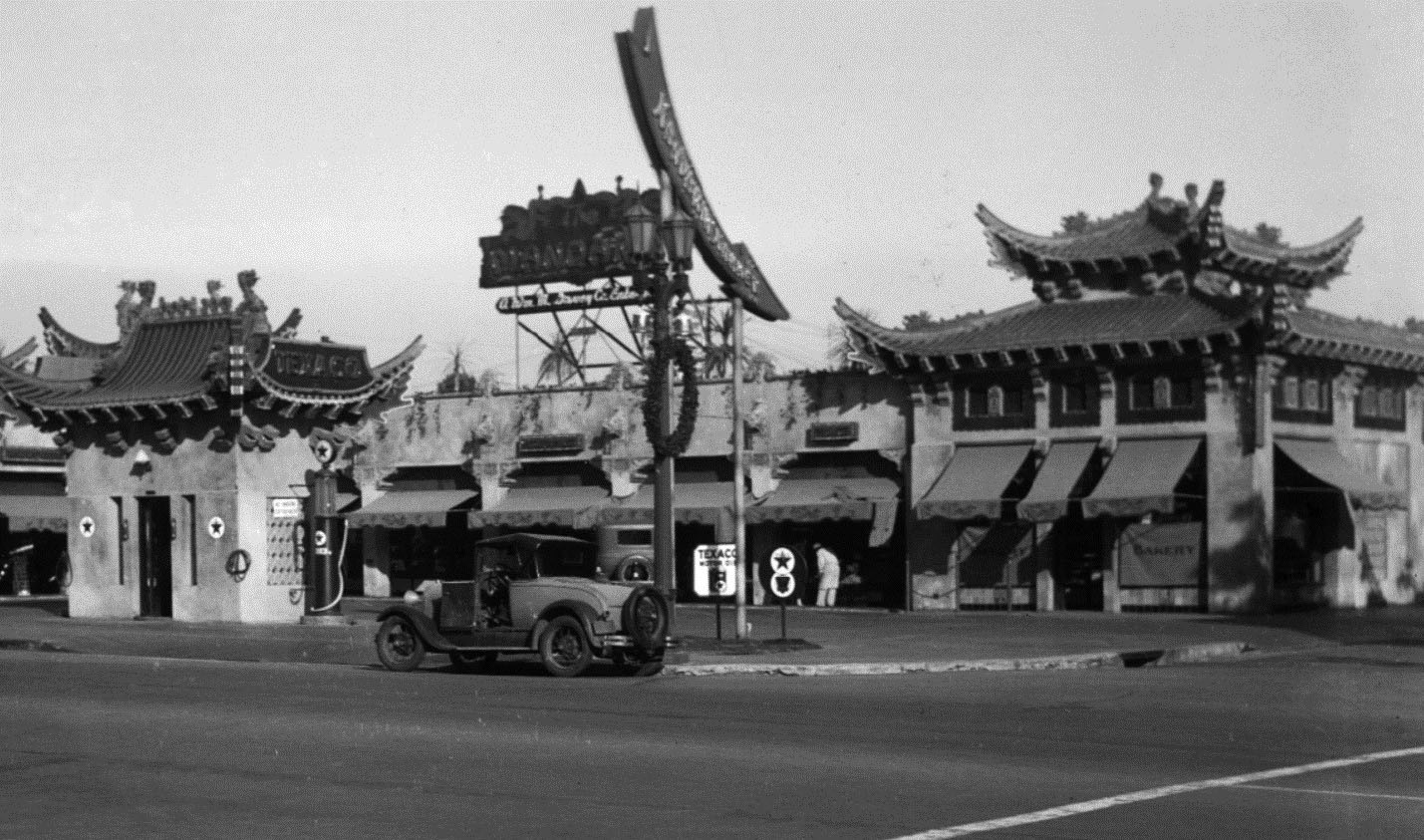 |
|
| (ca. 1929)## – View looking at the NW corner of La Mirada Avenue and Vine Street in Hollywood showing a Texaco Gas Station and Kiosk in the Mandarin Market parking lot. |
Historical Notes Architect Henry L. Gogerty designed the 1929 Mandarin Market, a Chinese-style drive-in market located at 1234-1248 Vine Street, in Hollywood. The complex included a Texaco service kiosk, the Mandarin Bakery, a full meat and produce market, and a restaurant. This building later became the Hollywood Ranch Market and was demolished after a fire in 1981 for a 1984 mini mall.^ |
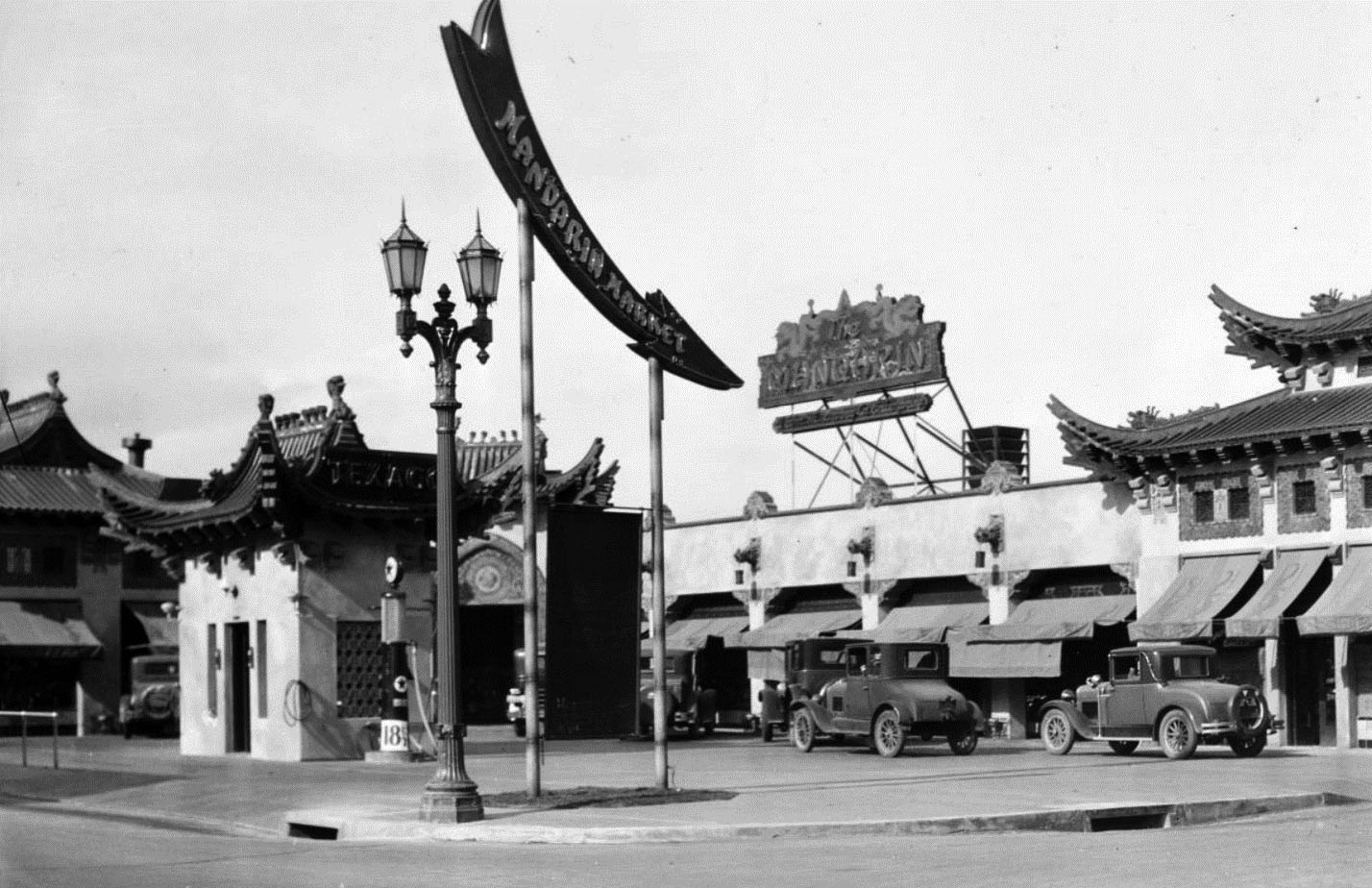 |
|
| (ca. 1929)^^ – A Texaco service kiosk stands at left as part of the Mandarin Market, a Chinese-style drive-in market located at 1234-1248 Vine Street, in Hollywood. |
Historical Notes The Mandarin Market was touted as being one of the first drive-in markets of its kind in Los Angeles. The architect was Henry L. Gogerty, who later designed "gliding acoustical walls" for classrooms, and assembly line buildings for Howard Hughes' Spruce Goose project. |
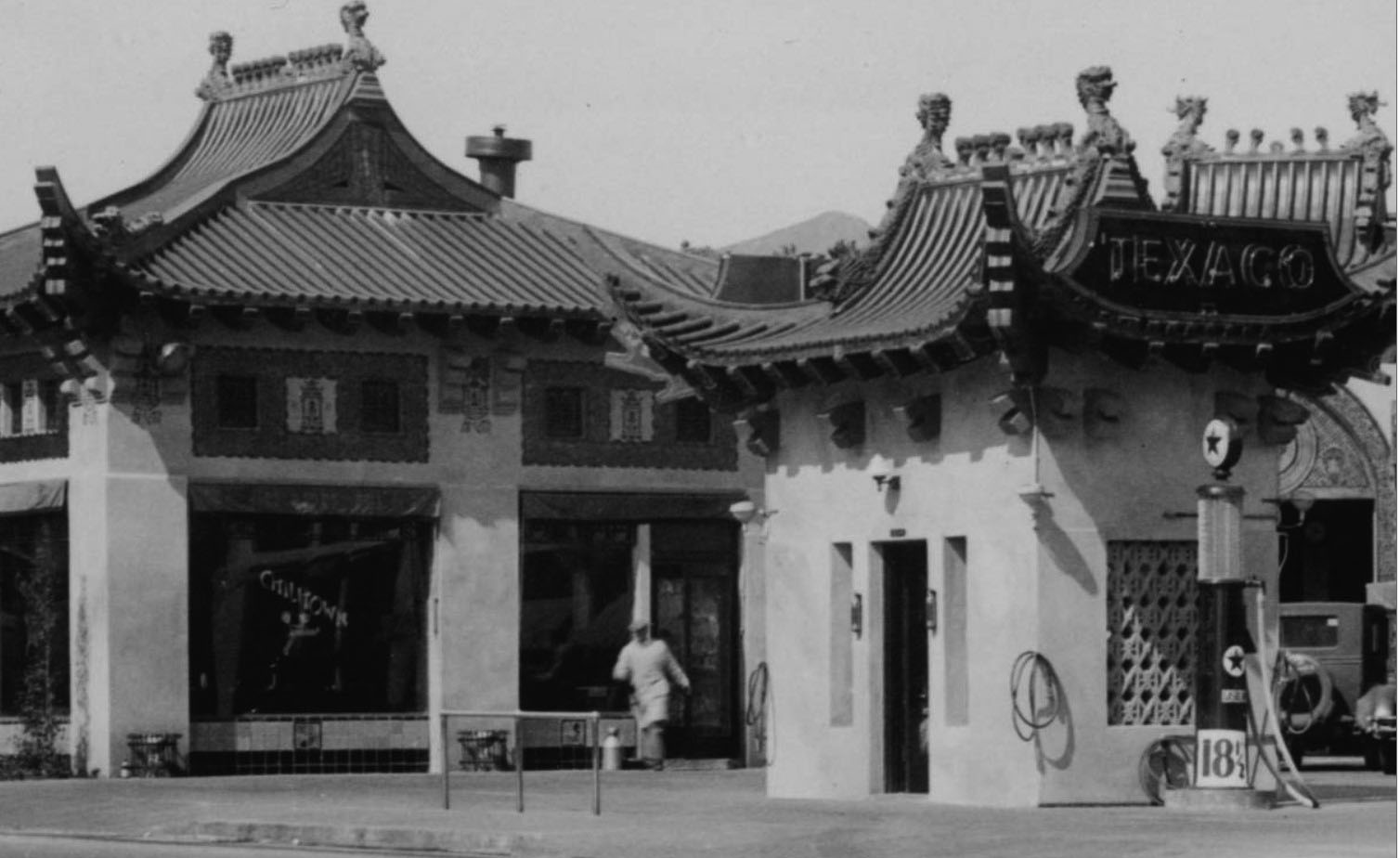 |
|
| (ca. 1929)* - Close-up view of the Texaco Station located at the Mandarin Market in Hollywood. Note the Pagoda-style design of the roof line. |
* * * * * |
Texaco Gas Station (Hollywood)
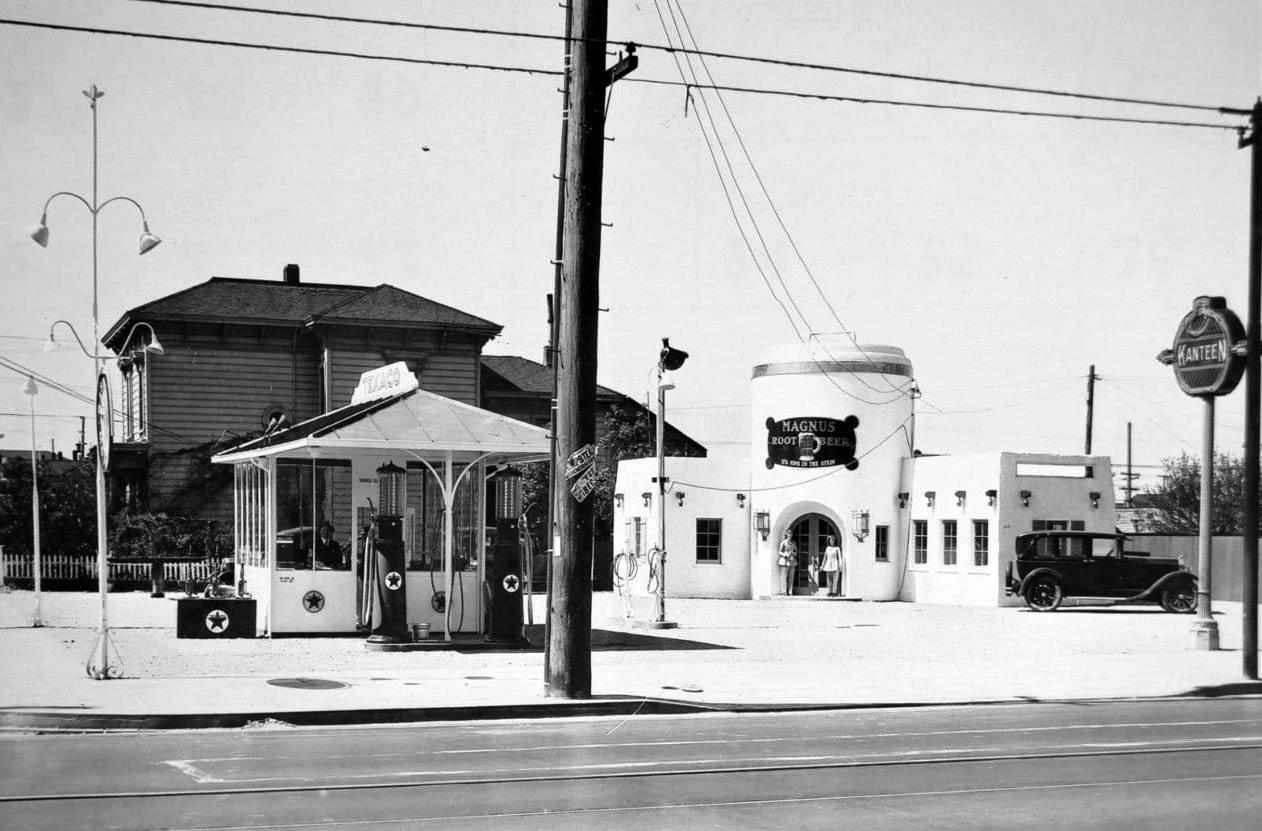 |
|
| (ca. 1929)* – View showing a two-pump Texaco gas station teamed with a Magnus Root Beer restaurant with car service located at 766 N. Vine Street (just south of Waring Ave), in Hollywood. Today The Oinskter Restaurant stands where the Texaco sation was once located. Click HERE for contemporary view. |
Historical Notes The National Kanteen Co built two of these Mangnus Root Beer drive-in restaurants in Hollywood in 1929. |
* * * * * |
Muller Bros. Service Station (Hollywood)
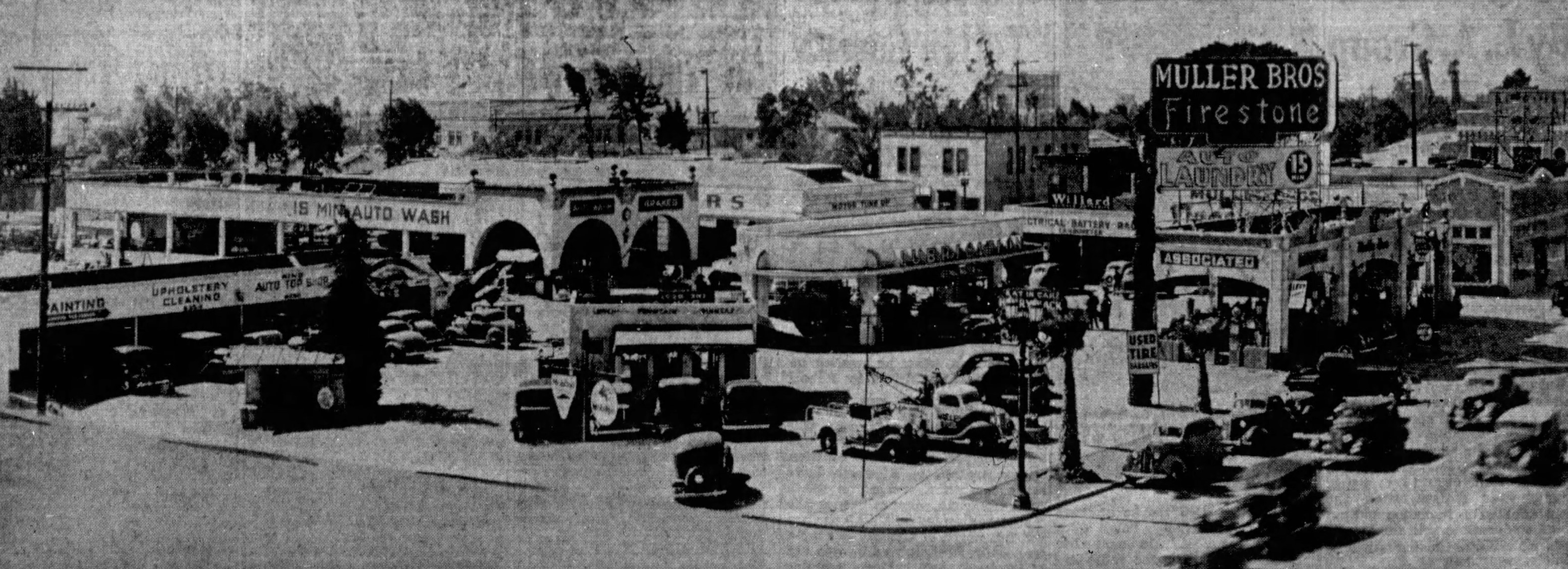 |
|
| (1930s)* - Panoramic view showing Muller Bros. Service Station at 6380 Sunset Blvd. in Hollywood. |
Historical Notes The Muller Bros. Service Station, located at 6380 Sunset Boulevard in Hollywood, was established in 1920 by brothers Walter and Frank Muller. Originally a small gas and tire center, the business quickly expanded by 1922 into a full-service automotive facility. It offered a wide range of services such as motor lubrication, washing and polishing, headlight testing, and tire vulcanizing. The Muller brothers also introduced a service car to aid stranded motorists, which helped build a reputation for reliability and customer service. |
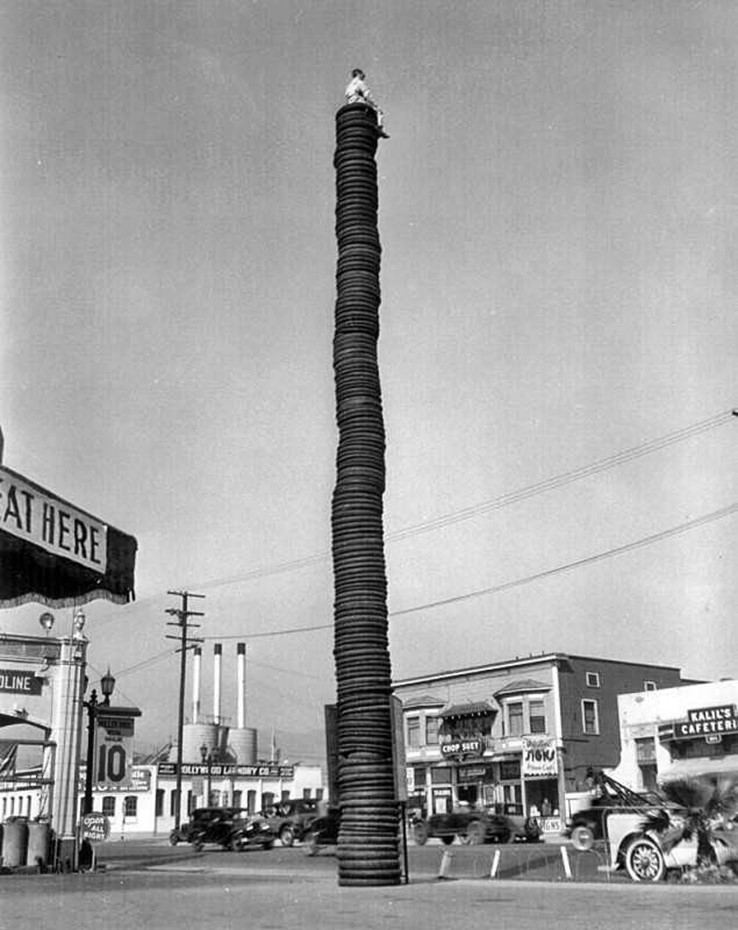 |
|
| (ca. 1928)* - Sitting on top of a stack of automobile tires at Muller Brothers Super Service Station at the corner of Sunset and Cahuenga Boulevards. |
Historical Notes The Muller brothers were quite the promoters and even had women in swimsuits parade around with signs selling things. |
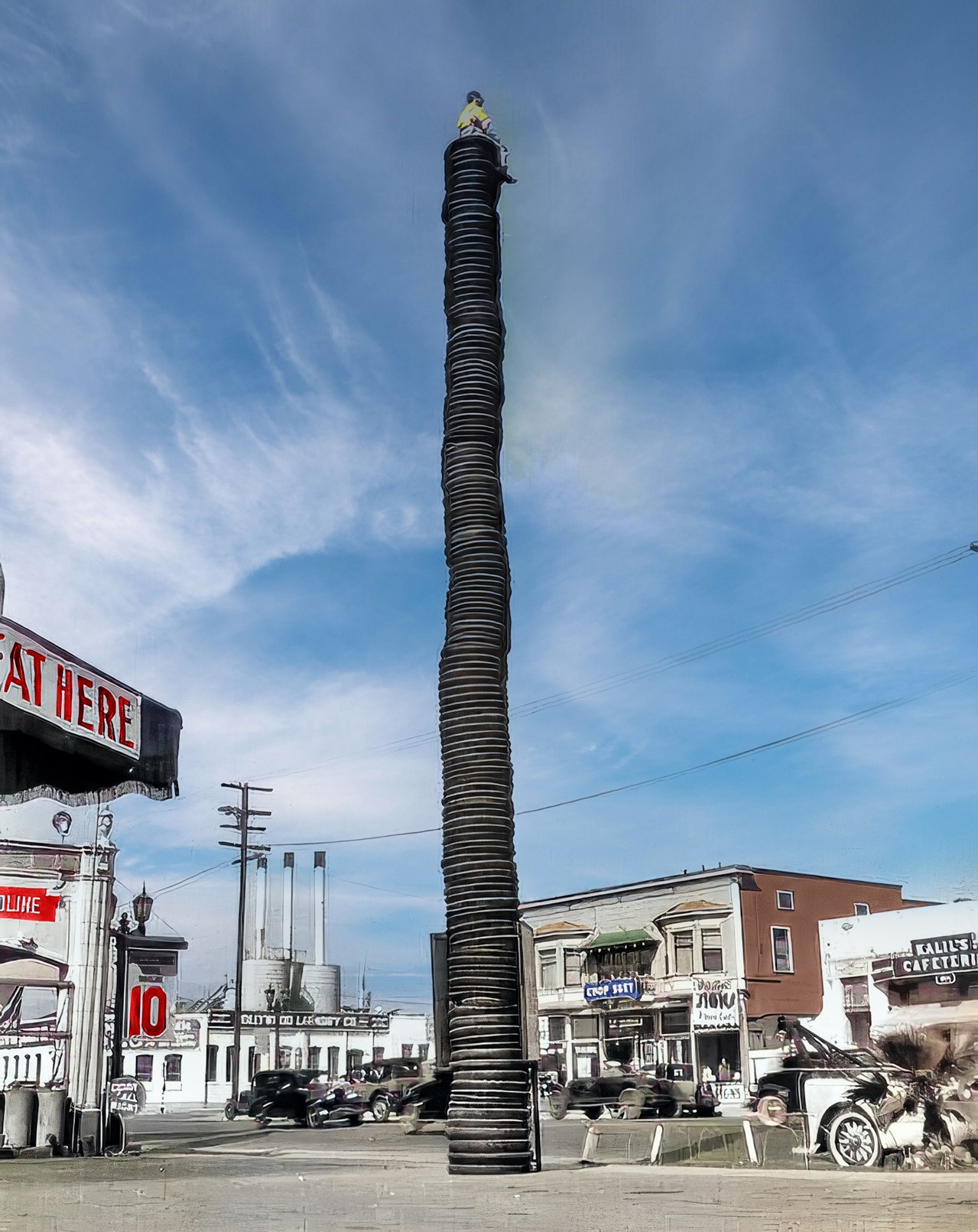 |
|
| (ca. 1928)* - Sitting on top of a stack of automobile tires at Muller Brothers Super Service Station at the corner of Sunset and Cahuenga Boulevards. Image enhancement and colorization by Richard Holoff |
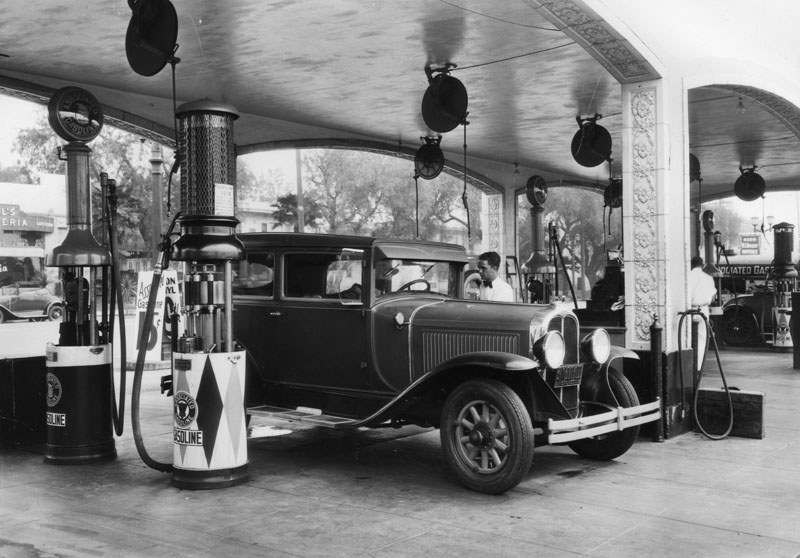 |
|
| (1928)^ - A customer gets full service at the gas pumps at Muller Bros. Service Station at 6380 Sunset Blvd. in Hollywood. |
Historical Notes The station's popularity soared throughout the 1920s and 1930s, growing to cover three acres at the busy corner of Sunset and Cahuenga and employing over 100 workers by 1937. Its location and customer-focused model attracted many Hollywood celebrities, including Rudolph Valentino and Clark Gable. In 1936, a major renovation introduced Streamline Moderne architecture designed by Douglas Hull McLellan and Allen McGill, aligning the facility with contemporary styles influenced by the Century of Progress World's Fair in Chicago. Some original Spanish-Italian style structures, such as the car wash, were retained alongside the new additions. |
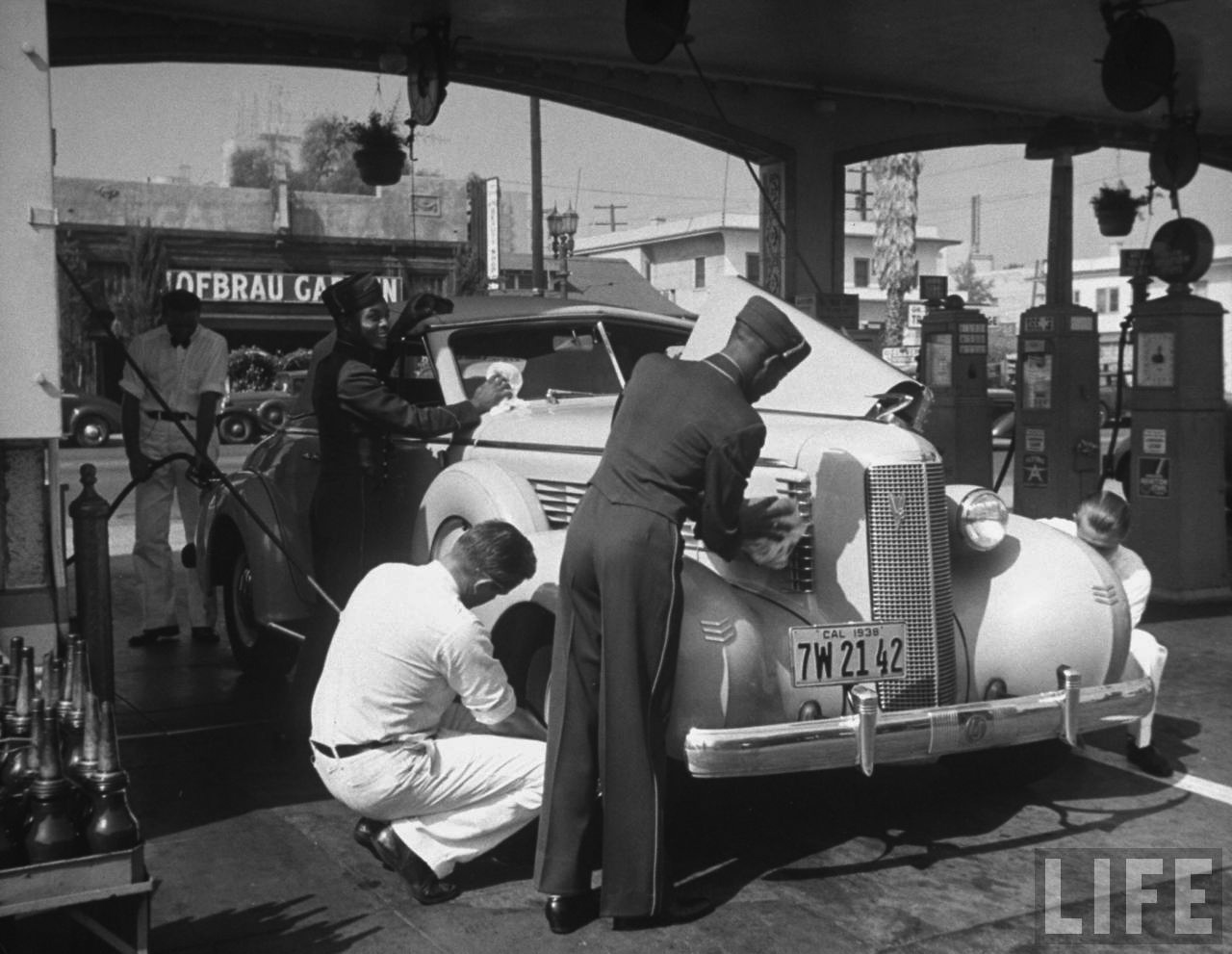 |
|
| (1938)* - View of what appears to be a 1937 Cadillac LaSalle Opera Coupe being attended to in "full service" at the Muller Brothers Service Station at 6380 Sunset Boulevard in Hollywood.re the Texaco sation was once located. Click HERE for contemporary view. |
Historical Notes In its heyday, Muller Bros. was known not only for its scale but also for its promotional flair. In 1951, the station marked its three millionth car wash with a public celebration and the crowning of a "Miss Muller Bros." Despite its success, the site was sold in 1963 to pave the way for the Cinerama Dome Theatre, bringing an end to one of Hollywood’s most iconic service stations. Its blend of service, style, and celebrity appeal left a lasting impression on mid-century Los Angeles. |
* * * * * |
Hollywood-Vine Service Station and Parking Garage
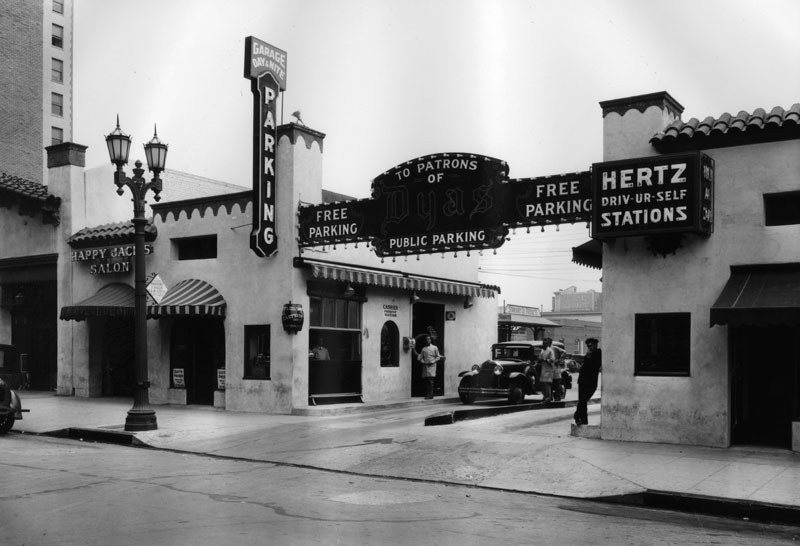 |
|
| (1930)^ - The Hollywood-Vine Service Station and Parking Garage, with free parking provided for nearby establishments, including Pig 'n Whistle, Dyas Restaurant, and Hertz car rentals. Not only did attendants service the customer's car and park it, they also took their laundry for dry-cleaning. |
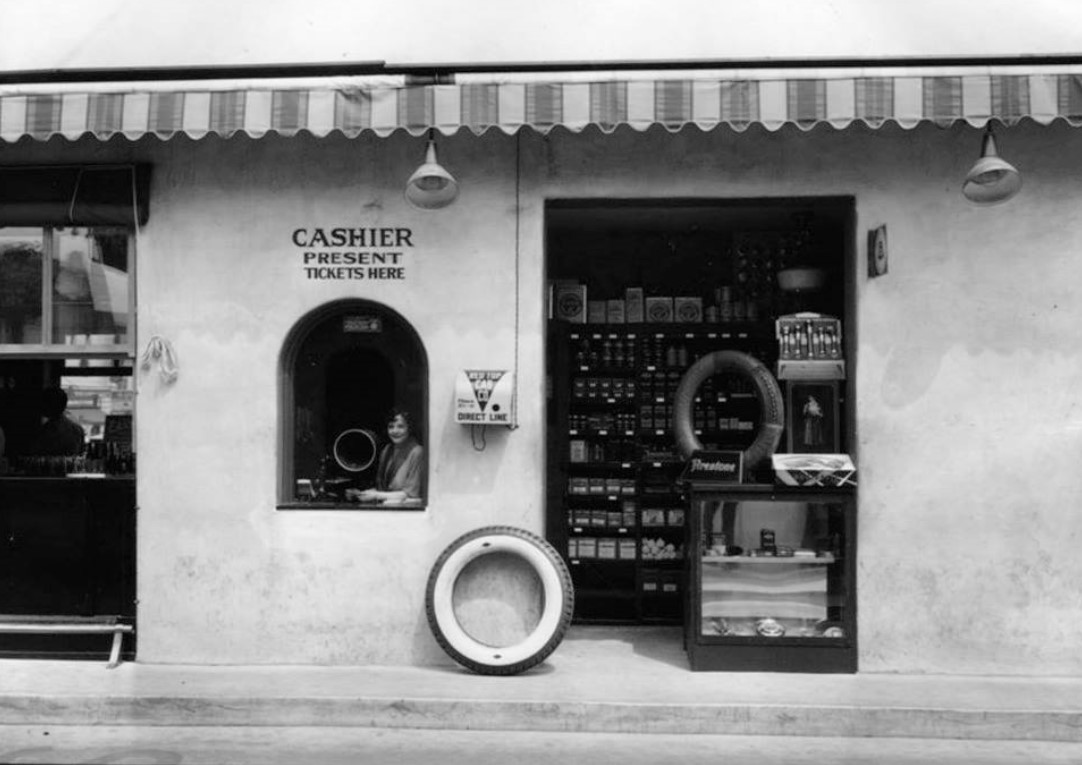 |
|
| (ca. 1930)^ - Close-up view of the cashier for the Hollywood-Vine Service Station and Parking Garage. This resembles today’s all-in-one gas stations and mini-markets. |
* * * * * |
Richfield Service Station (Hollywood)
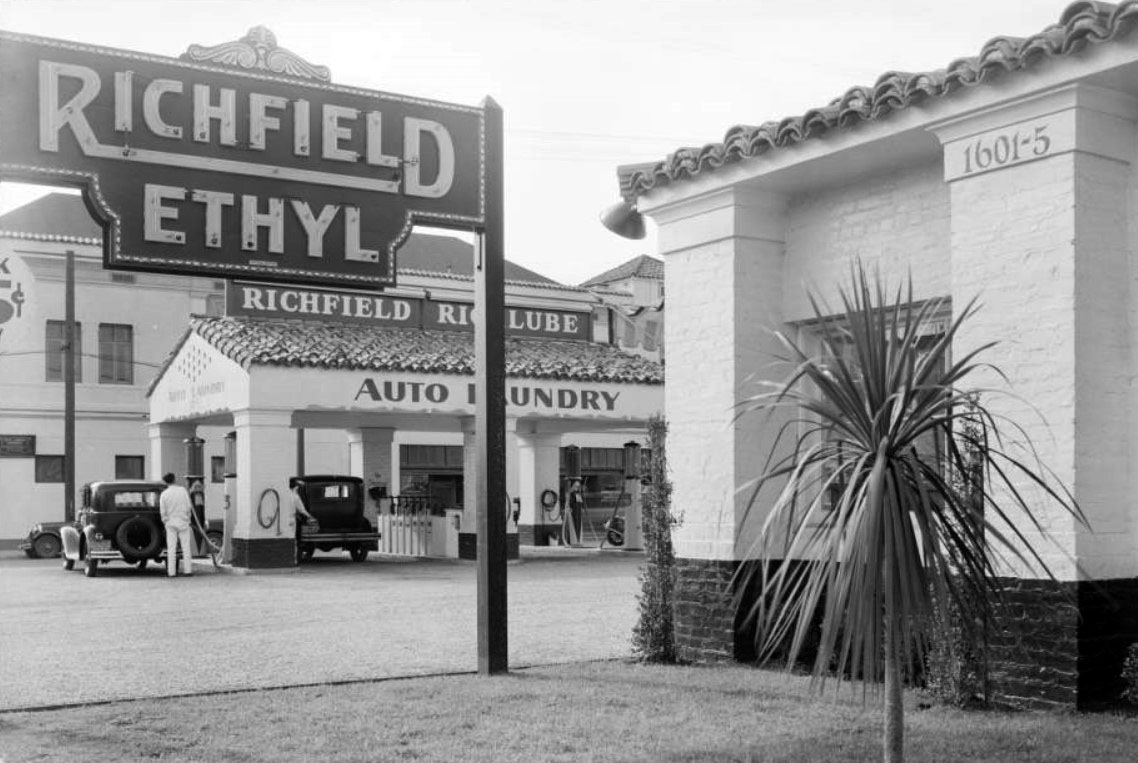 |
|
| (1930)* – View looking southwest showing a Richfield Service Station located on the NW corner of Vine Street and Selma Avenue (1601 Vine Street). Sign on side of canopy over gas pumps reads: “Auto Laundry”. |
Historical Notes The Richfield Oil Corporation was founded in 1905 and opened its first automotive service station in Los Angeles in 1917. After quick expansion, Richfield Oil Corp fell to the Great Depression and went into receivership in 1931. Consolidated Oil Corp, in 1935, bought Richfield's eastern United States operations. This maneuver removed Standard Oil of California's interest in Richfield Oil. The east coast gas stations would later be rebranded as Sinclair stations. Richfield Oil Corp emerged from receivership in 1936 after Rio Grande controlled by Consolidated Oil Corp and Cities Service Company agreed to a merger between Richfield Oil and Rio Grande. The company merged with Atlantic Refining to form Atlantic Richfield Corp, also known as ARCO in 1966. ARCO in turn was purchased by BP p.l.c. in 2000. |
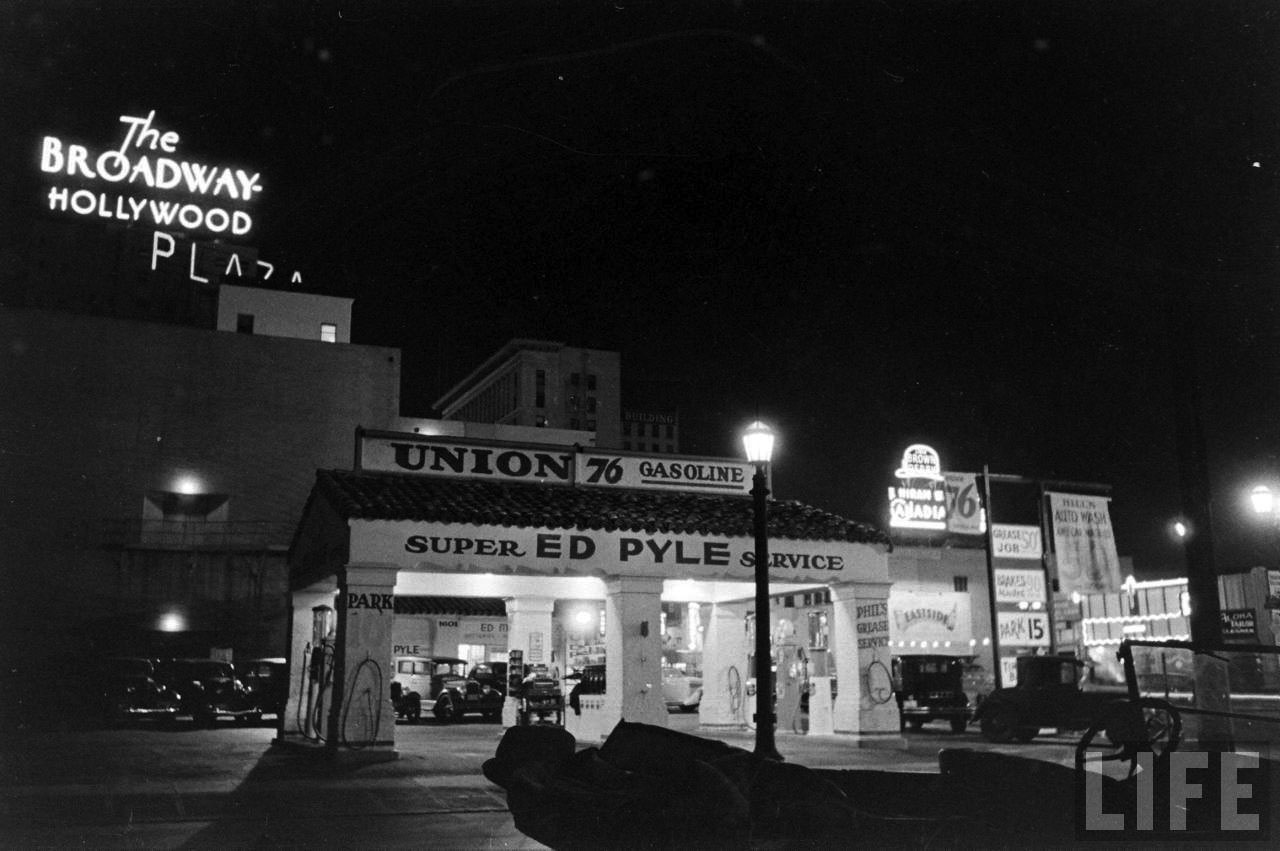 |
|
| (ca. 1932)* – Life Magazine photo showing a Union 76 Service Station located on the northwest corner of Selma Ave and Vine Street, which was previously a Richfield Station (see previous photo). Sign over pump reads “Super ED PYLE Service”. Neon lights shine in the background advertising The Broadway-Hollywood, Hollywood Plaza Hotel and the Brown Derby Restaurant. |
Historical Notes Union Oil (for many years based in El Segundo, California) introduced "76" gasoline in 1932. The name referred to the 1776 United States Declaration of Independence, and was also the octane rating of the gasoline in 1932. |
* * * * * |
Richfield Market and Service Station
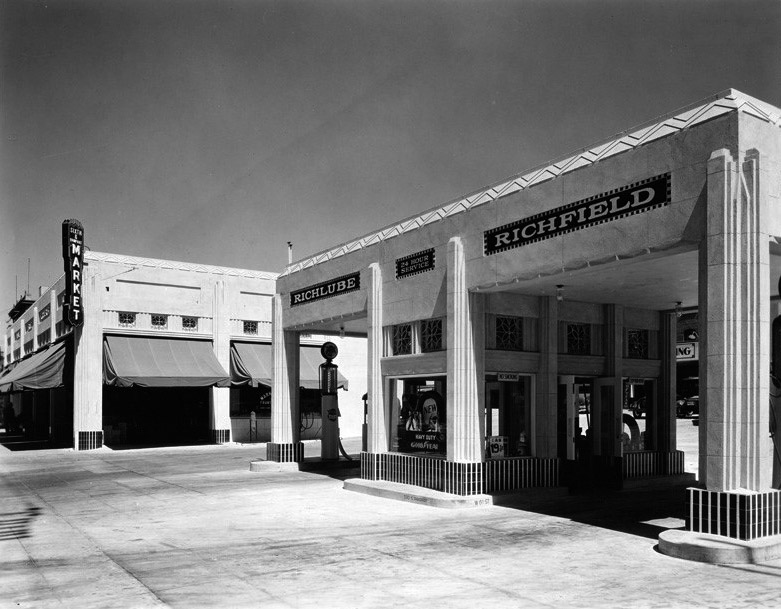 |
|
| (1930s)**^* – View showing the Richfield Market and Service Station located at 6th & Rampart, Los Angeles. |
Historical Notes Between the mid-1910s to the early 1940s, Los Angeles was the principal center for the development of drive-in markets, many of which had gas stations. |
* * * * * |
Sunset Clock Market and Service Sation (Wilshire and Hamilton)
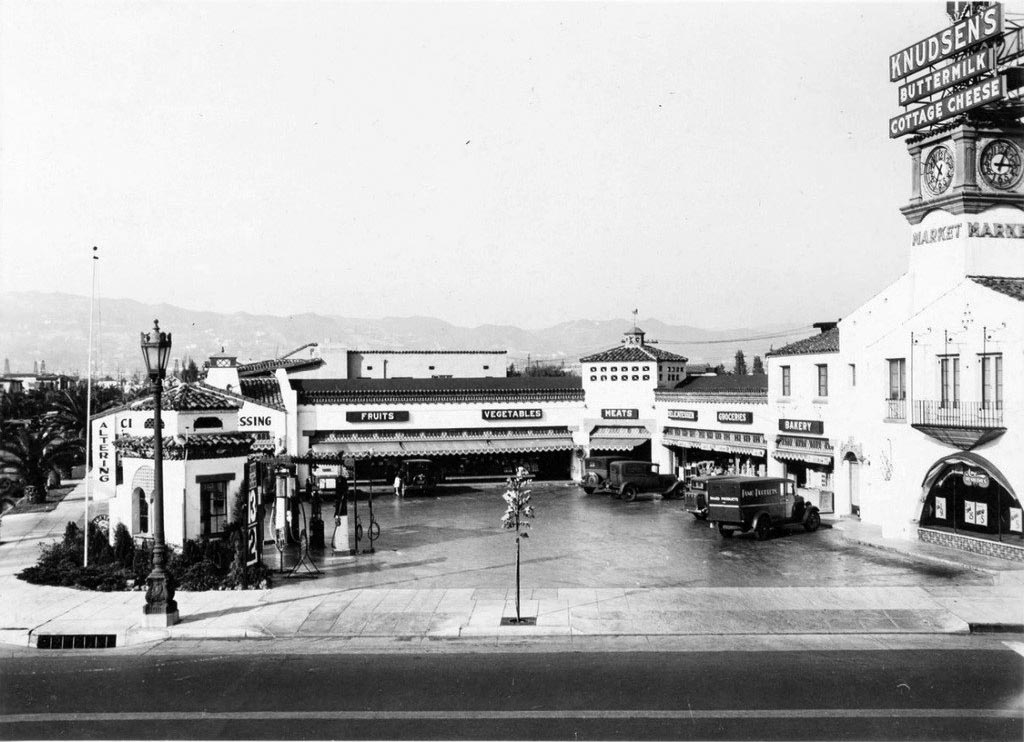 |
|
| (1932)++^ – View looking north showing the Sunset Clock Market and Service Station on the northeast corner of Wilshire Boulevard and Hamilton Drive. Note the clock tower on the right. This corner would later become a Plymouth Dealership (Click HERE to see more). |
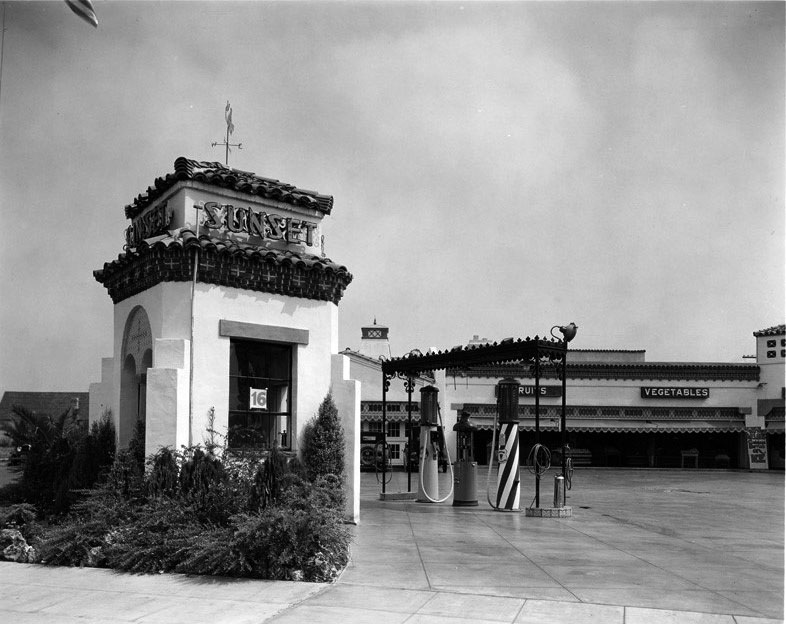 |
|
| (ca. 1930)^*# - Street view showing the gas station at the Sunset Clock Drive-up Market, northeast corner of Wilshire Boulevard and Hamilton Drive (one block east of La Cienega Boulevard). |
* * * * * |
Al Monroe Union Station (North Hollywood)
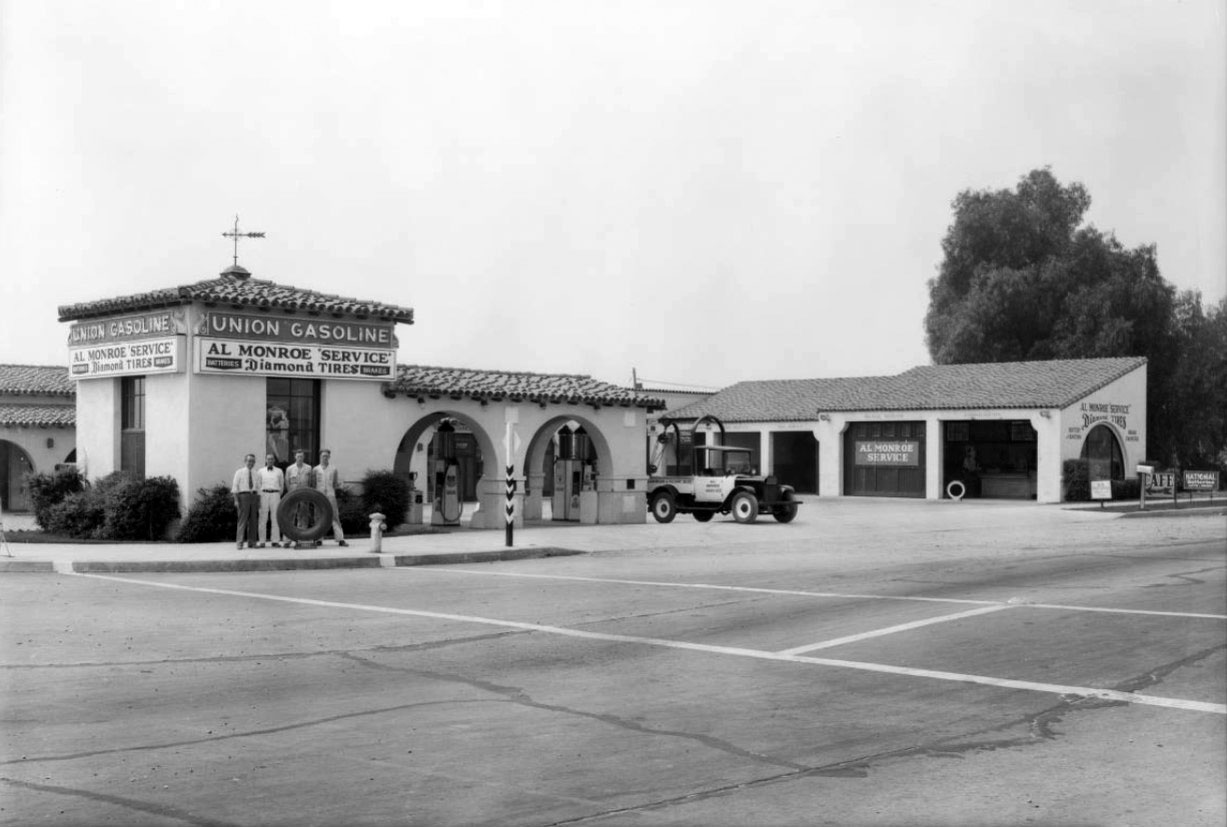 |
|
| (1930)* - Al Monroe station in North Hollywood at the corner of Lankershim Boulevard & Victory Boulevard. Four men standing behind a tire pose for the camera in front of the service station. |
* * * * * |
Al Monroe Service Station (Beverly Hills)
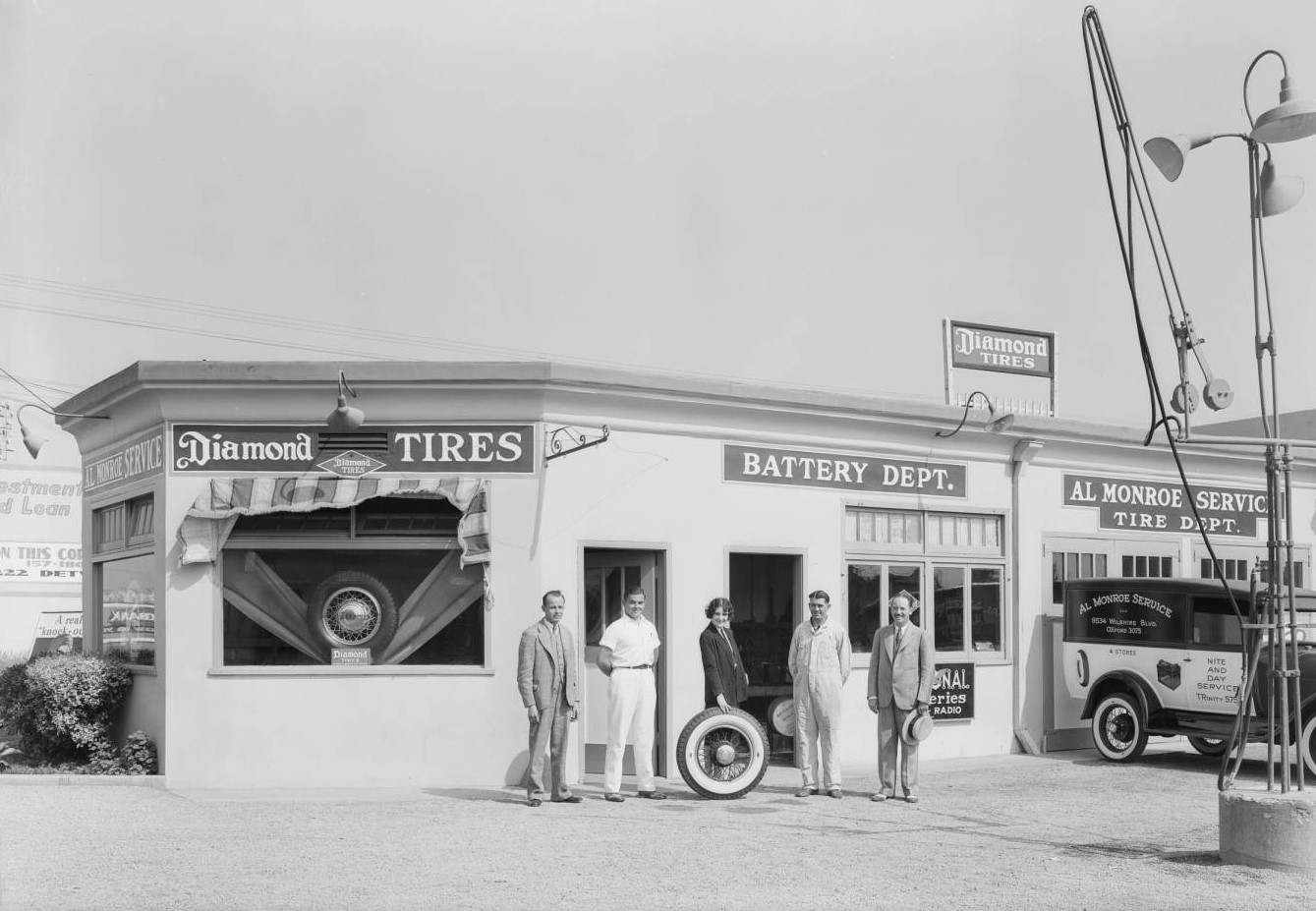 |
|
| (1930)* - Four men and a woman pose for the camera by a tire and the main office of Al Monroe Service Station located at Le Doux Road and Wilshire Boulevard in Beverly Hills. This was a promotion shot for Diamond Tires which at the time was made by the B.F. Goodrich Co. |
Historical Notes In March of 1912, the Diamond Rubber Company was bought out by and merged with the B.F. Goodrich Company. The Diamond brand name and product line were retained and a subsidiary Diamond Rubber Company created for the marketing and manufacturing of them. |
* * * * * |
Signal Pull-Purr Service Station (Beverly Hills)
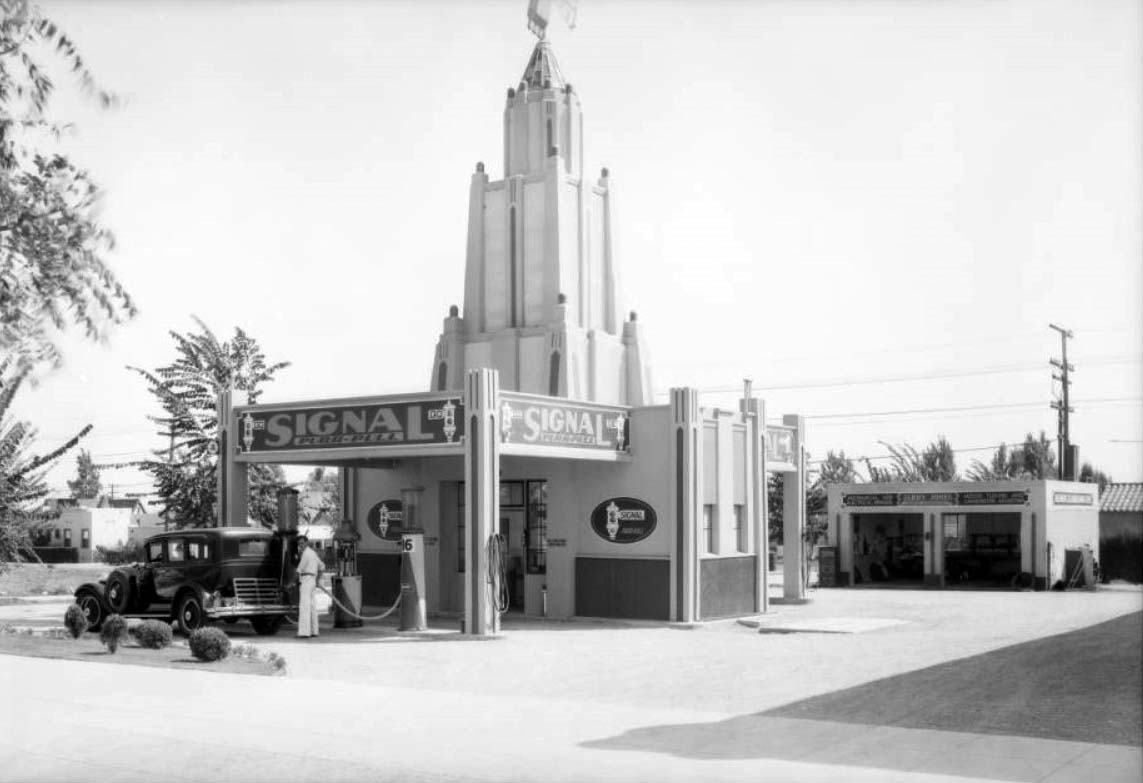 |
|
| (1931)^^ – Attendant pumping gas at a Signal Purr-Pull service station with Art Deco tower, located in Beverly Hills. |
* * * * * |
Specification System Service Station
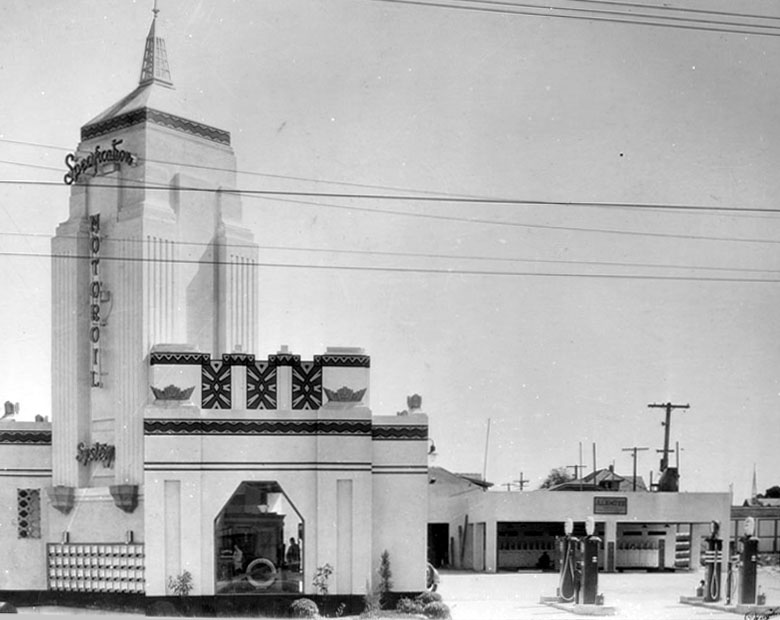 |
|
| (ca. 1930s)^ - View of Specification Motor Oil System Service Station on the southwest corner of Washington and 8th Ave. |
Historical Notes Apparently the "Specification Motoroil System" was a national chain that did not last too long (no records). |
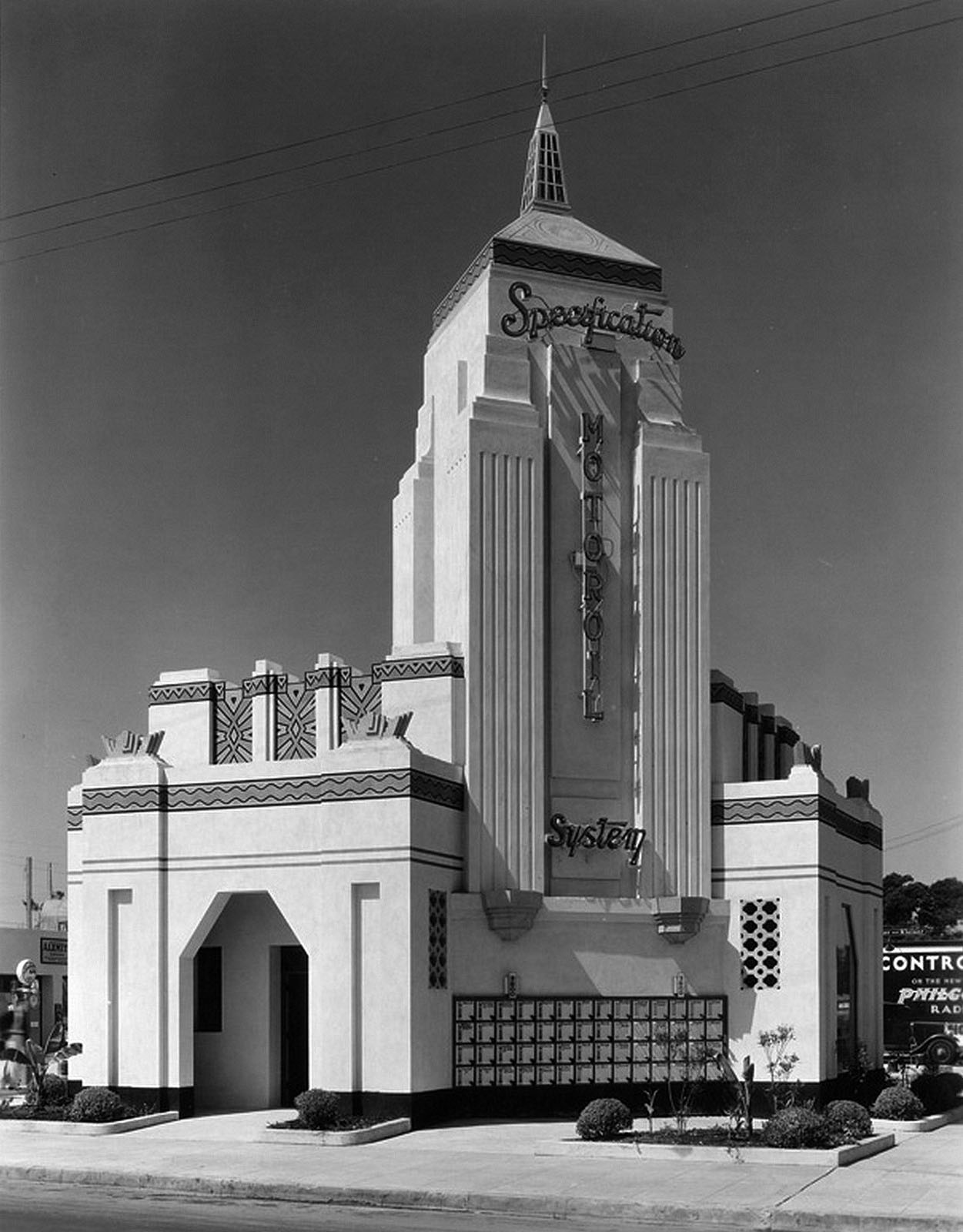 |
|
| (ca. 1930s)**^* - Closer View of the Art Deco designed Specification System Service Station at Washington Blvd. and 8th Ave, SW corner. |
* * * * * |
Gilmore Blu-Green Gas Station (Sherman Oaks)
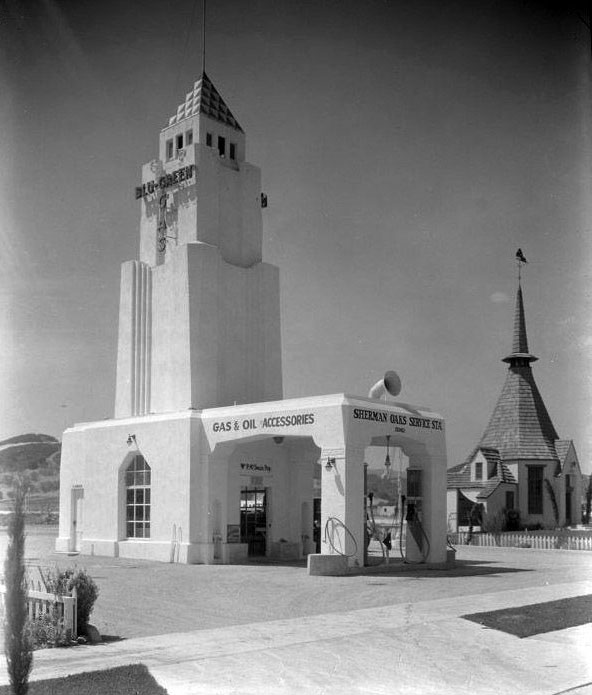 |
|
| (1930s)**^* – View of the Art-Deco style Sherman Oaks Service Station located at 15362 Ventura Blvd, southeast corner of Ventura Blvd. and Sherman Oaks Ave. Looks like the design was inspired by LA City Hall. |
* * * * * |
Violet Ray Gas Station (Hollywood)
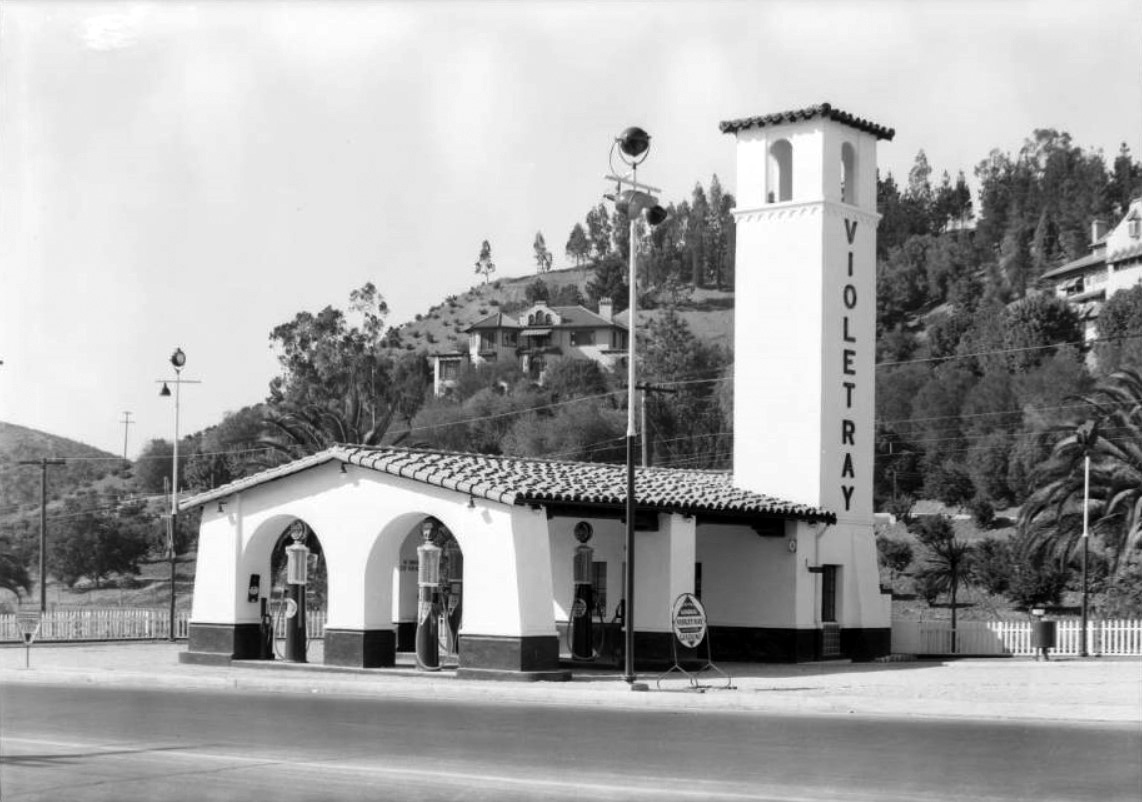 |
|
| (1930)^^ – View showing a General Petroleum Corporation Violet Ray Gas Station on North Cahuenga Boulevard in Hollywood. |
Historical Notes Violet Ray Gasoline was a unique type of gas introduced in 1928 by the General Petroleum Corporation. What made this fuel special was its violet color. General Petroleum wanted to market a superior anti-knock product which would fulfill all the requirements of high-compression type engines, as well as function perfectly in all other types of motors. It was developed in a violet color that would change if it was exposed to any inferior motor fuel. |
Violet Ray Gas Station (830 S. La Brea)
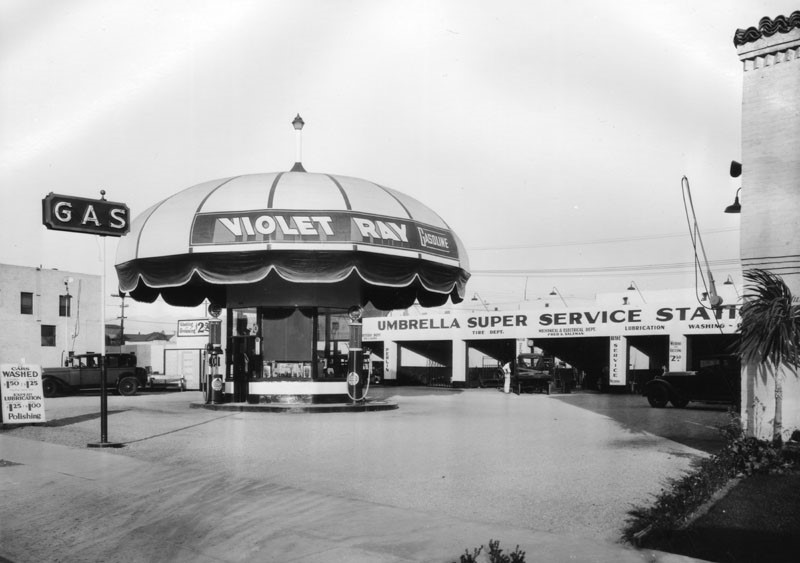 |
|
| (1930s)^ - View showing the Umbrella Super Service Station (Violet Ray) and its many services, located at 830 S. La Brea Ave. |
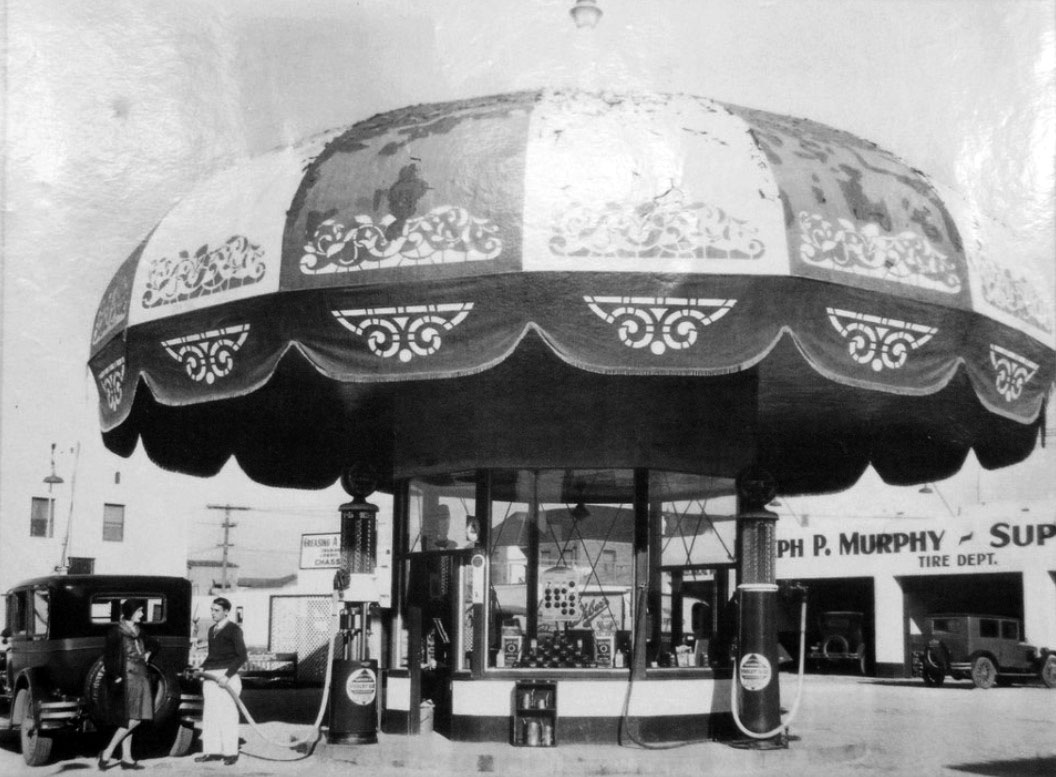 |
|
| (1930s)^*^# - The Umbrella Service Station, General Petroleum Gas on La Brea Ave. By 1946, the gas station was gone and a retail strip center was built on the site. |
* * * * * |
Union Service Station
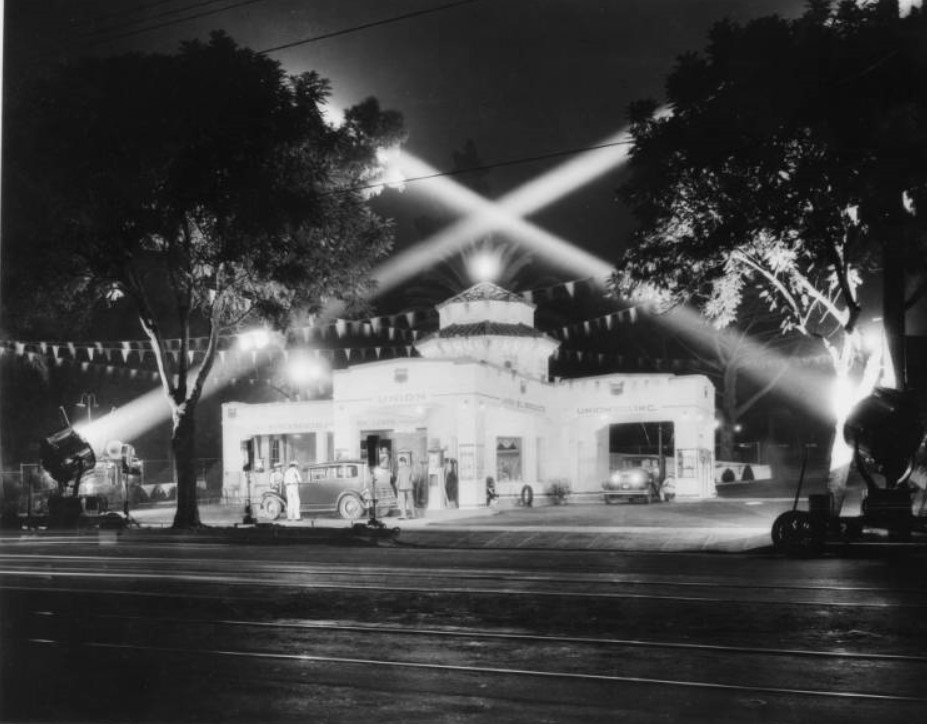 |
|
| (1932)^^ – Night view of what appears to be the grand opening of a Union Station. |
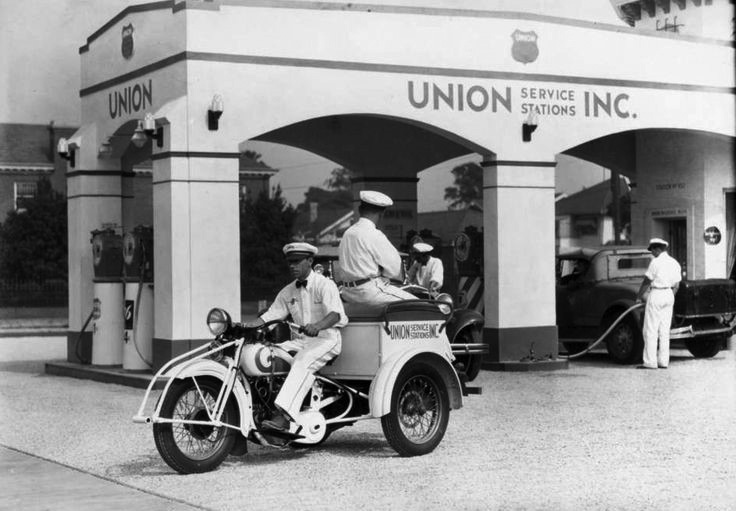 |
|
| (1932)#* - A Union Service Station cyclist to the rescue at 4004 Wilshire Blvd. |
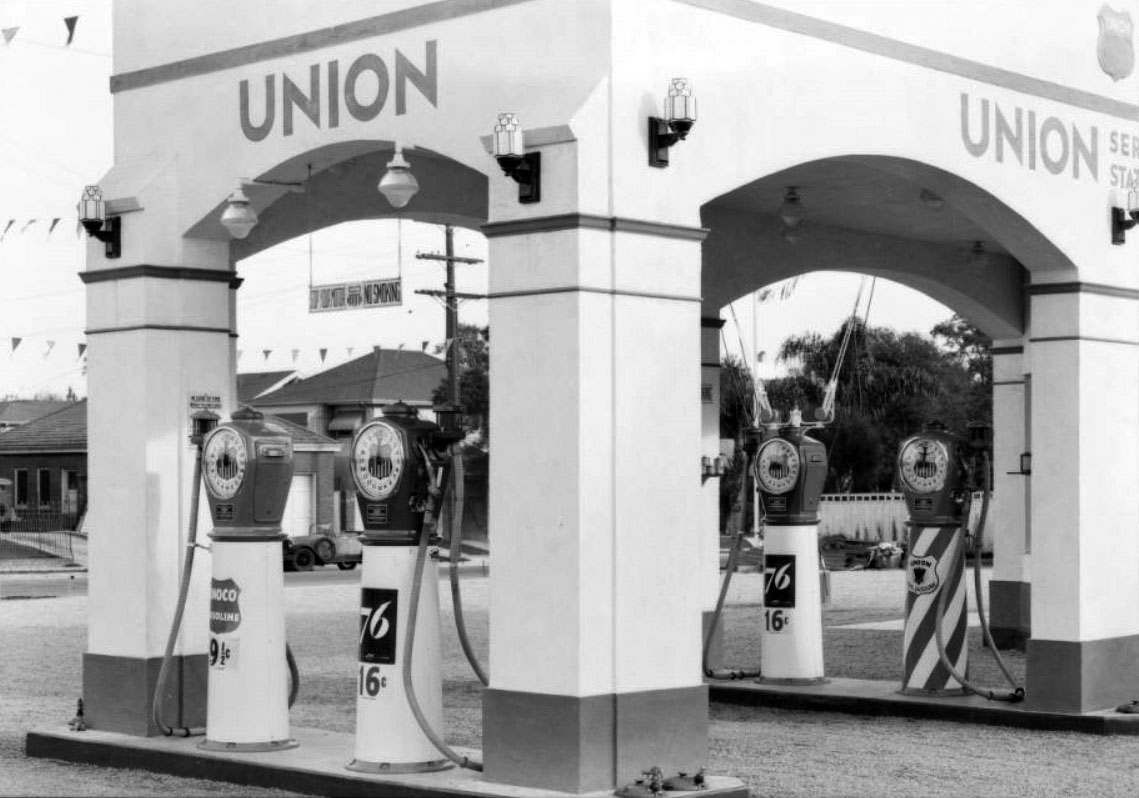 |
|
| (1932)^^ - View showing the pumps at Union Oil station located at South Wilton Place and Wilshire Boulevard, Los Angeles. |
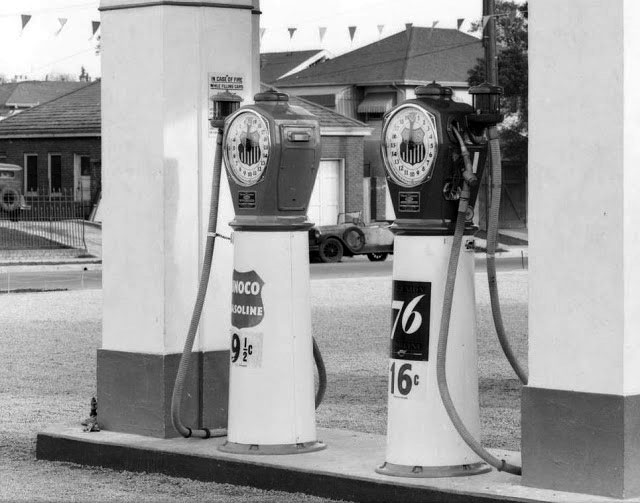 |
|
| (1932)^^ - Closer view showing two of the pumps at the Wilshire Blvd and Wilton Place Union Oil station. Note the price of gas: 9½¢ and 16¢ per gallon! |
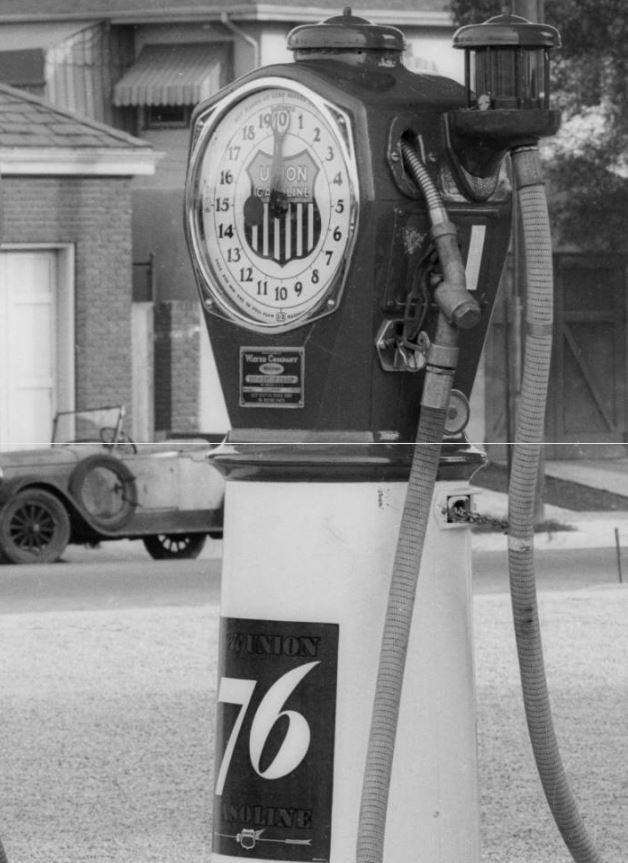 |
|
| (1932)^^ – Detailed look at one of the higher octane Union 76 pumps. |
Historical Notes Union Oil (for many years based in El Segundo, California) introduced "76" gasoline in 1932. The name referred to the 1776 United States Declaration of Independence, and was also the octane rating of the gasoline in 1932. ^ |
.jpg) |
|
| (1931)**^ - 'Full Service' at Union Oil Compnay service station. |
* * * * * |
Goodyear Tire Store and Gas Station (La Brea and 2nd)
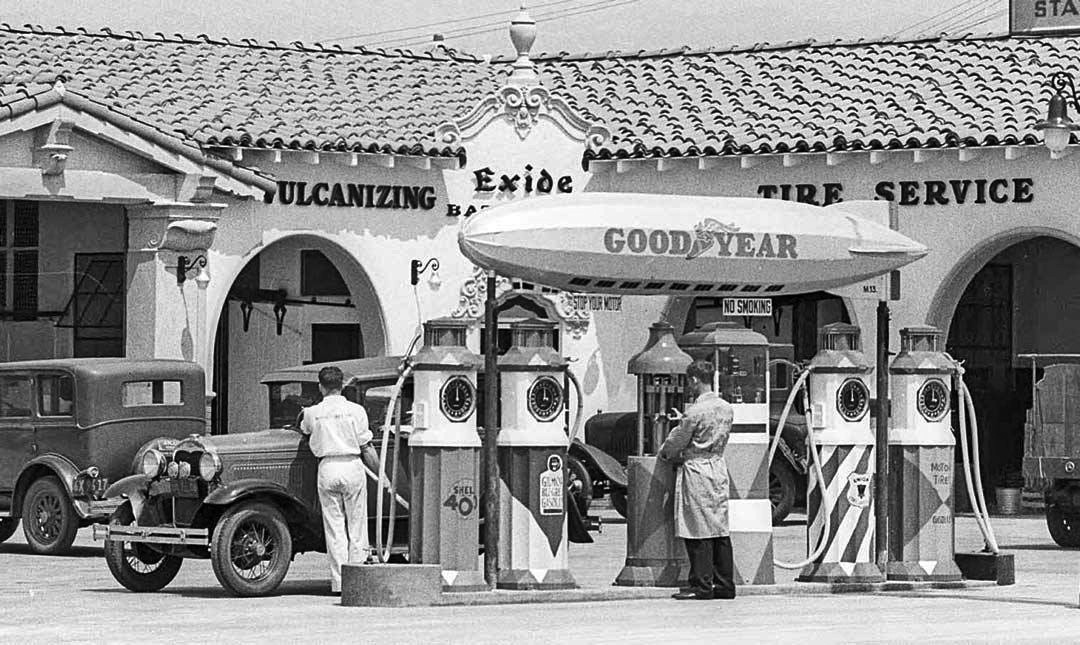 |
|
| (1931)^x^ – View showing two attendants working at a service station with miniature Good Year blimp over pumps, located on the corner of S. La Brea and W. 2nd Street in Los Angeles. |
Historical Notes This Goodyear tire store opened at West 2nd St and South La Brea Ave, Los Angeles, in 1931. In order to catch the eye of passing motorists, most Goodyear tire operations featured a miniature blimp over the gas pump island. Being independently operated, they were able to offer four different brands of gas: Shell “40,” Gilmore “Blu-Green,” Union, and “Motor Tire”—and THAT is something we don’t see anymore.^ |
* * * * * |
Standard Service Station and Repair Shop
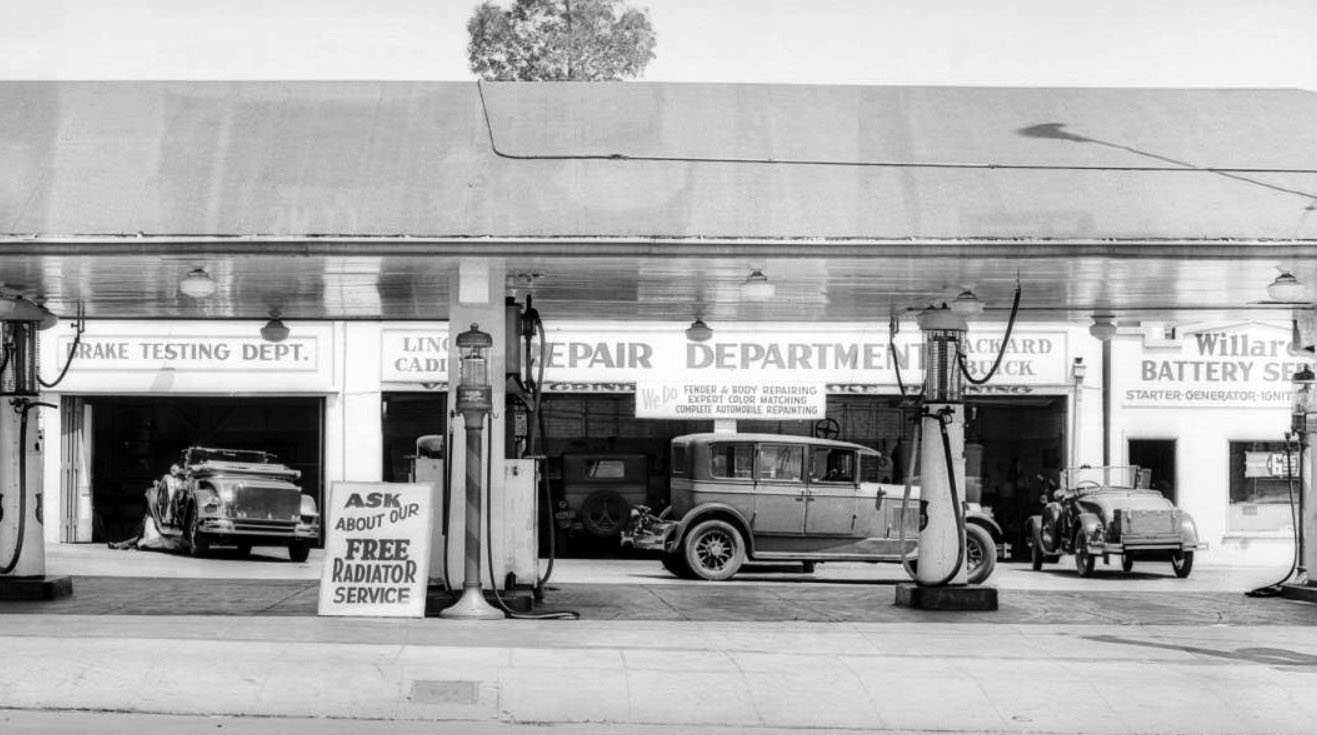 |
|
| (1931)^^ – Wide angle view showing a Standard Service Station located at 1425 W. Pico Boulevard. In the rear can be seen the Brake Testing Department, Repair Department, and Willard's Battery Service. Sign in front reads: "Ask About Our Free Radiator Service" |
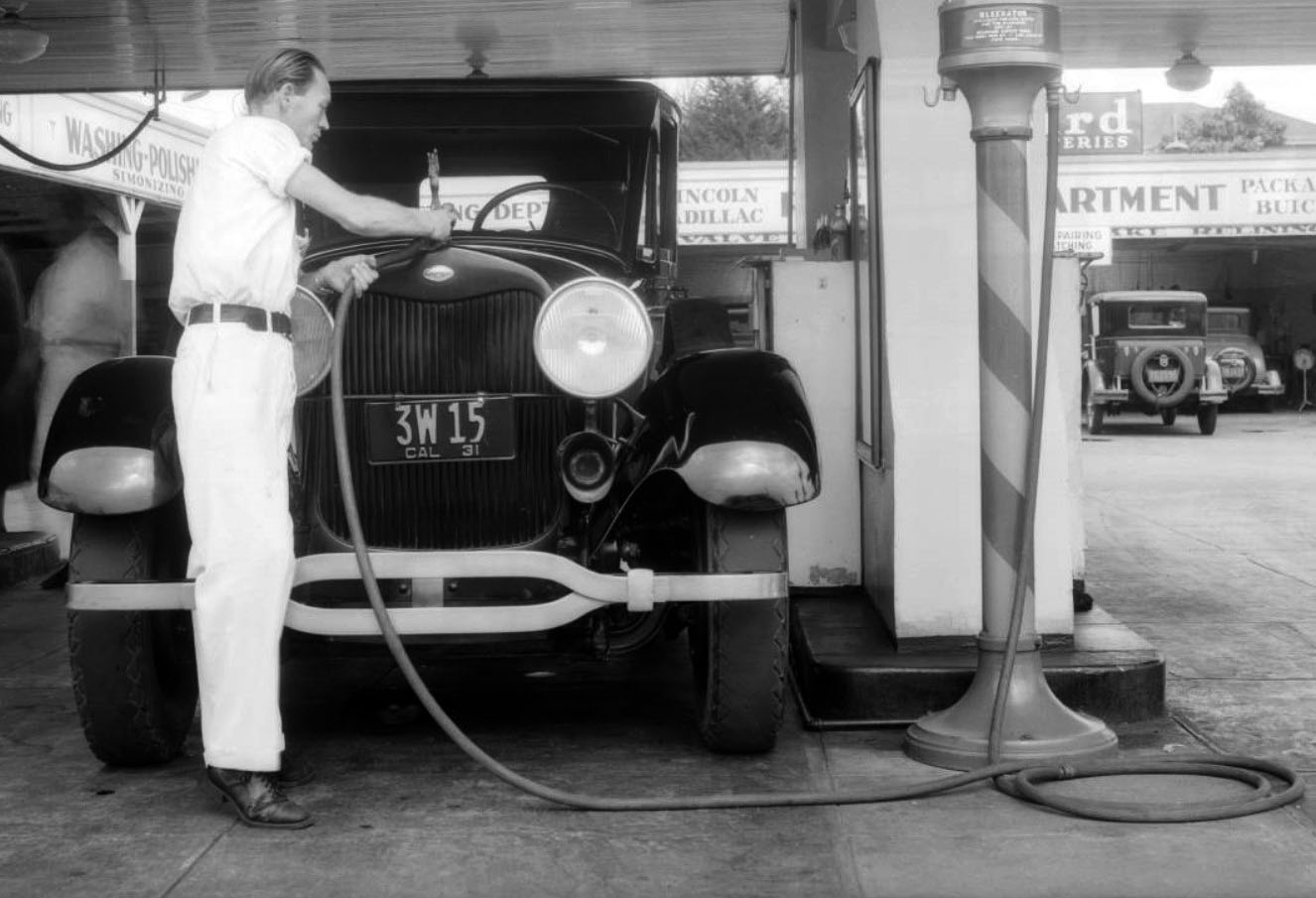 |
|
| (1931)^^ – Close-up view showing an attendant topping off radiator with water hose at the Standard Service Station on Pico. |
* * * * * |
Standard Service Station
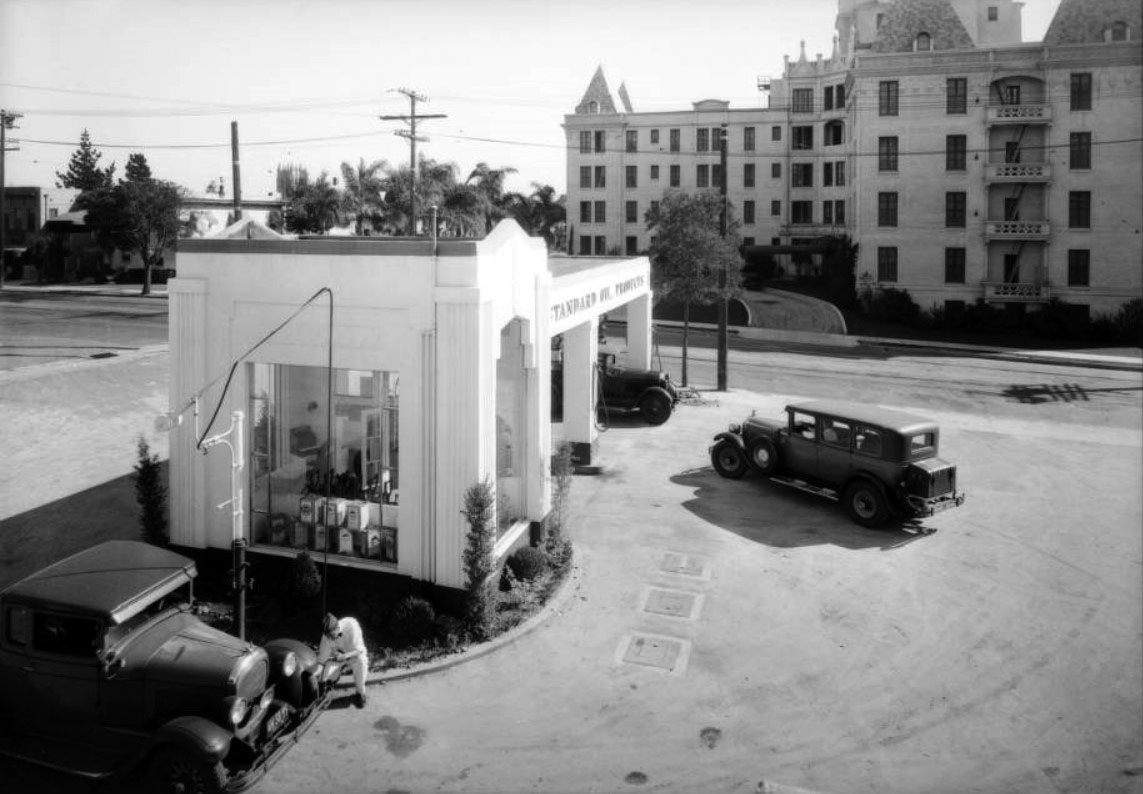 |
|
| (1931)^^ – View showing a Standard Service Station with attendant at lower-left filling tires with air. A large apartment building is seen across the street. |
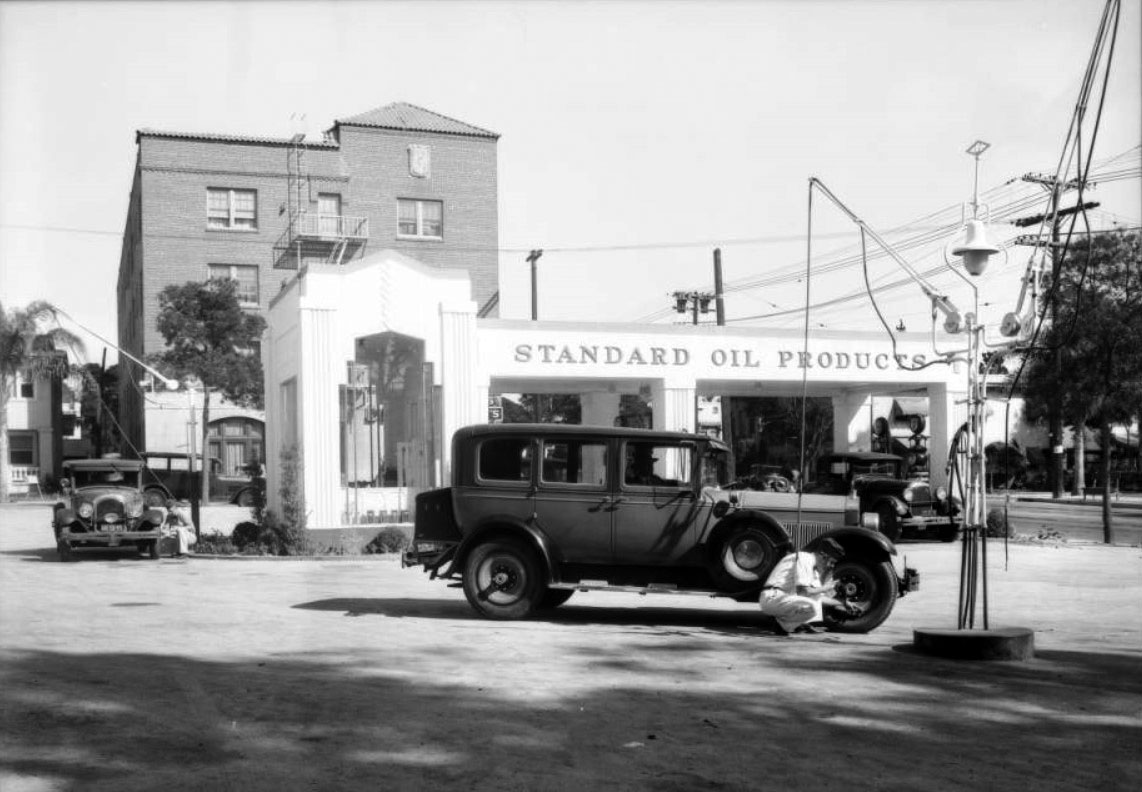 |
|
| (1931)^^ – Close-up view of same Standard Station showing two attendants operating the air pumps, one at lower-left and the other in the foreground. Sign above gas pumps reads: “Standard Oil Products” |
* * * * * |
Ragsdale & Hansen's $ Station No. 1
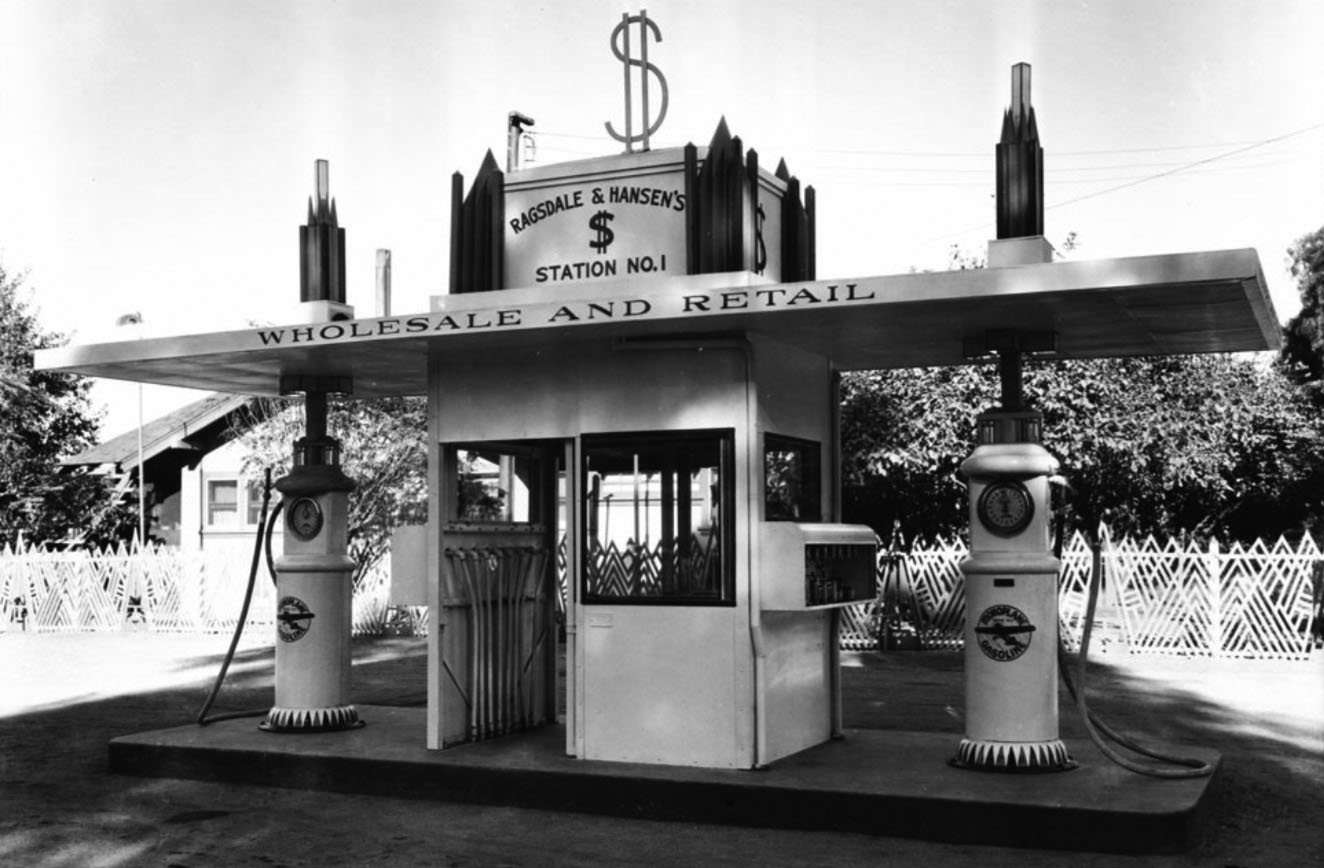 |
|
| (1930s)**^* - "Ragsdale & Hansen's $ Station No. 1", a Los Angeles gas station which advertises wholesale and retail. Two pumps stand on either side of the small office of the station at center, each with signs that read "Monoplane Gasoline". A large "$" sign sits on the roof of the station with the title directly below it. A fence stands behind the station containing the trees just behind it. A house can be seen through the thick trees on the left. |
* * * * * |
Union Service Station (Wilshire and Hobart)
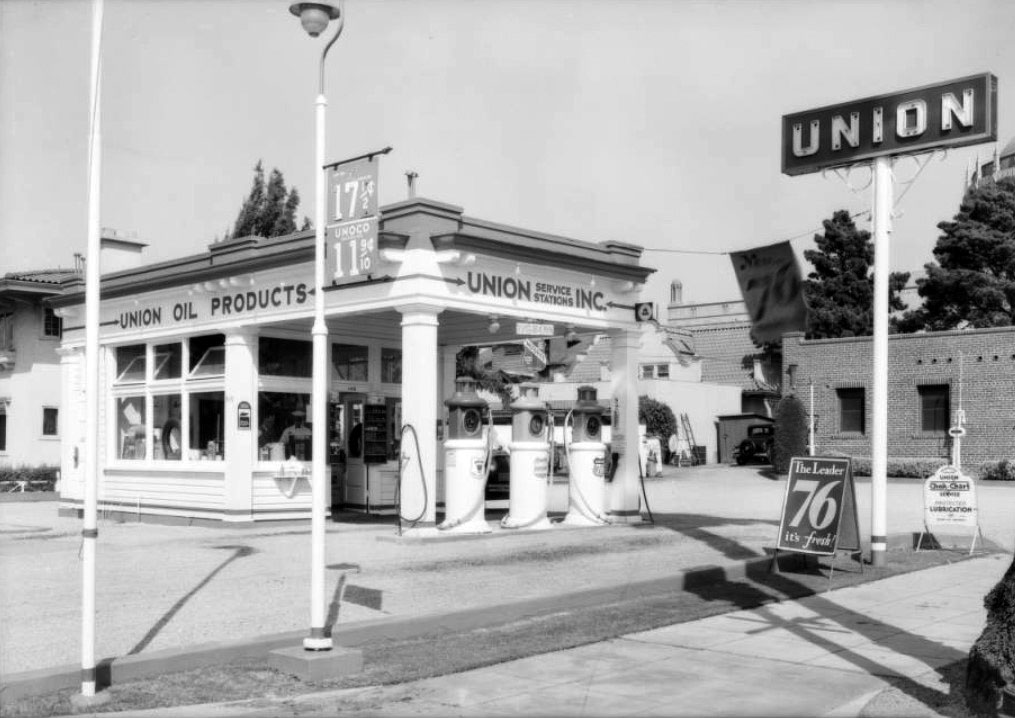 |
|
| (1932)^^ – View looking northeast showing a Union Oil Service Station located on the 3700 block of Wilshire Boulevard. Note the gas prices. |
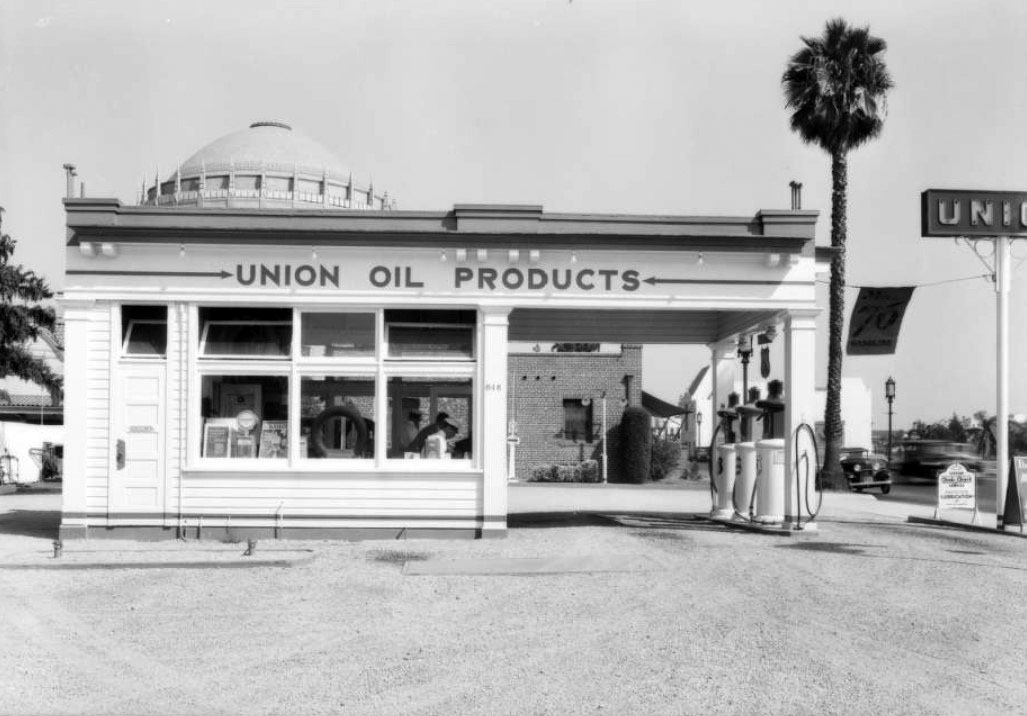 |
|
| (1932)^^ – Side view of the Union Service Station looking east with Wilshire Boulevard seen on the right. The dome of the Wilshire Boulevard Temple (NE corner of Wilshire and Hobart) can be seen above the roofline in the distance. |
* * * * * |
CALPET Service Station (California Petroleum - Wilshire and New Hampshire)
.jpg) |
|
| (1927)^ - View showing the grand opening of CALPET (California Petroleum) Service Station located at 3237 Wilshire Boulevard. |
Historical Notes Upon its completion in 1927, the facility was touted by CALPET as “California’s finest super service,” and not without good reason. The central filling station occupied an eye-catching Moorish Revival building, elegantly ornamented with mosaic tile trimmings and decorative grilles. A separate structure at the rear of the lot housed an automatic washing and polishing unit, tire and battery service areas, an accessory shop, and a small cafe. As a final touch, the station’s paved areas were buffered from the sidewalk by lamp posts and small landscape planters.* |
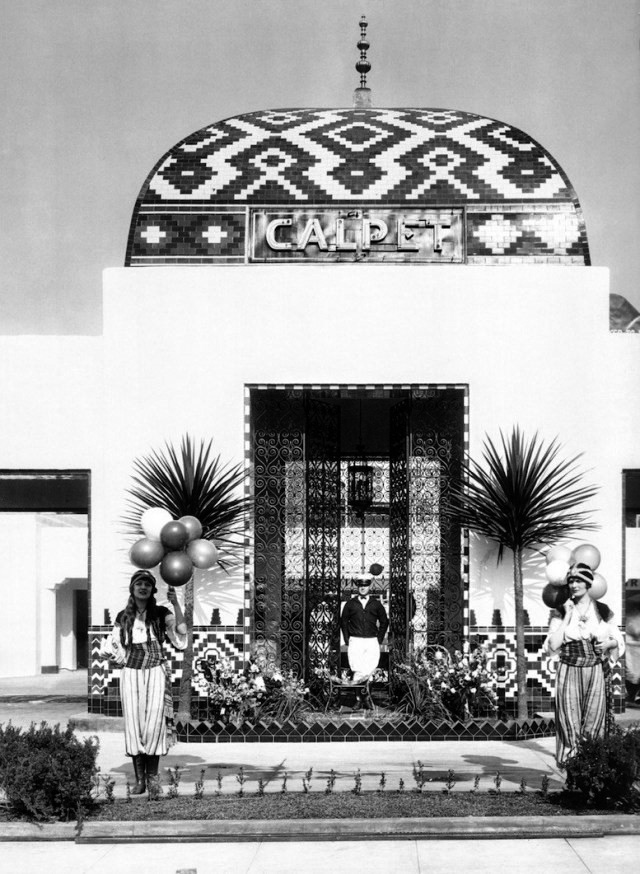 |
|
| (1927)^.^ - Close-up view showing two women dressed in pantaloons, blouses, sashes and boots while holding balloons with a uniformed attendant standing behind them in front of an ornate entrance gate at the CALPET Service Station. Note the Art Deco Zig-zag decorative tile trim on dome. |
Historical Notes The new service station was given such importance by California Petroleum (Calpet) that it received a two-day opening ceremony as well as a full-page advertisement in the Los Angeles Times. In true Hollywood fashion, Calpet orchestrated the opening-day appearance of a number of film stars, including Norma and Constance Talmadge, Owen Moore, Ralph Graves, Lawrence Gray, Belle Bennett, Buster Keaton, and Katherine Perry. Each of them of course, arrived by car. By the time its second day closed out with a colorful light show, the service station had sold nearly 20,000 gallons of gasoline.* |
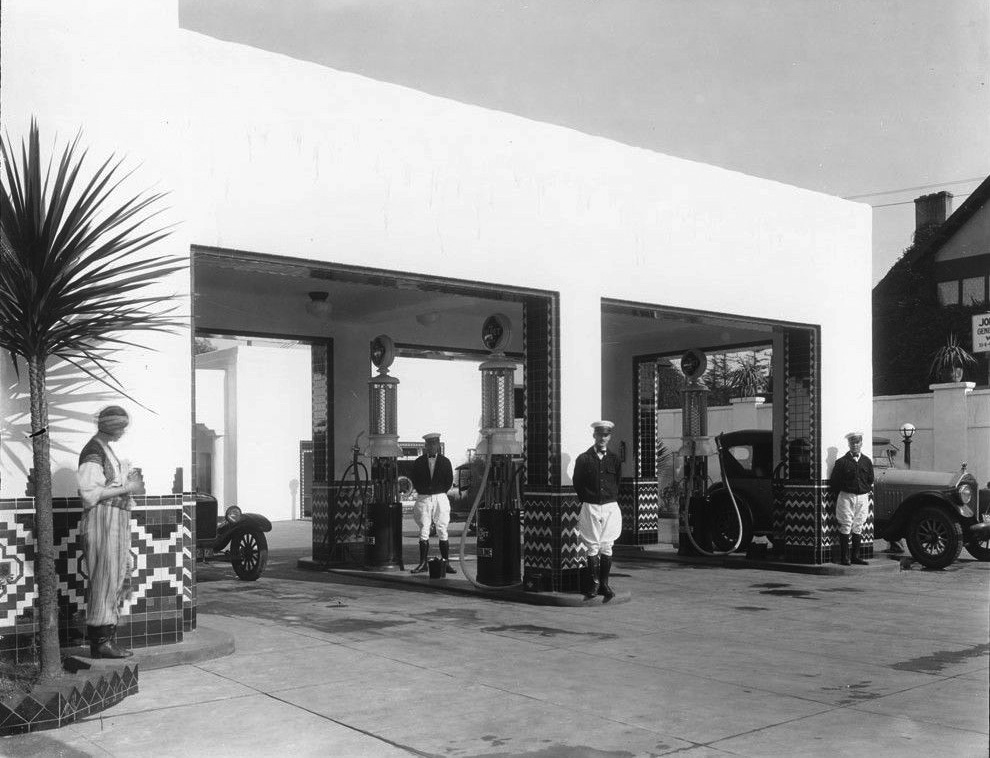 |
|
| (1927)^^ - Close-up view showing nattily-attired attendants with white jodhpurs, black boots and jackets. A women in Tunisian-inspired clothing stands to the left while the attendants stand next to the pumps with their hands behind their backs. |
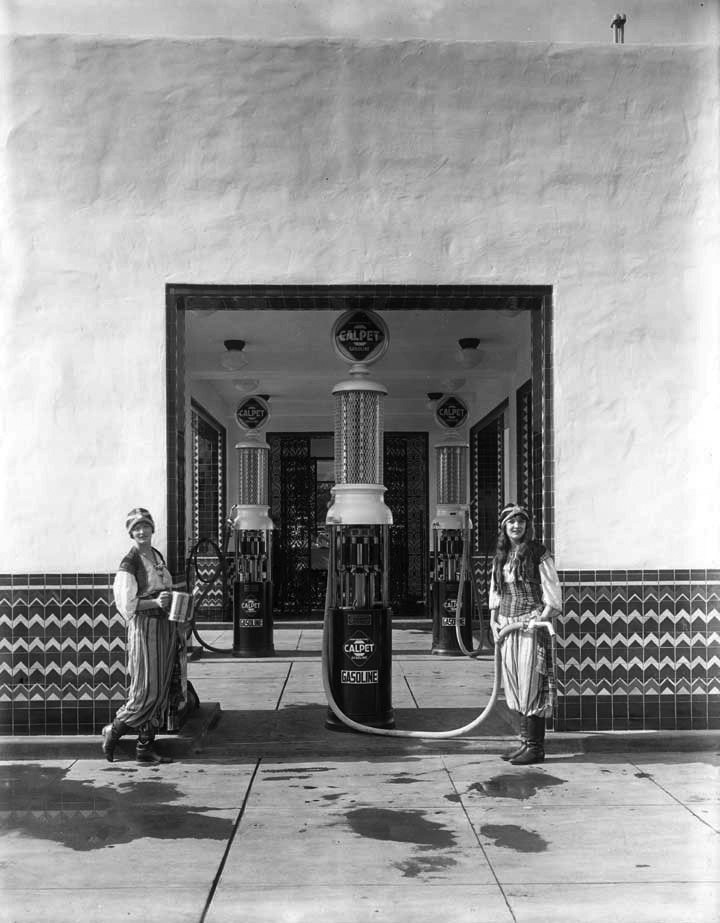 |
|
| (1927)* – Two women in Tunisian-style clothing pose for the camera in front of the gas pumps. One is holding an oil can while the other a gasoline hose. |
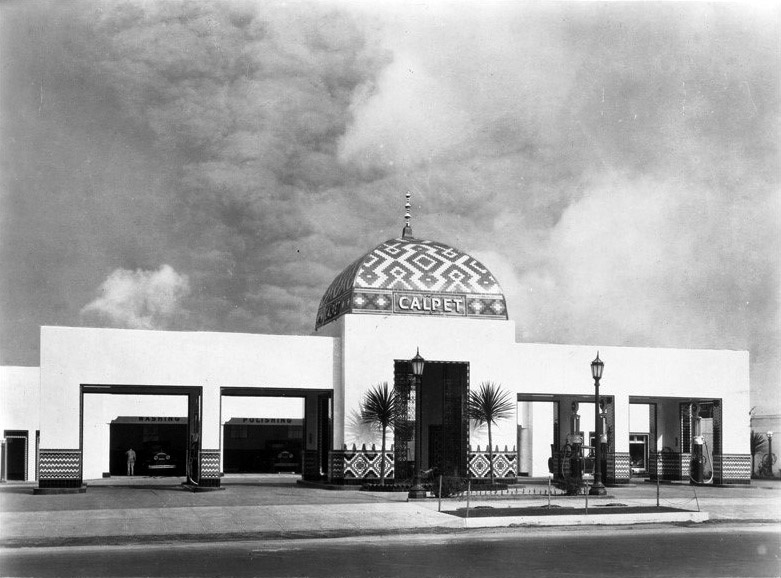 |
|
| (1928)**^* - View showing the CALPET Service Station, after the grand opening. It would soon become a Texaco station. |
Historical Notes CALPET was acquired by the Texas Company in 1928 and the service station seen above continued to operate under the Texaco brand until its demolition in the mid-1950s. |
* * * * * |
Texaco Service Station (previously CALPET Service Station)
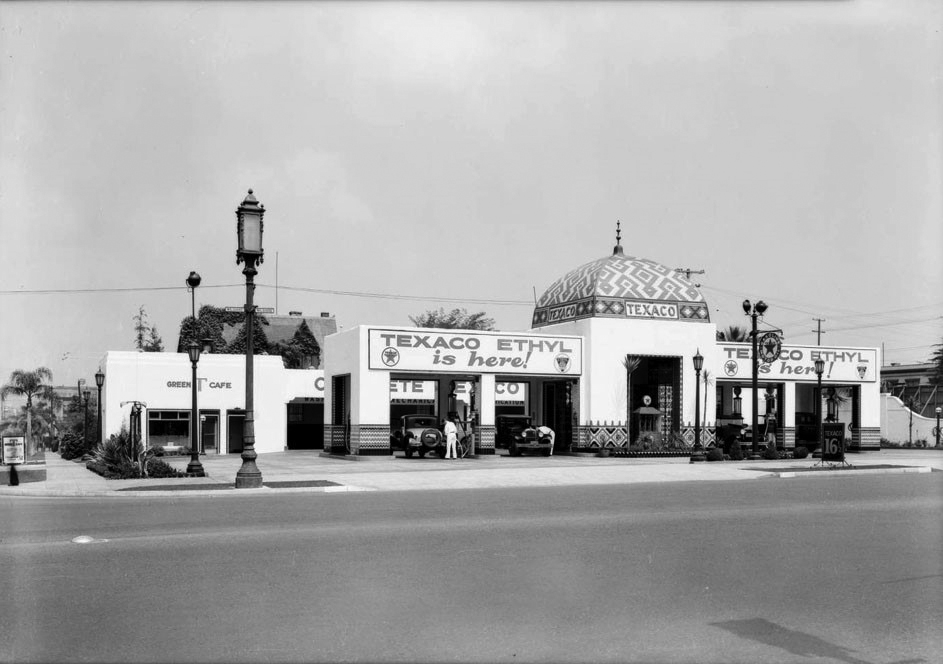 |
|
| (1930s)^^ – View showing the Texaco Service Station (originally Calpet Service Station) with a Moorish-style roof, located across the street from the Cole House and later the I. Magnin store, southeast corner of Wilshire and New Hampshire Avenue. Note the Green T Café on the left. |
Historical Notes As Wilshire Boulevard cemented its status as Los Angeles’ premier highway during the 1920s, it also emerged as the locus of high-end commercial development for the city’s affluent and growing west side. This dual identity was exemplified by the California Petroleum Corporation’s flagship Calpet service station (1927-1928) and then Texaco service station (1928-mid 50’s), shown in the photo above at the boulevard’s northeast corner with New Hampshire Avenue. Although the demolished depot has now been largely forgotten, it surely ranks among the most distinctive lost buildings of Wilshire Boulevard. |
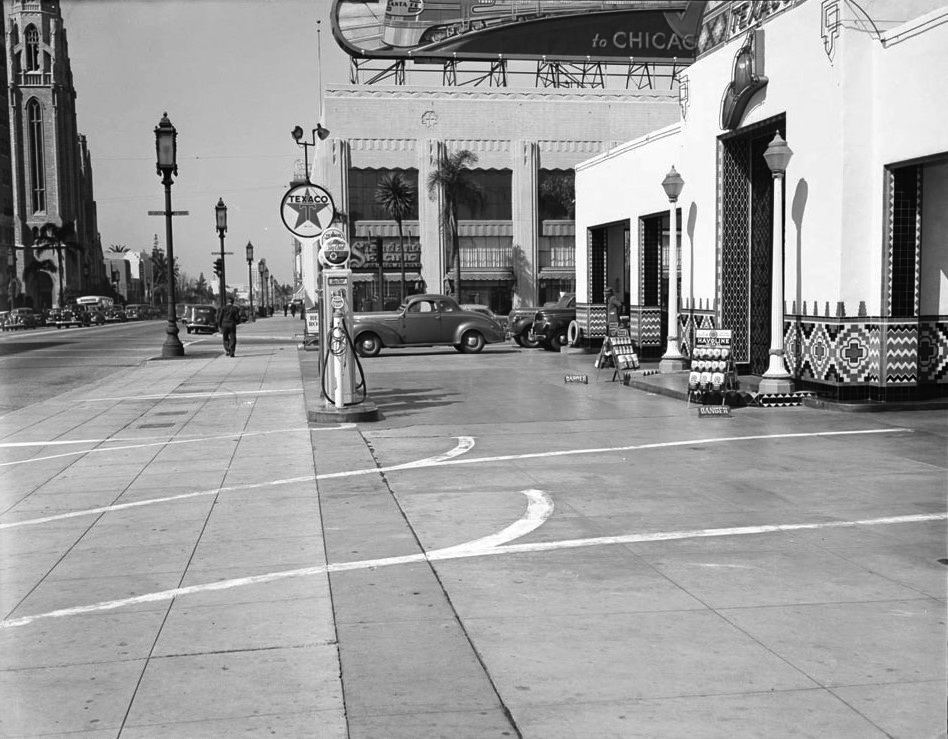 |
|
| (1940)^^ - View looking west on Wilshire Boulevard from the sidewalk in front of the Texaco Service Station located on the SE corner of Wilshire and New Hampshire Ave. Note the tiled entrance fronted by two ornate lamps. |
Historical Notes The beautiful Moorish-style Texaco service station stood until the mid-1950s. In 1956, it was replaced by a Modernist office building and adjacent parking lot, built for the Pioneer Savings and Loan Association. The relatively unremarkable six-story building remained occupied by bank tenants through the late 1980s. Since then, it has served as the Consulate General of the Republic of Korea in Los Angeles.* |
* * * * * |
Calmos Union 76 Service Station (Hollywood)
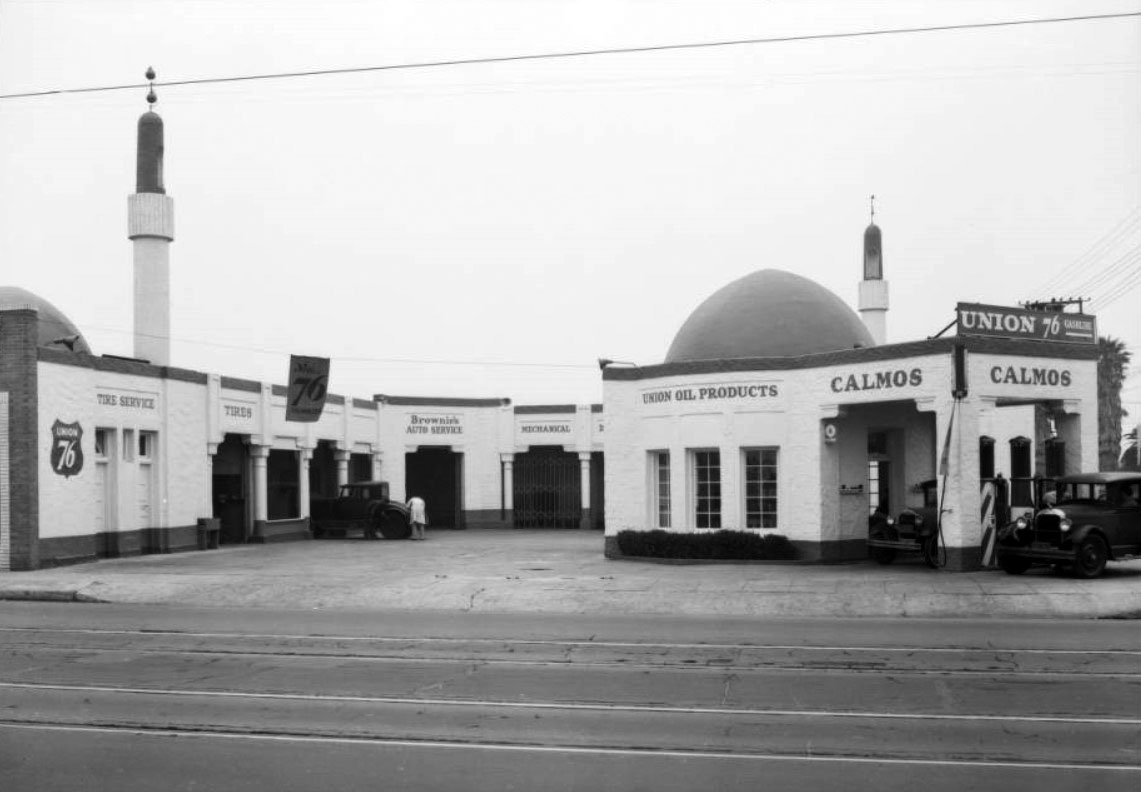 |
|
| (ca. 1932)* – View showing the mosque-like Calmos Union 76 Service Station complete with three domes and two minarets located on the S/E corner of North Alexandria Ave and Hollywood Blvd. Note the tracks on Hollywood Boulevard. |
Historical Notes Although the gas station has been razed and the remaining buildings converted into a strip mall, the original two minarets are still there. |
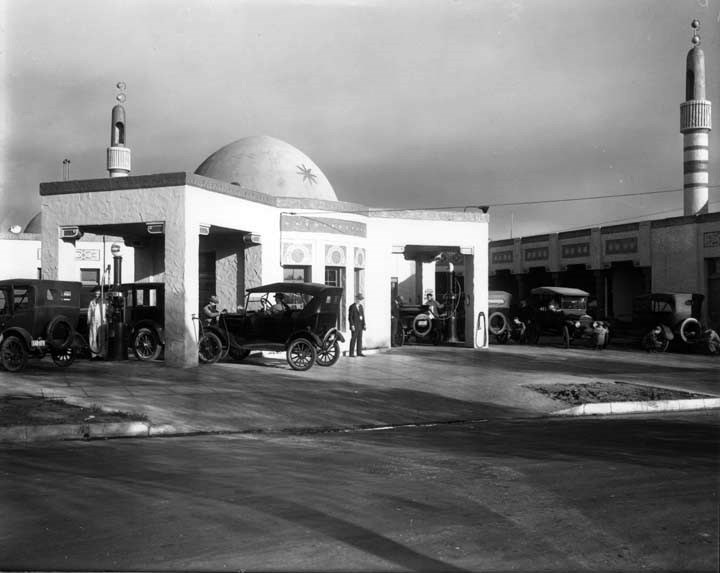 |
|
| (ca. 1924)* – View looking southeast showing the Calmos Auto Service Station as seen from Alexandria Avenue. |
Then and Now
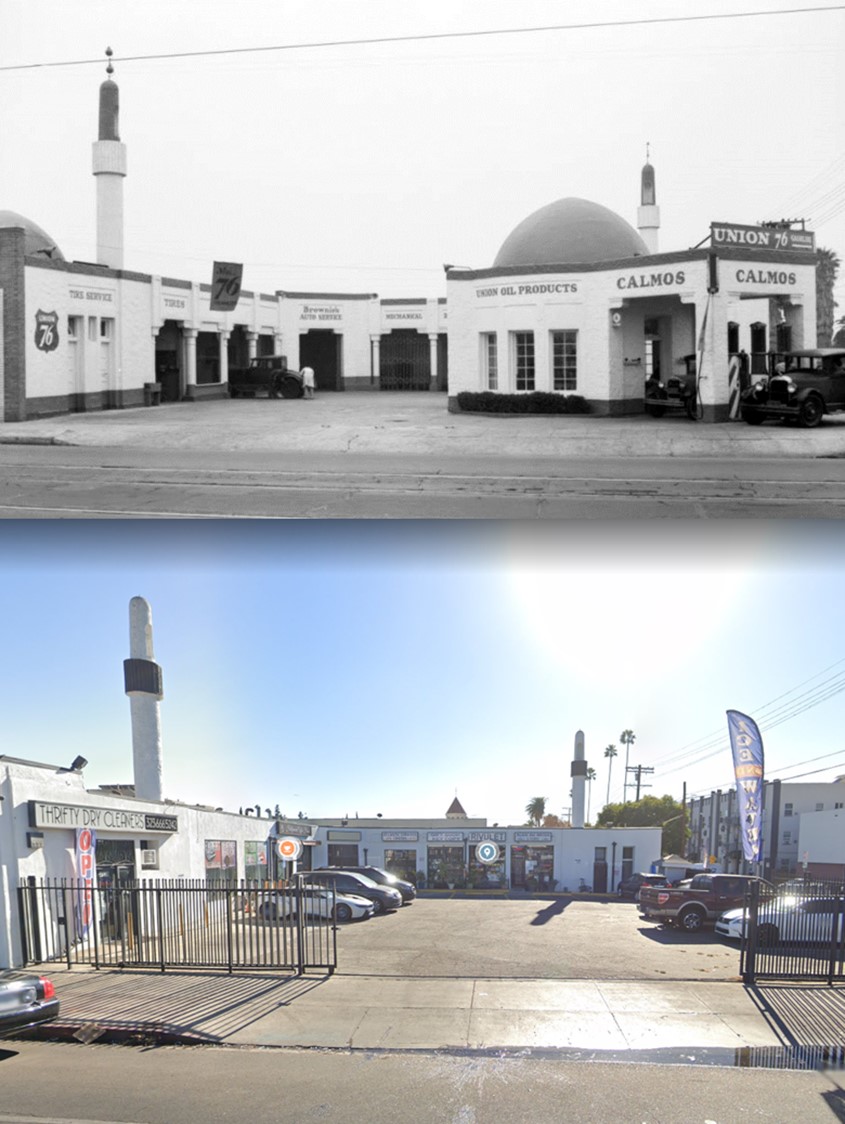 |
|
| (1932 vs 2022)* – Looking at the SE corner of Hollywood Boulevard and Alexandria Avenue showing (at top) Calmos Union 76 Service Station complete with three domes and two minarets and (below) a strip mall. |
* * * * * |
West-Way Super Service Station (Western and Harold Way)
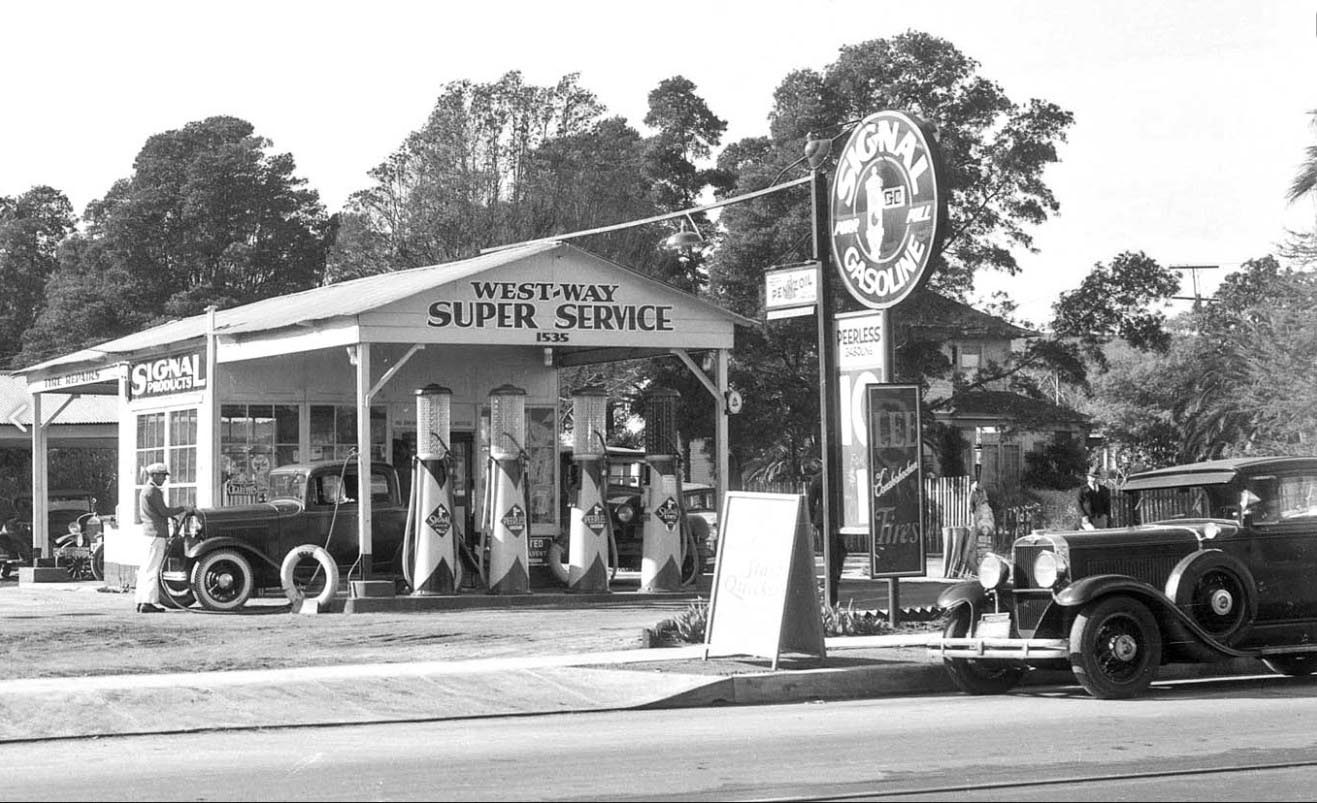 |
|
| (1933)* – View showing the West-Way Super Service Station located at on the southwest corner of Western Avenue and Harold Way in Hollywood. |
Historical Notes This gas station, located at 1535 N. Western Avenue, was initially run by the partnership of John A. Jordan and Milton E. Jaeckel. They previously were operating two gas stations at 5873 Hollywood Boulevard and 1353 N. Western Avenue. They opened this facility either in 1931 or 1932. The West-Way Super Service Station went out of business by sometime in 1936. ^^* |
.jpg) |
|
| (1933)* - Two attendants provide full service on a 1932 Ford V-8, five window coupe at the pump of the West-Way Super Service Station at 1535 N. Western Avenue. |
Historical Notes Three different types of gasoline where sold at the facility: Signal Ethyl Purr Pull, which was dyed purple, Signal Regular, and low-priced Signal Peerless that sold for ten gallons for a dollar. ^^* |
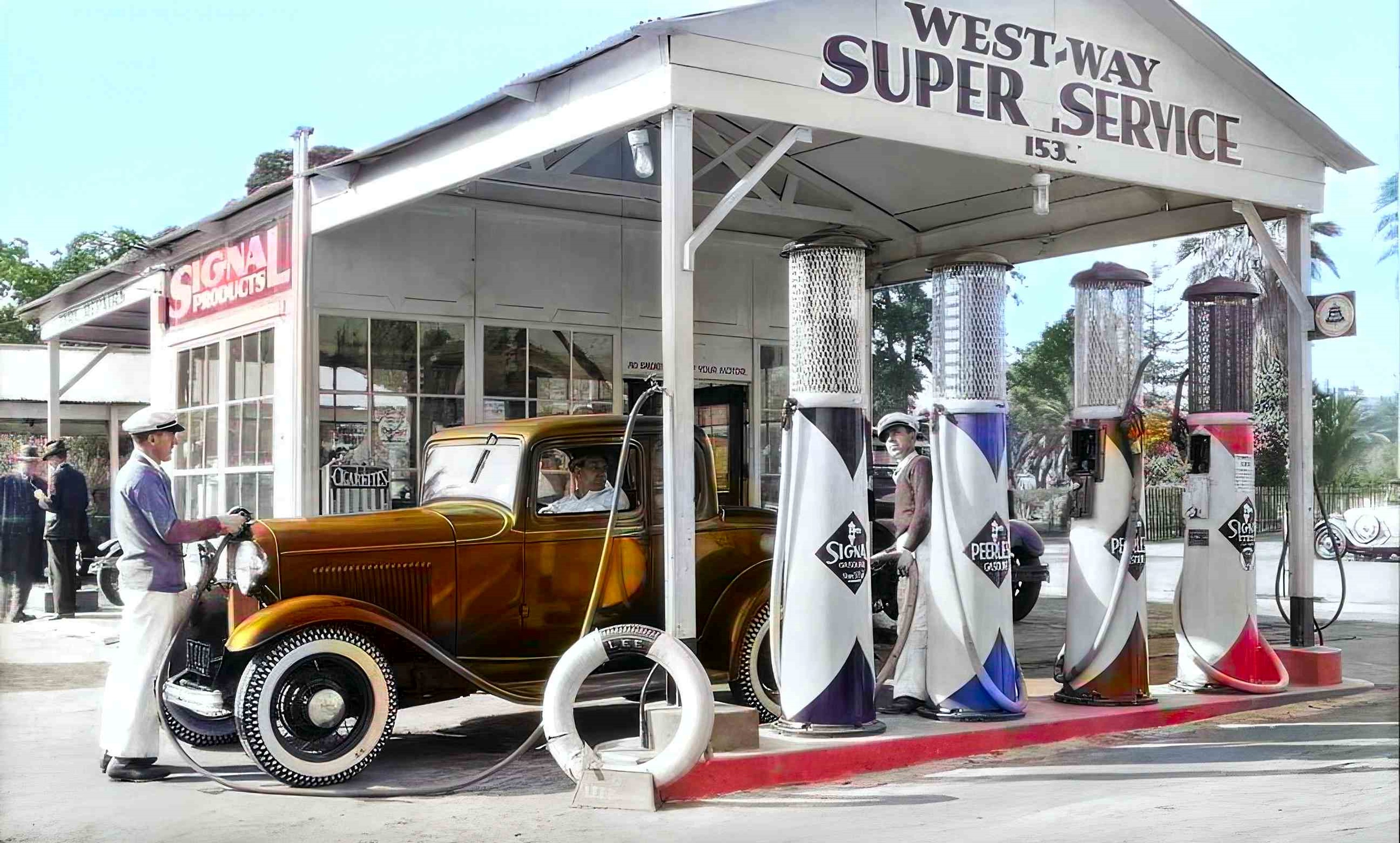 |
|
| (1933)* - Two attendants provide full service on a 1932 Ford V-8, five window coupe at the pump of the West-Way Super Service Station at 1535 N. Western Avenue. Image enhancement and colorization by Richard Holoff. |
.jpg) |
|
| (1933)* - Close-up view showing the four pumps at the West-Way Super Service Station, dispensing three grades of Signal fuel. |
* * * * * |
Standard Gas Station (Sunset Strip)
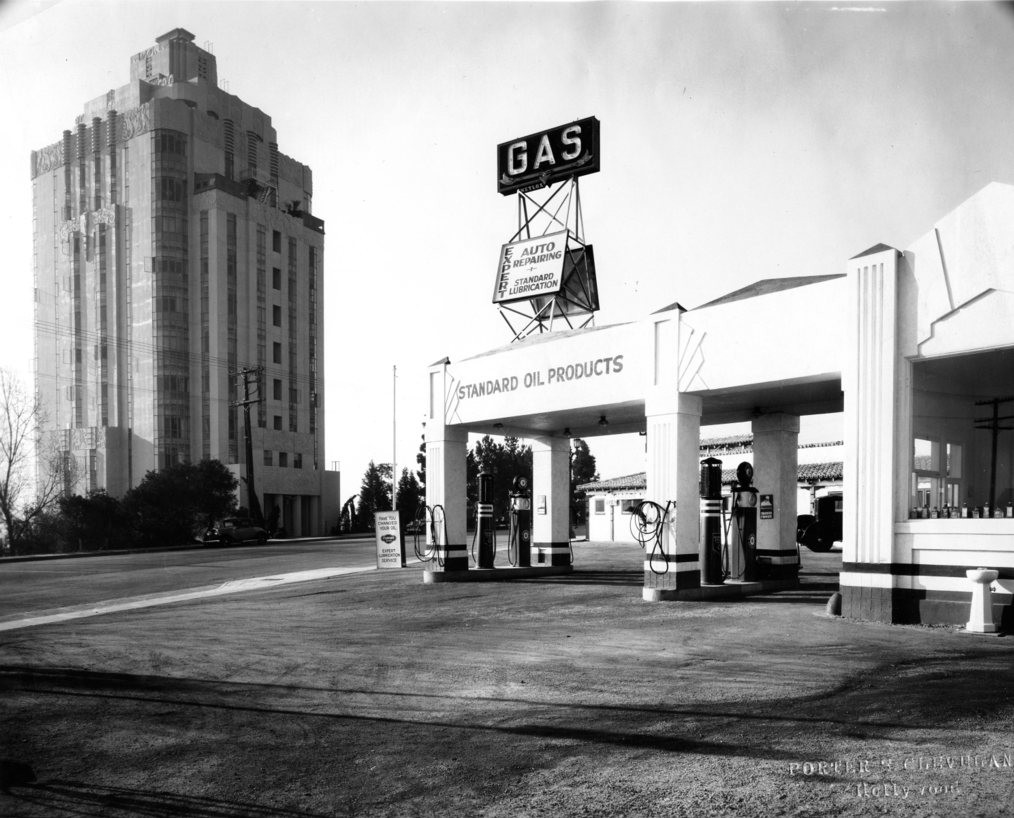 |
|
| (1933)^^ - View showing a Standard gas station on the 8300 block of Sunset Boulevard with the Sunset Tower Apartments in the background. |
* * * * * |
Sixth and Westmoreland Service
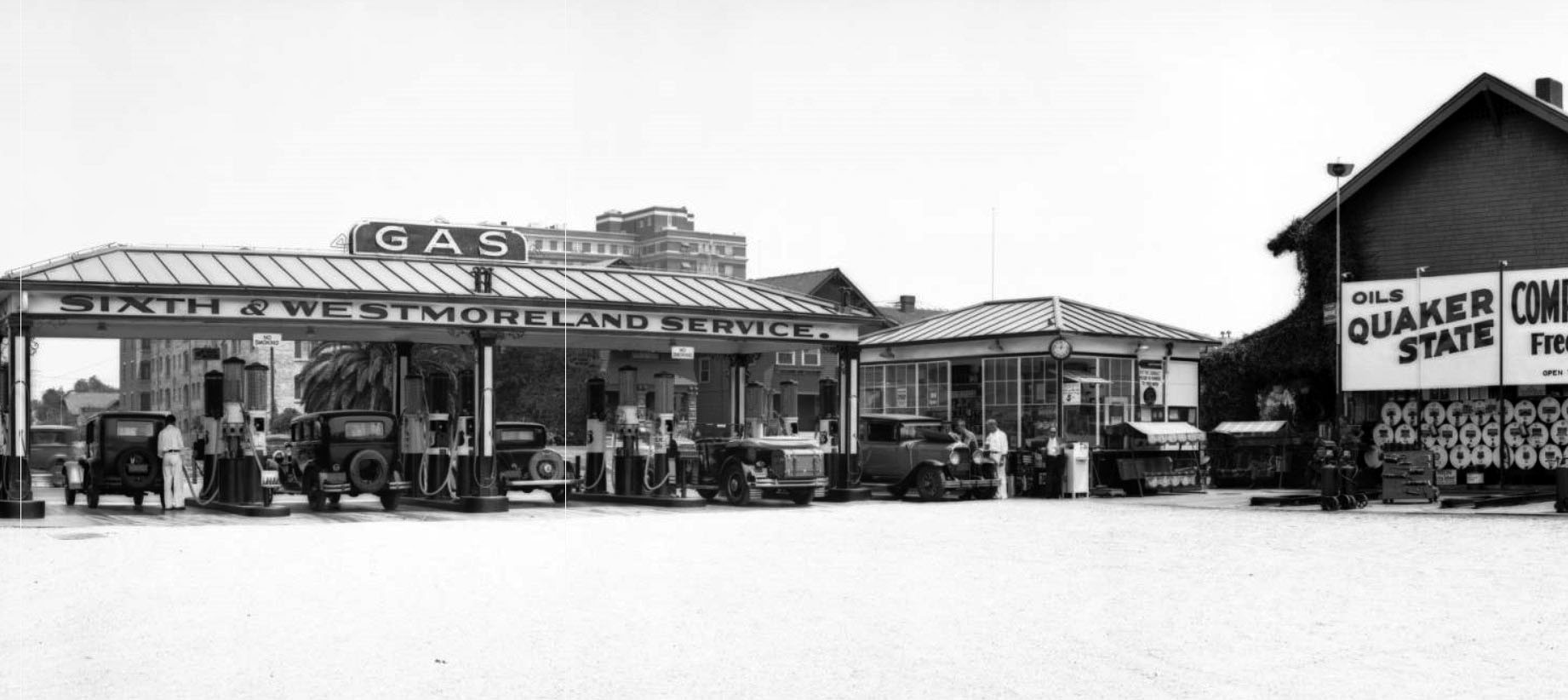 |
|
| (1930s)^^ - View showing a Service Station located at 6th Street and Westmoreland Avenue, Los Angeles. |
* * * * * |
Hancock Oil Gas Station (San Pedro)
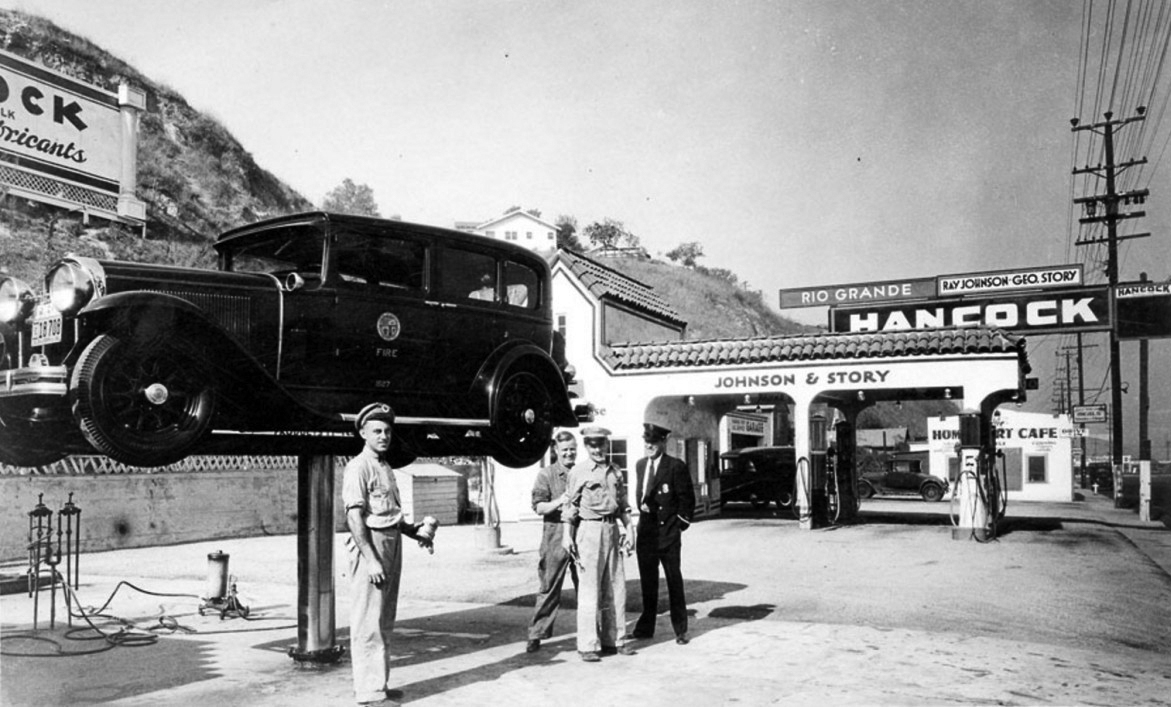 |
|
| (1930s)**^ – View showing the Hancock Oil Gas Station located at 837 North Pacific Avenue in San Pedro. It was owned by Ray Johnson and George Story. The car on the rack (1930 Buick) is a City of Los Angeles Fire Department vehicle and has the number 1527 on the door. The Homeport (?) Cafe is seen in the distance. |
Historical Notes The two-story service station and office was demolished in 1966. Today, J & J Body Shop exists where the service station once stood. Click HERE to see contemporary view. HANCOCK Oil Company was headquartered in Los Angeles. In the 1850’s, lawyer Henry Hancock helped the Rocha family establish their legal claim to Rancho La Brea, but they ended up owing him so much in fees that they gave him part of the rancho in payment. In 1860 Hancock and his brother bought the rest of the rancho. Hancock began to sell asphalt produced from the famous tar pits that gave the rancho its name. This was the beginning of the Hancock Oil Company. In 1885 Hancock’s widow leased part of the rancho to eastern oil men who went bust by 1888. But in 1902, Mrs. Hancock leased part of the rancho to the Salt Lake Oil Company, which proved a great success. Henry Hancock’s son, George A. Hancock, who had learned the oil business working for Salt Lake, established his own company in 1906. By February 1907, he had over 70 wells producing nearly 300 barrels a day, making the Hancocks one of California’s wealthiest families. The Hancock family built Hancock Park, a large upscale apartment community. The Hancock Oil Company was sold to Signal Oil in 1958. The 1965 Signal was sold to Humble, and both the Hancock and Signal brands vanished.* |
* * * * * |
Standard Gas Station (Western and 8th)
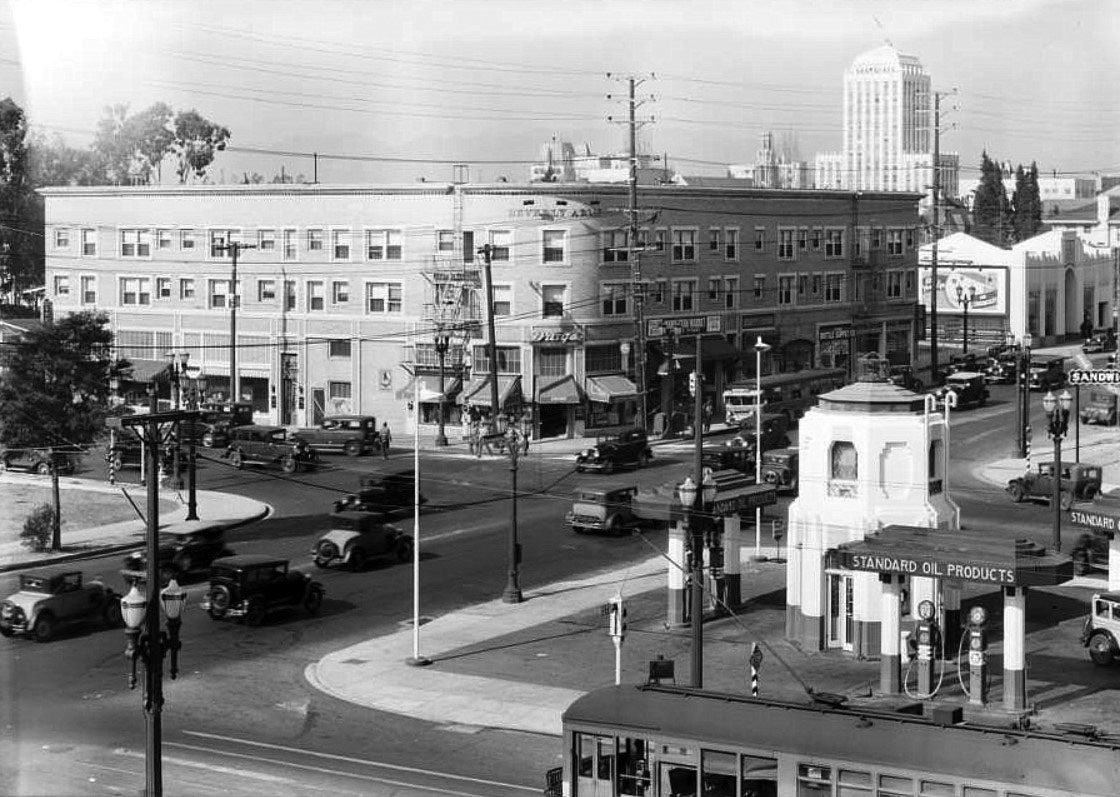 |
|
| (1931)^^ – View looking northwest showing a Standard Gas Station located on the southeast corner of Western Avenue and 8th Street. Note the Art-deco tower structure at center of gas station. The large building across the street is the Beverly Arms Building. In the distance can be seen the 13-story Wilshire Professional Building. |
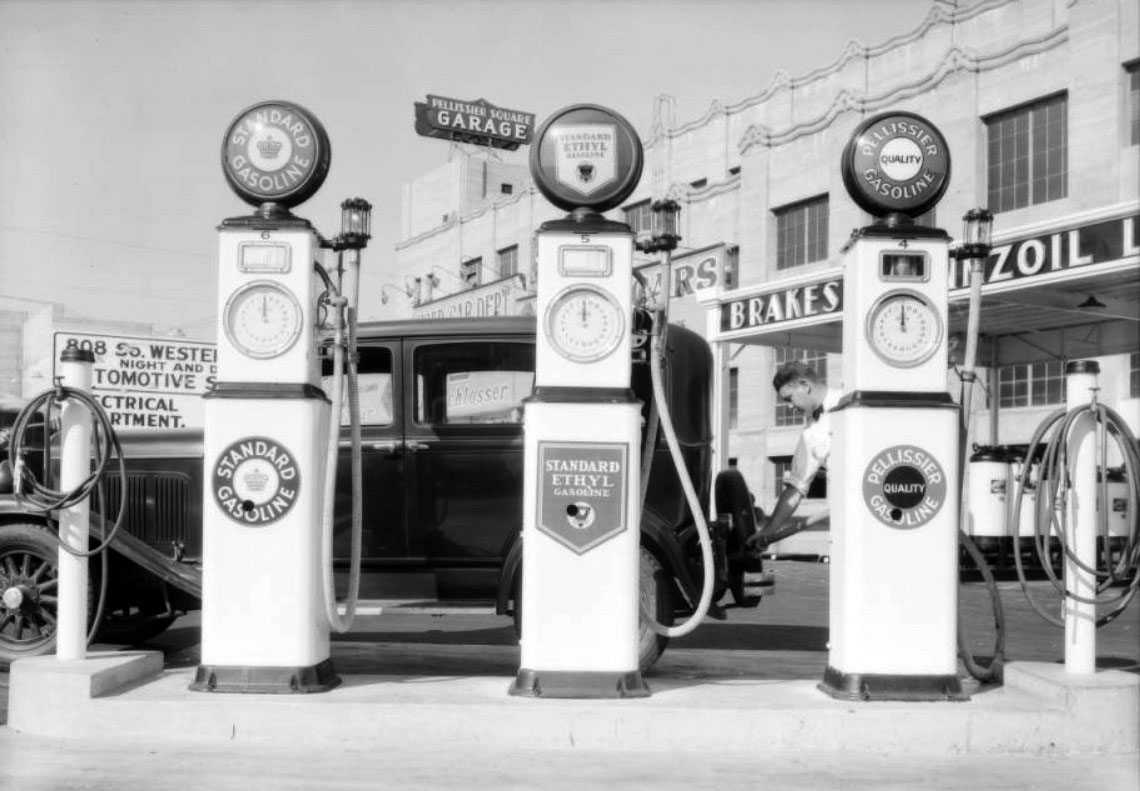 |
|
| (1931)^^ – View of the Pellissier Square Garage located at 828 South Western Avenue, offering three grades of gasoline: Standard, Standard Ethyl, and Pellissier Quality. Photo by Dick Whittington |
* * * * * |
Pyroil Service Station (Pasadena)
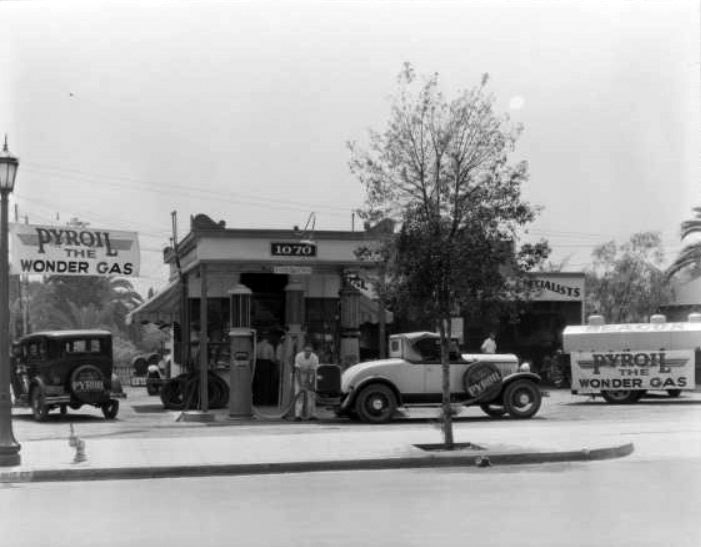 |
|
| (1932)#* - Street view of the Pyroil Service Station at 1070 East Walnut. An automobile with a spare wheel cover advertising for Pyroil is being refueled at one of the three pumps in front of the building. Signs and banners advertise for "Pyroil the wonder gas". |
Historical Notes The Pyroil brand is a trademarked name for a line of automotive chemicals offered today by the Ashland Oil Company. But in 1932, it was also a brand of gasoline that was being heavily promoted. The roadster looks like a 29 Chrysler Series 75. 1070 E. Walnut in Pasadena is still there and today is an automobile repair shop. Click HERE for contemporary view. |
* * * * * |
Union Oil Service Station
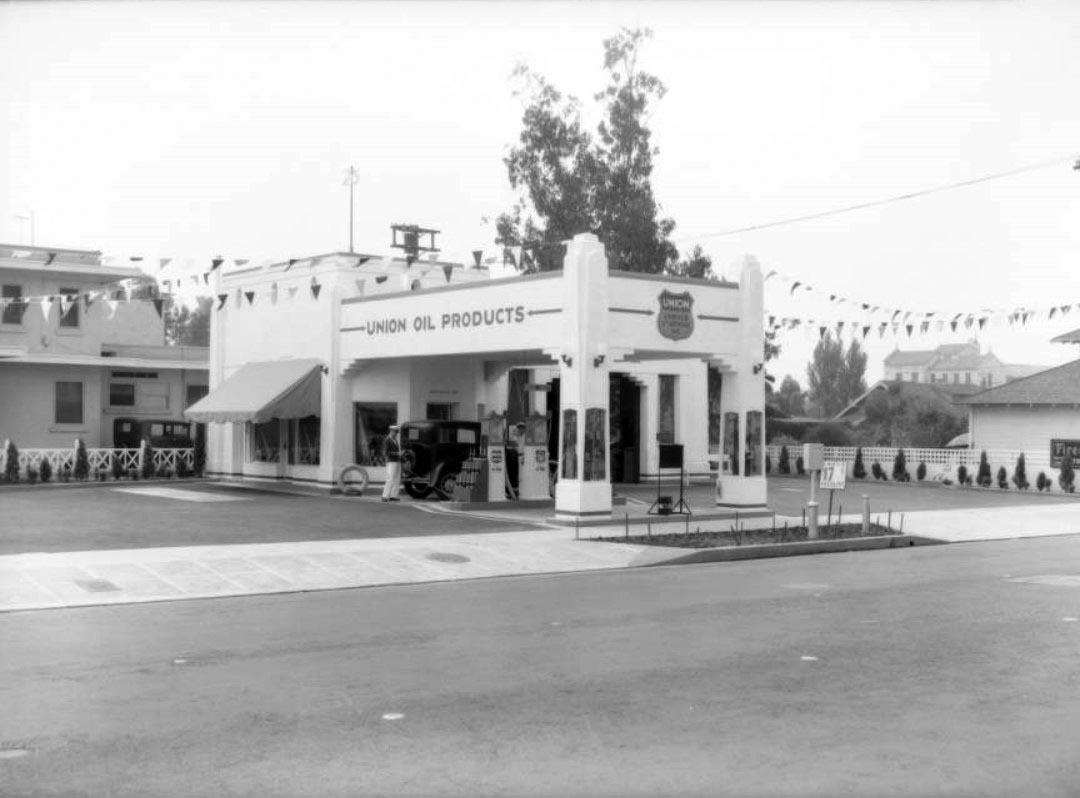 |
|
| (1933)^^ – View showing a Union Oil Service Station located on the corner of 8th Street and Western Avenue with 17¢ gasoline. |
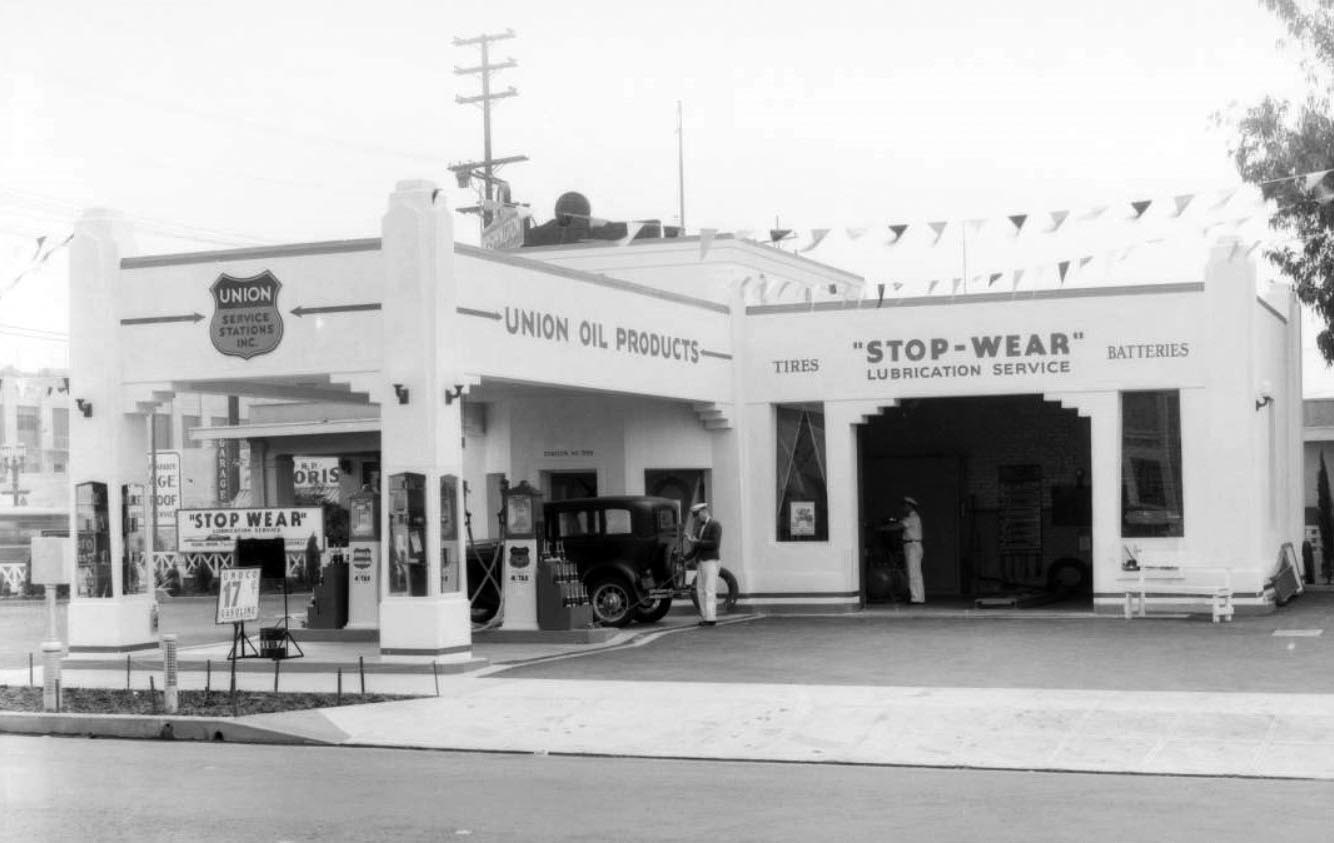 |
|
| (1933)^^ – Close-up view of the same Union Service Station Avenue showing an attendant servicing a car while another is in an open bay with sign overhead reading: “Stop-Wear” Lubrication Service. |
* * * * * |
Union 76 (La Cienega and Olympic)
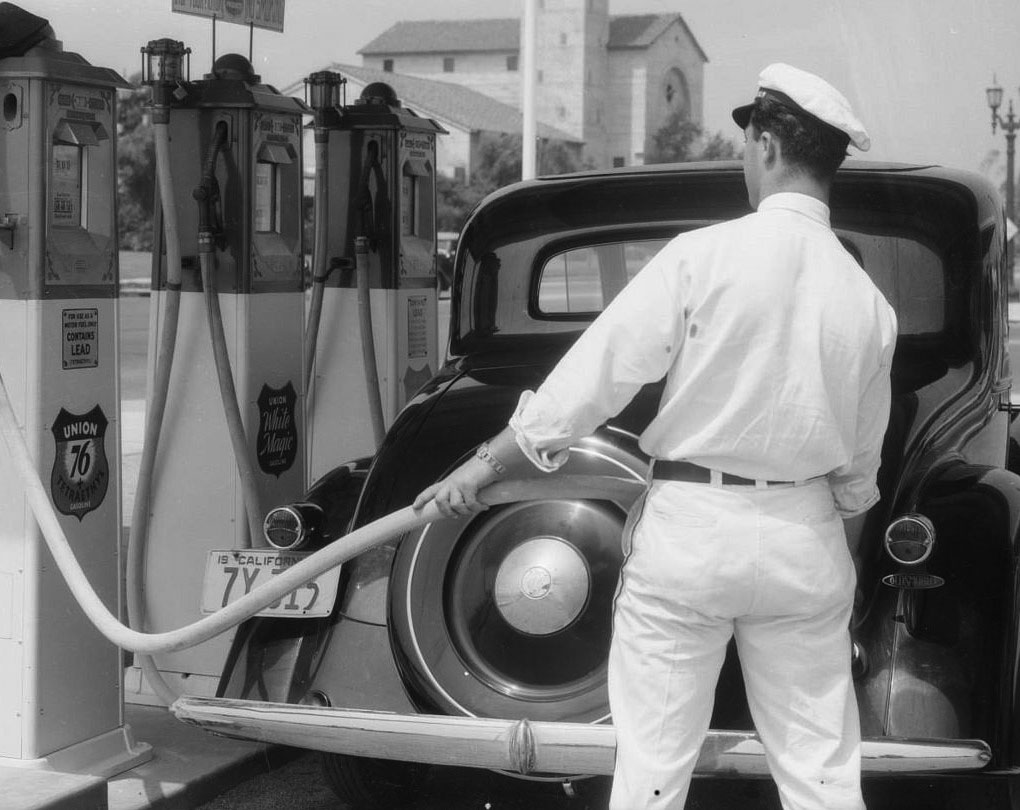 |
|
| (1934)* – View looking north showing an attendant pumping gas at a new Union 76 service station located on the southeast corner of La Cienega and Olympic Blvds. The Beverly Hills Water Treatment Plant is seen in the background. A Sinclair gas station still is on the same corner today. Click HERE for contemporary view. |
Historical Notes The former Beverly Hills Water Treatment Plant, now the Fairbanks Center for Motion Picture Study, played a crucial role in preserving Beverly Hills’ independence at a time when Los Angeles pressured the city to consolidate for access to water. Completed in 1928 and designed by civil engineer Arthur Taylor, the Romanesque-style structure resembled a church, with a Moorish-inspired tower housing the water purification system. Its industrial purpose was subtly revealed through features like machinery visible behind a large rose window, while the landscaped grounds gave it the look of a public park. Today, after a successful preservation effort and adaptive reuse, the building serves as a research library and film archive for the Academy of Motion Picture Arts and Sciences. |
* * * * * |
Union 76 (Adams and Figueroa)
.jpg) |
|
| (1934)* – View looking at the St. Vincent Catholic Church as seen from a Union 76 service station located on the NE corner of West Adams Boulevard and South Figueroa Street. |
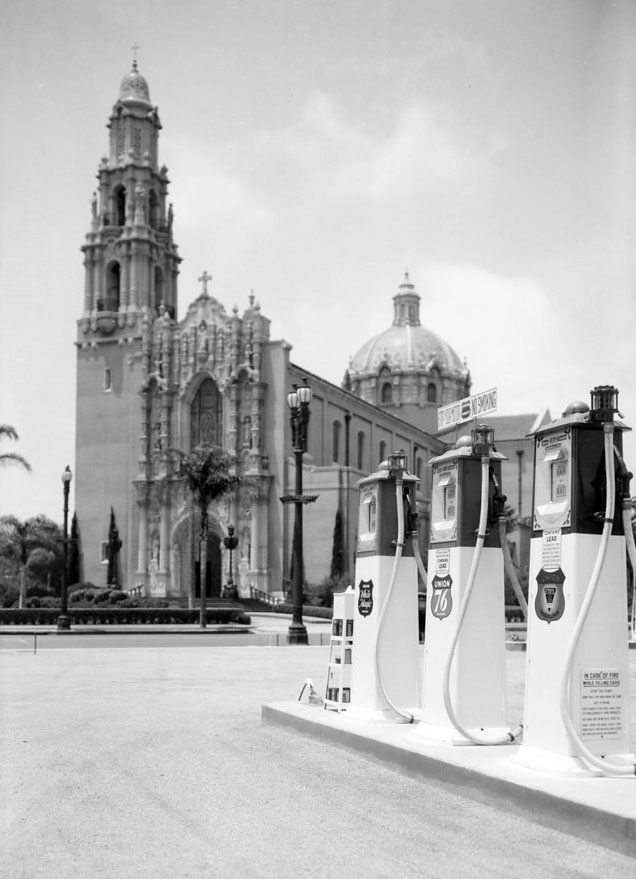 |
|
| (1934)* - Union 76 pumps and St. Vincent Church, West Adams Boulevard and South Figueroa Street. |
.jpg) |
|
| (1934)* - Close-up view of Union 76 service station pumps with St. Vincent Church seen in the background. |
* * * * * |
Union 76 (Santa Monica)
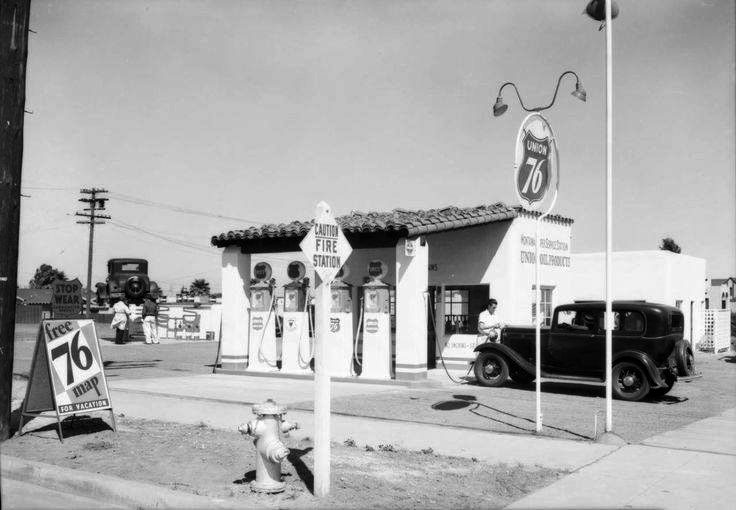 |
|
| (1933)* – View showing a full service Union 76 Gas Station in Santa Monica offering a “free 76 map”. In the distance two men inspect the undercarriage of a car. |
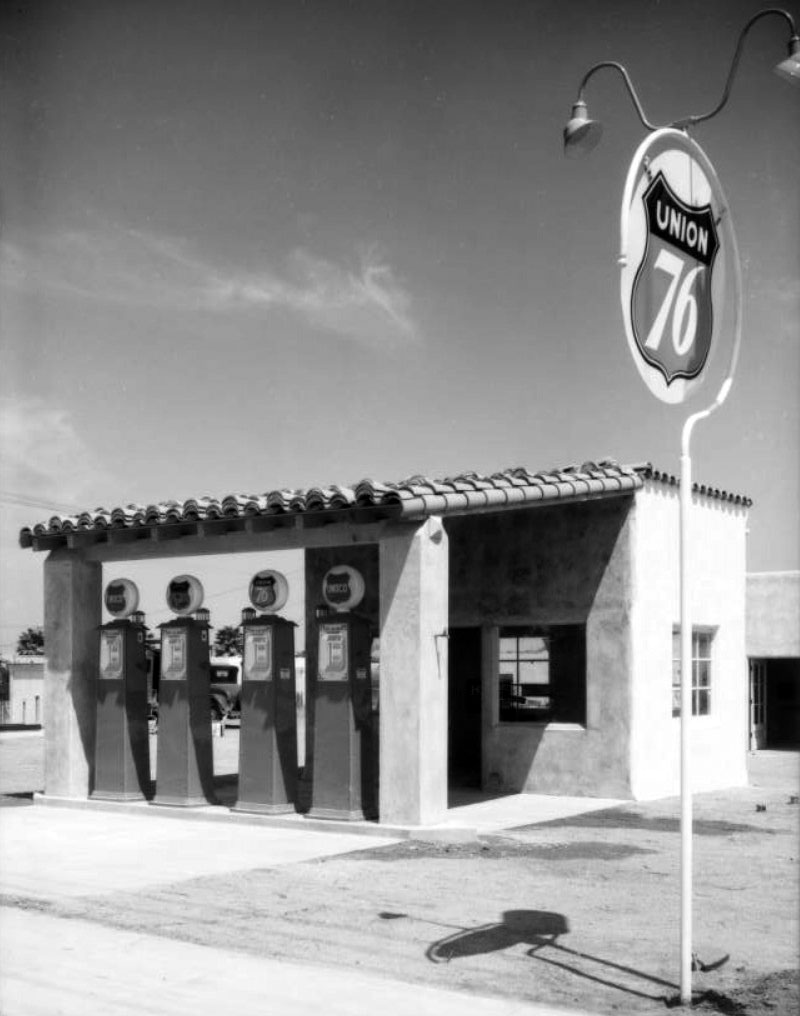 |
|
| (1933)* – Closer view of the same Union 76 Station seen in previous photo. Note that there is no signage on the side of the builting which might indicate the station was just built. Location: 1802 Montana Street in Santa Monica. |
* * * * * |
Victory Super Service Station (Burbank)
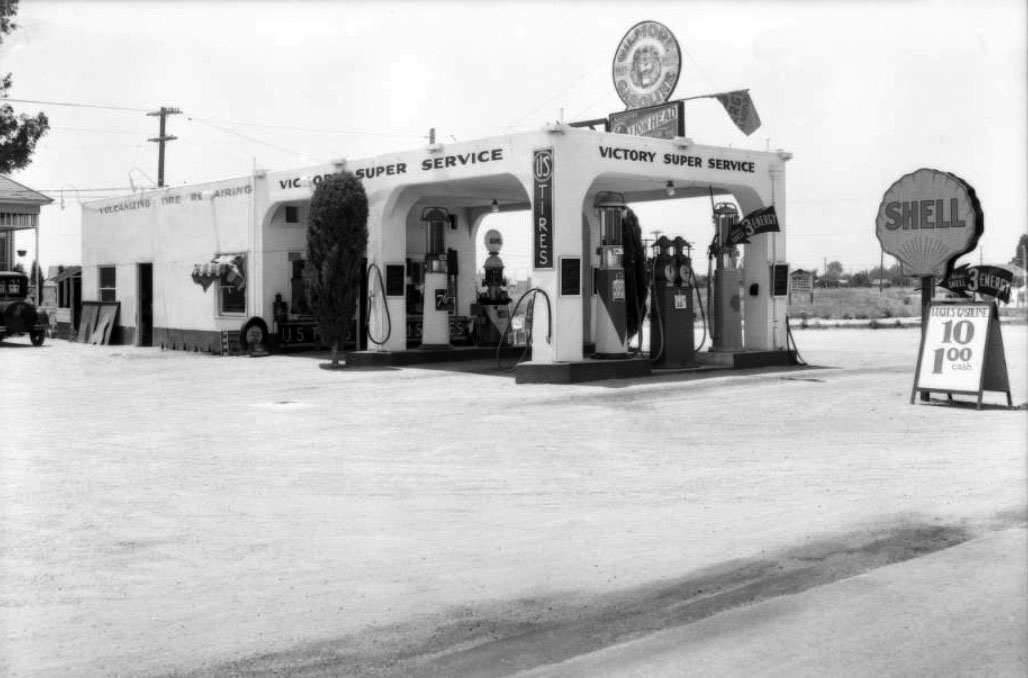 |
|
| (1932)* – View showing the Victory Super Service Shell Station located at the intersection of South Victory Boulevard and West Providencia Avenue, in Burbank. Sign reads 10 Gallons for $1 Cash. |
* * * * * |
Howe's Service Station
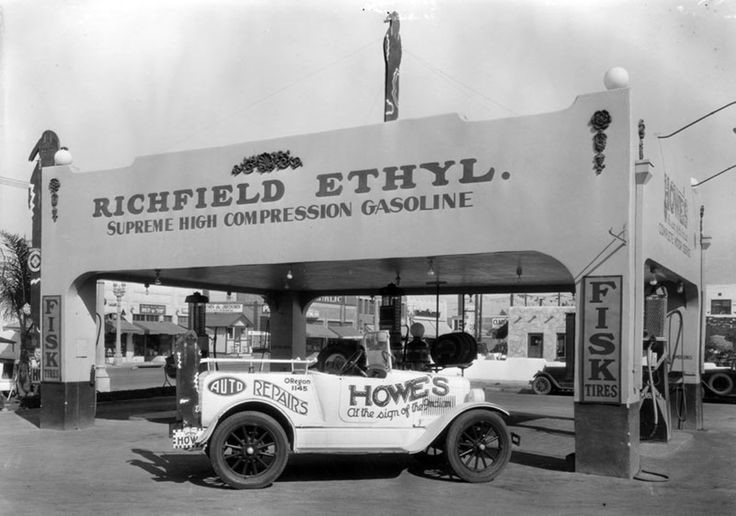 |
|
| (ca. 1930)^ - View showing Howe's Service Station selling Richfield Ethyl Supreme High Compression Gasoline, located at 7456 Melrose Avenue. |
Historical Notes Howe’s newspaper ad reads: HOWE’S “AT THE SIGN OF THE INDIAN” (Leon D. Howe) Complete Motor Service, 7456 Melrose Ave, at Vista St., Tel Oregon 1145. **^ |
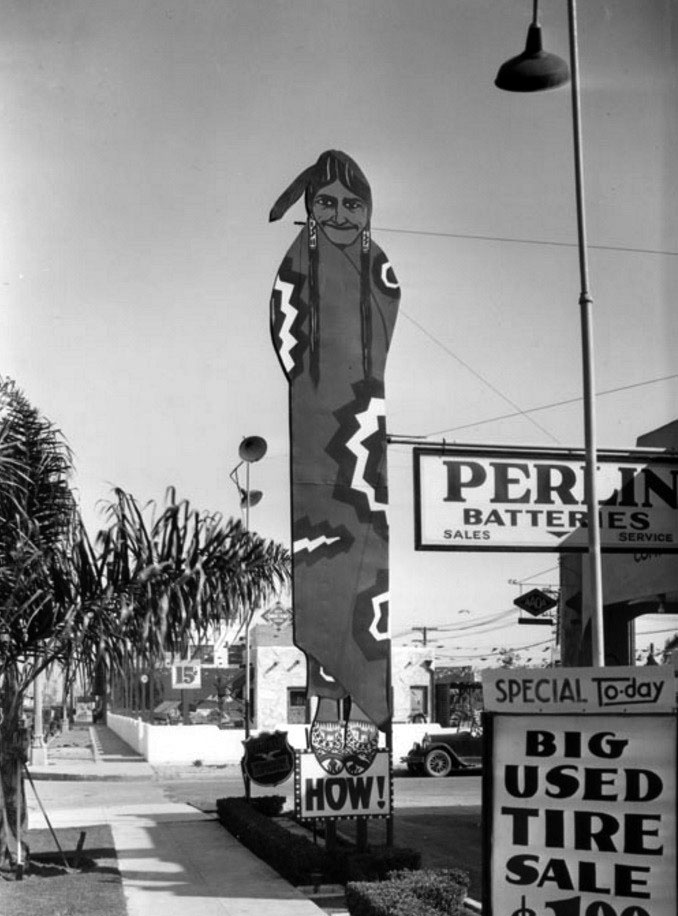 |
|
| (1930)**^ – View showing the sign in front of Howe’s Service Station located on the southwest corner of Melrose Avenue and Vista Street. |
* * * * * |
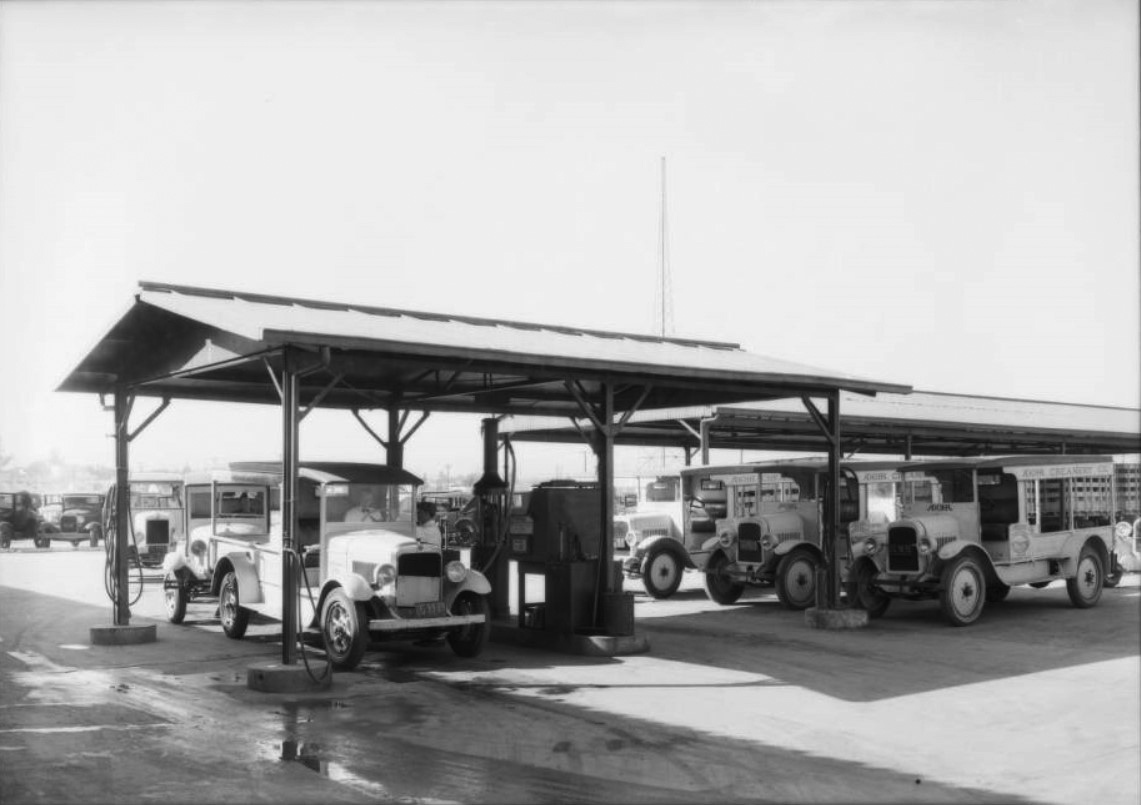 |
|
| (1933)^^ – View showing a Service Station located at the Adohr Creamery at 1801 La Cienega Blvd. |
Historical Notes Merritt Adamson established a dairy business in the San Fernando Valley, in Tarzana, known as Adohr Farms, the name representing his wife's name spelled backwards. The business became one of the country's largest dairies, operating one of the largest herds of Guernsey cows in the world.*^^ |
* * * * * |
Signal Oil Station (Broadway and 15th)
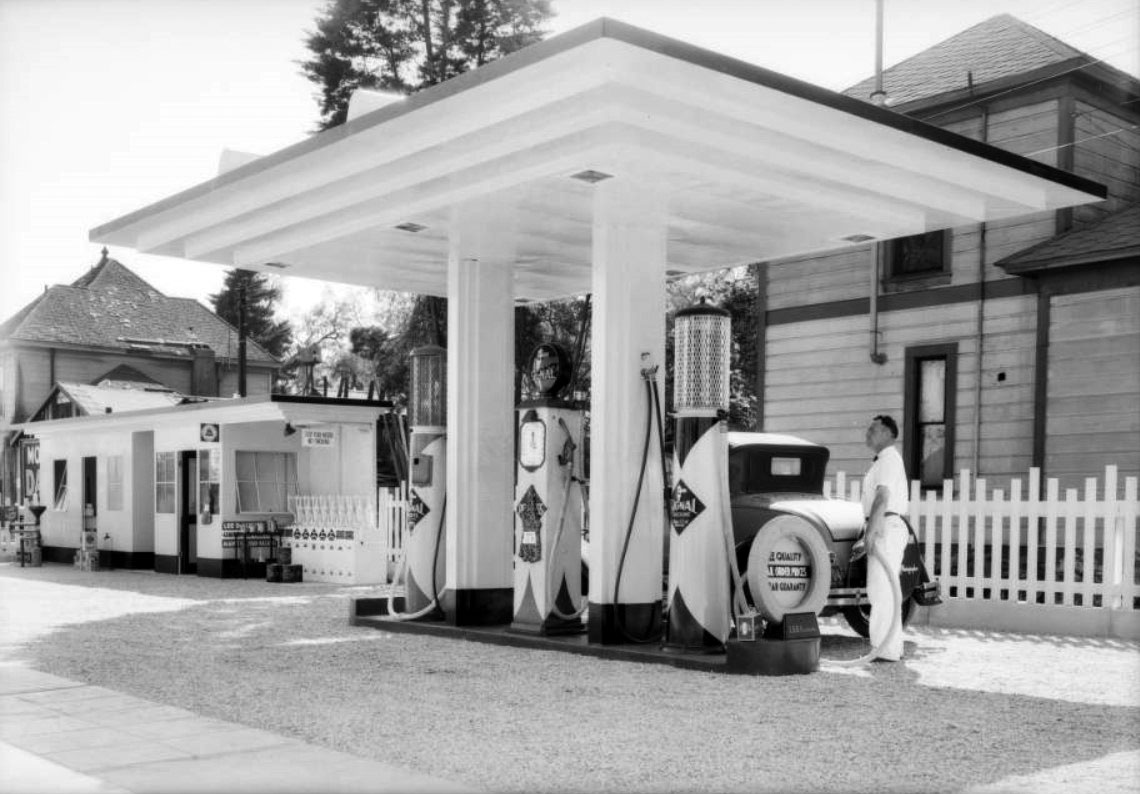 |
|
| (1933)^^ - View showing a Signal Oil Station, located on West 15th Street and South Broadway, in what appears to be a residential area. |
Historical Notes Signal Gasoline Company was founded by Samuel B. Mosher in 1922. It renamed itself to Signal Gas & Oil in 1928 to reflect its expanding businesses; by the 1950s, Signal was the largest independent oil company on the West Coast of the United States and Mosher held large stakes in American President Lines and Flying Tiger Line. In 1964, Signal merged with the Garrett Corporation, an aerospace company, and the combined company adopted "The Signal Companies" as its corporate name in 1968.*^^ |
* * * * * |
Union 76 Station (3rd and Serrano)
 |
|
| (1933)^^ – Banners hang from the rooftop of the new Union 76 gas station located at the corner of West 3rd Street and Serrano Avenue. |
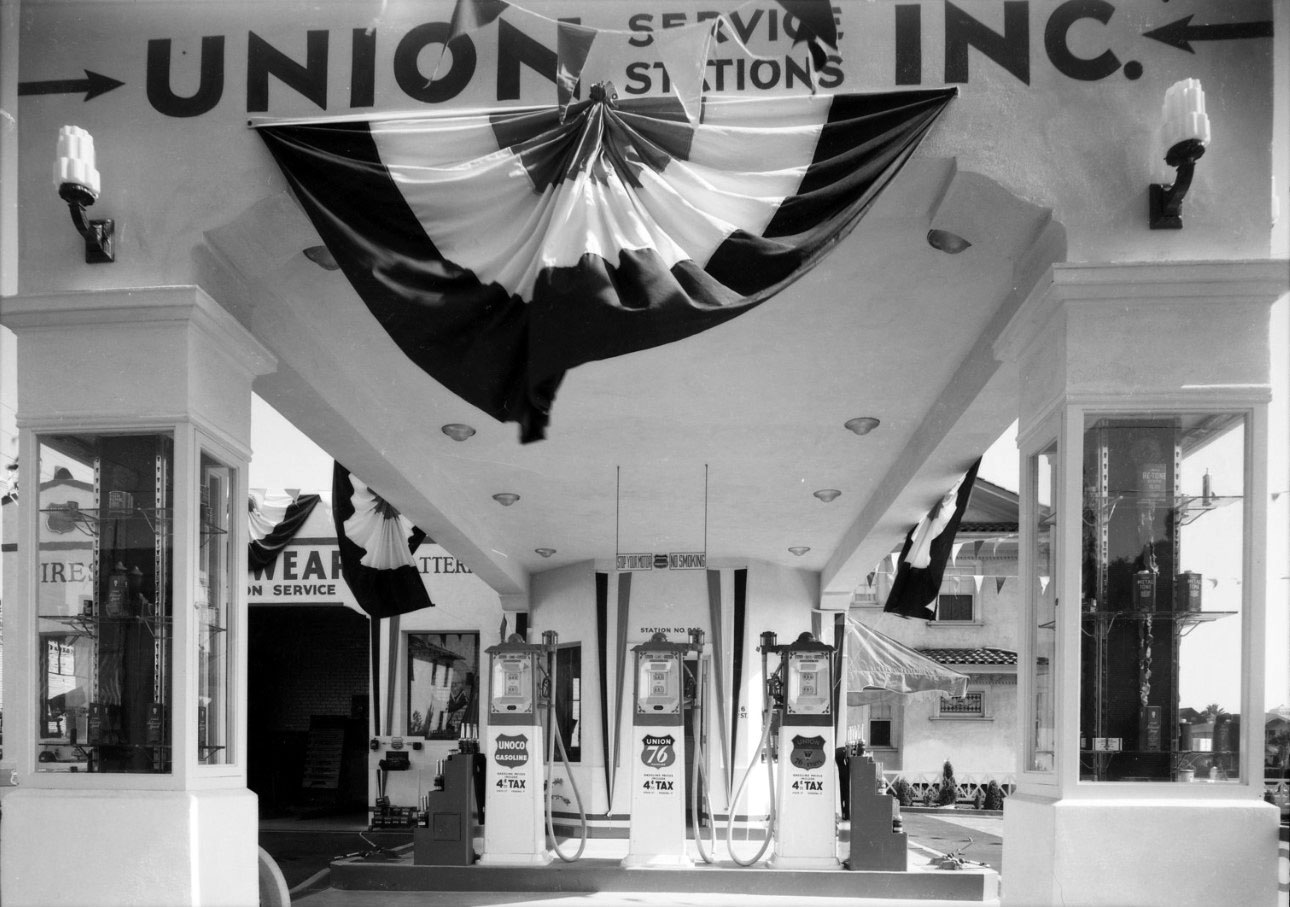 |
|
| (1933)^^ – Close-up front view of the new Union 76 station at 3rd Street and Serrano Avenue. Note how the display cases are used as load-bearing posts for the gas station’s canopy. |
* * * * * |
Please Support Our CauseWater and Power Associates, Inc. is a non-profit, public service organization dedicated to preserving historical records and photos. Your generosity allows us to continue to disseminate knowledge of the rich and diverse multicultural history of the greater Los Angeles area; to serve as a resource of historical information; and to assist in the preservation of the city's historic records.
|
More Historical Early Views
Newest Additions
Early LA Buildings and City Views
History of Water and Electricity in Los Angeles
* * * * * |
References and Credits
^ LA Public Library Image Archive
*^ Oviatt Library Digital Archives
^* History of the Gas Station: woip.blogspot.com
#* Huntington Digital Library Archive
+# Flickr.com: Michael Ryerson
** LA Magazine: Jack Colker's 76 Station
++# Facebook.com: Photos of Los Angeles
#** Real Buildings that Inspired Disney-MGM Studios
^^#LA Curbed
#^# Pyroil - The Wonder Gas: theoldmotor.com
#^^Facebook.com: Classic Hollywood/Los Angeles/SFV
+#+Facebook.com: Garden of Allah Novels
^x^Facebook.com: Photos of Los Angeles
*x^Facebook.com: Beverly Hills Heritage
^x*Facebook.com: So. Calif. Historic Arrchitecture
^v^My Love of Old Hollywood - A Quick Tour of Beverly Hills
^*^ Gilmore Gasoline Filing Station
**^ Noirish Los Angeles - forum.skyscraperpage.com; Bob's Airmail Service Station; Anandale-Rockdale Station; Muller Bros. Service Station; Howe's Service Station; Jack Cocker 76 Station
*^^ Wikipedia
^^^ Los Angeles Conservancy: Union 76 Station
^^* The Old Motor
**^*California State Library Image Archive
****Pinterest.com: Gilmore Self-Service Gas Station
***^Pomona Public Library Digital Archive: Bob's Airmail Service Station
***#Pinterest: Art Deco - Sears Building; Standard Station
*^^*Pinterest.com: Bertrand Lacheze
*^#^Huntington Digital Library Archive
^*^#Facebook.com - Bizarre Los Angeles
#^*^Facebook.com: West San Fernando Valley Then And Now
##++Facebook.com - Beverly Hills Heritage
< Back
Menu
- Home
- Mission
- Museum
- Major Efforts
- Recent Newsletters
- Historical Op Ed Pieces
- Board Officers and Directors
- Mulholland/McCarthy Service Awards
- Positions on Owens Valley and the City of Los Angeles Issues
- Legislative Positions on
Water Issues
- Legislative Positions on
Energy Issues
- Membership
- Contact Us
- Search Index